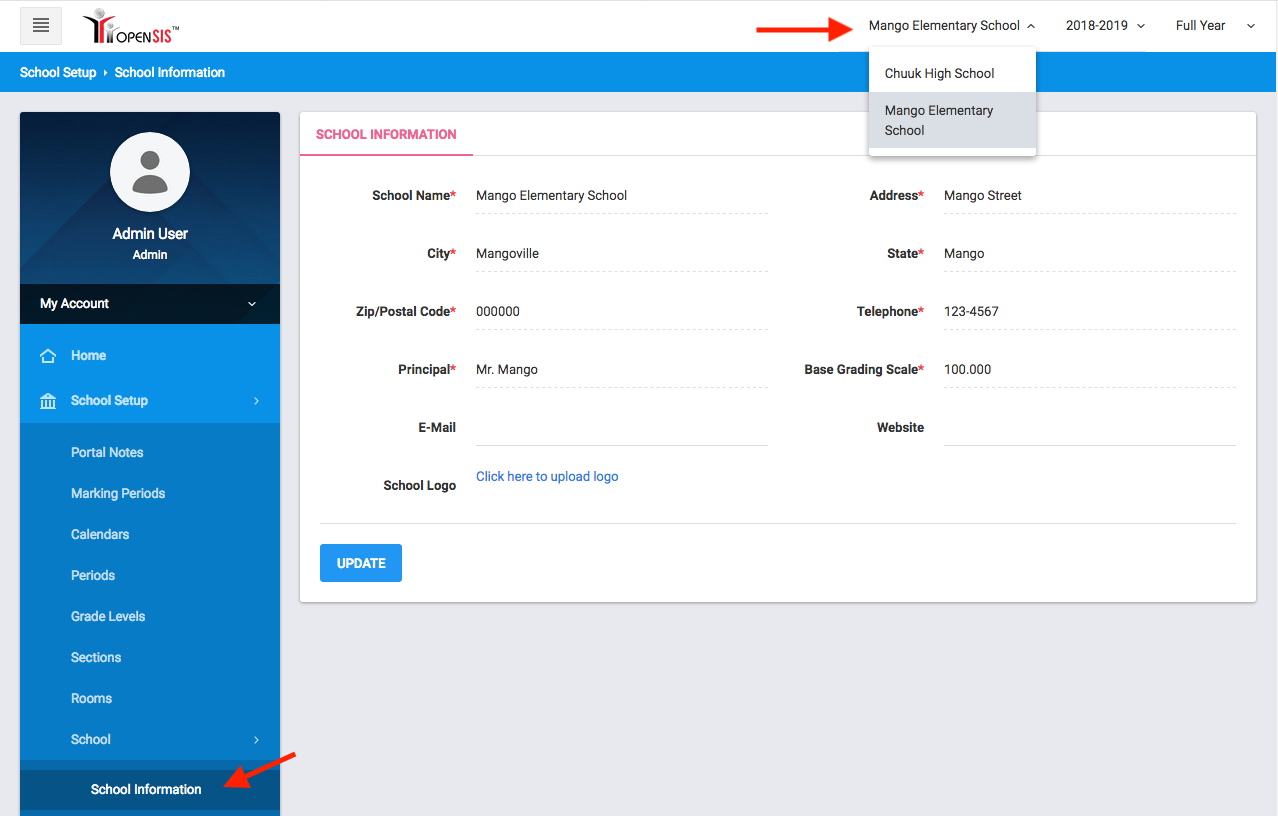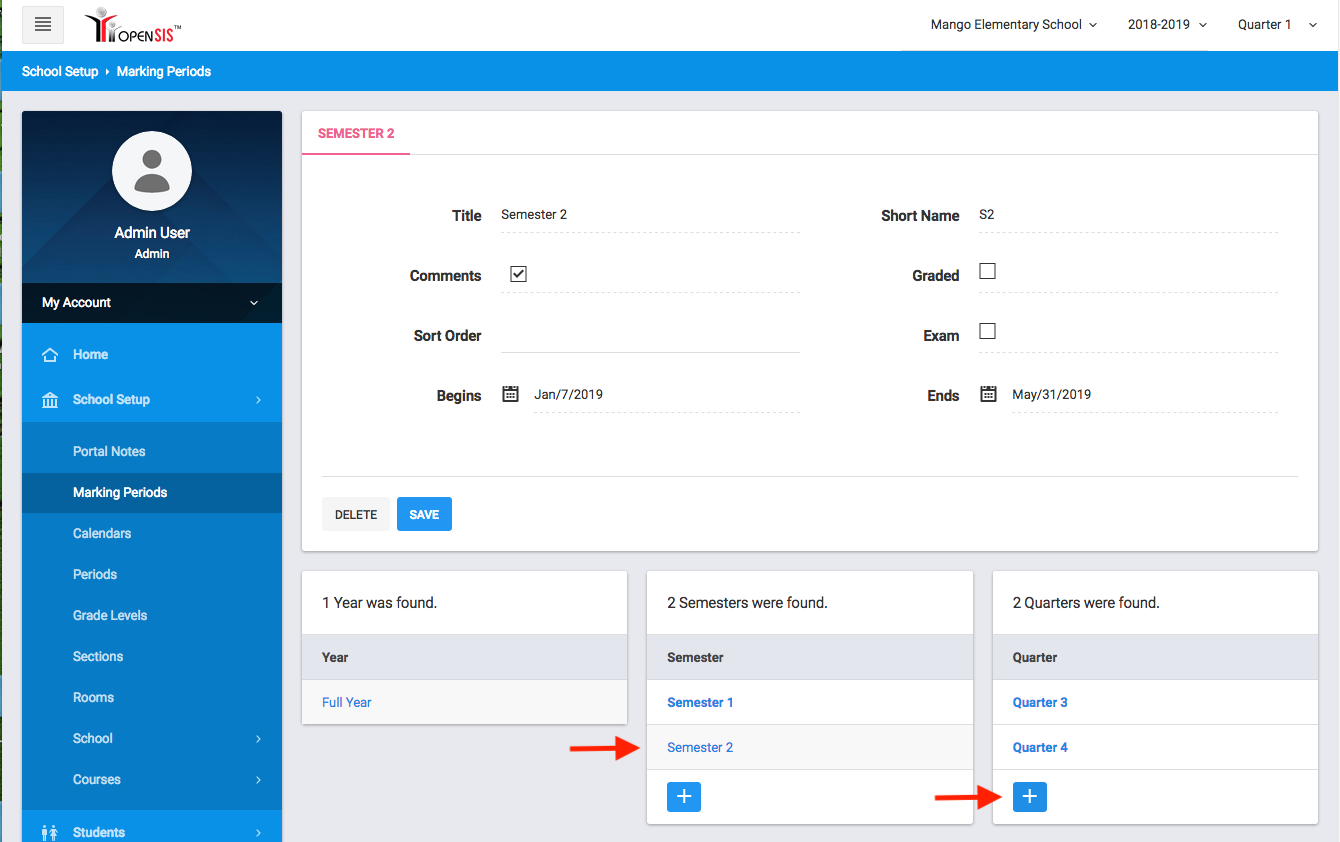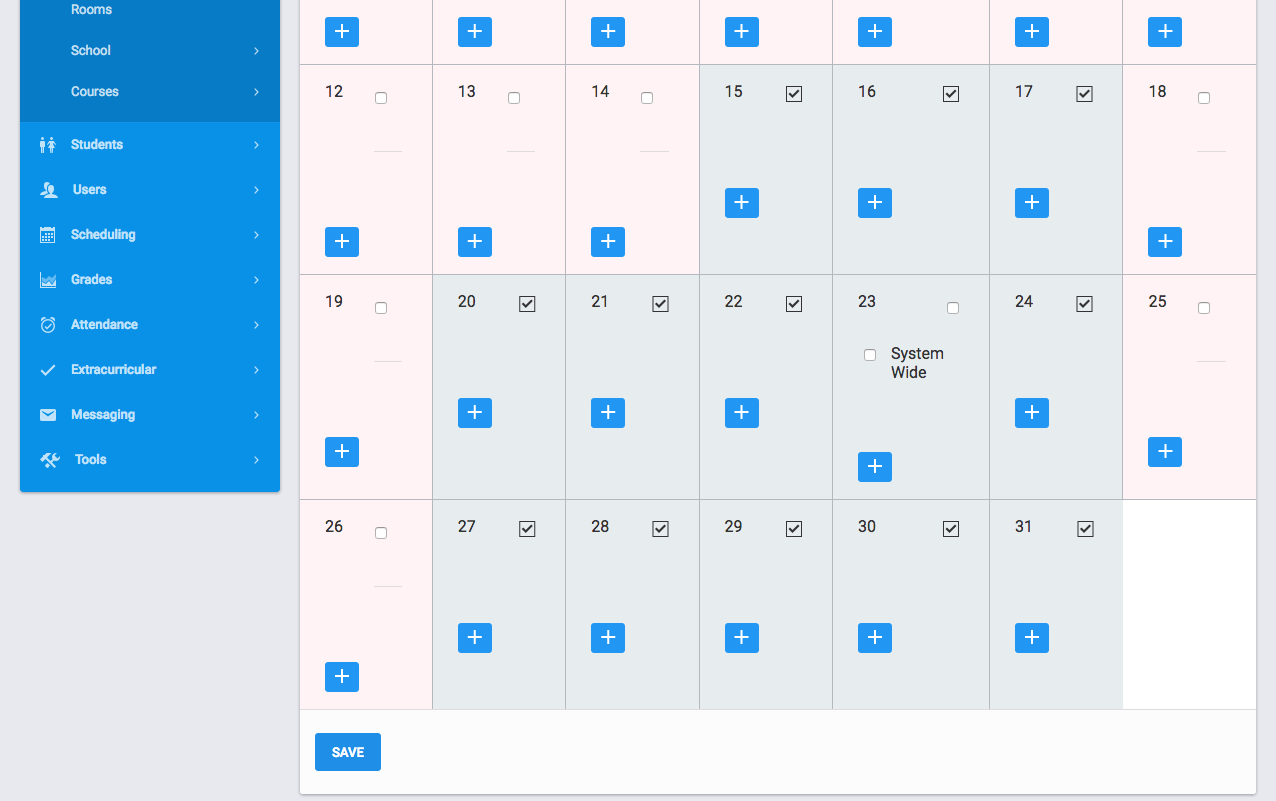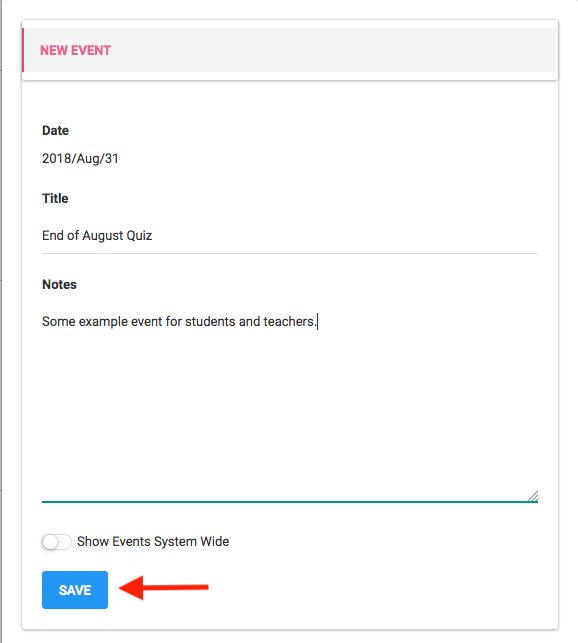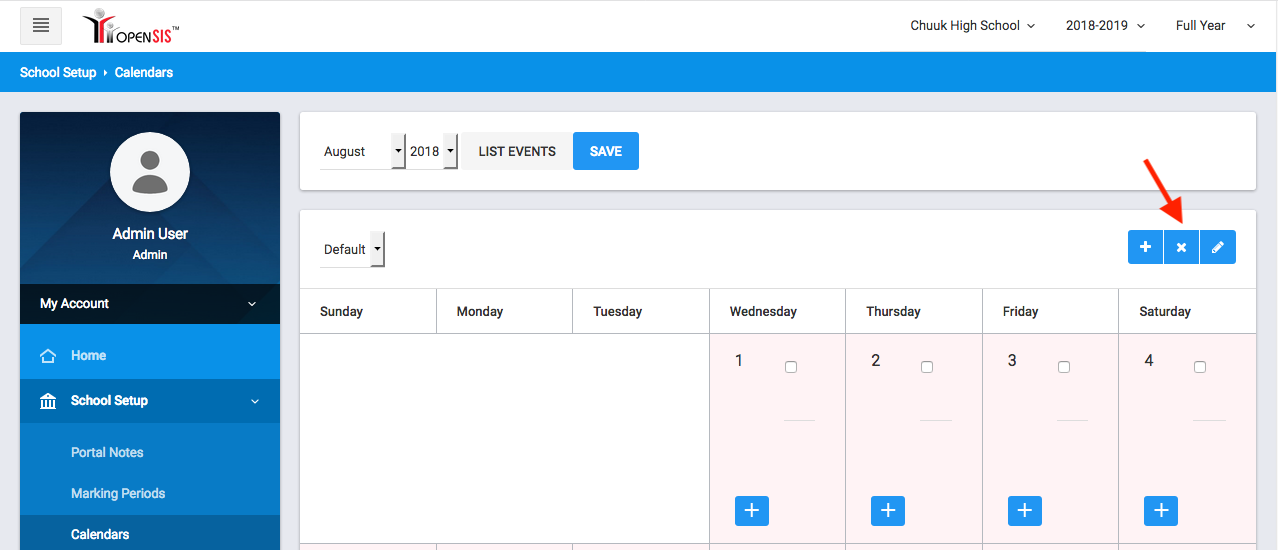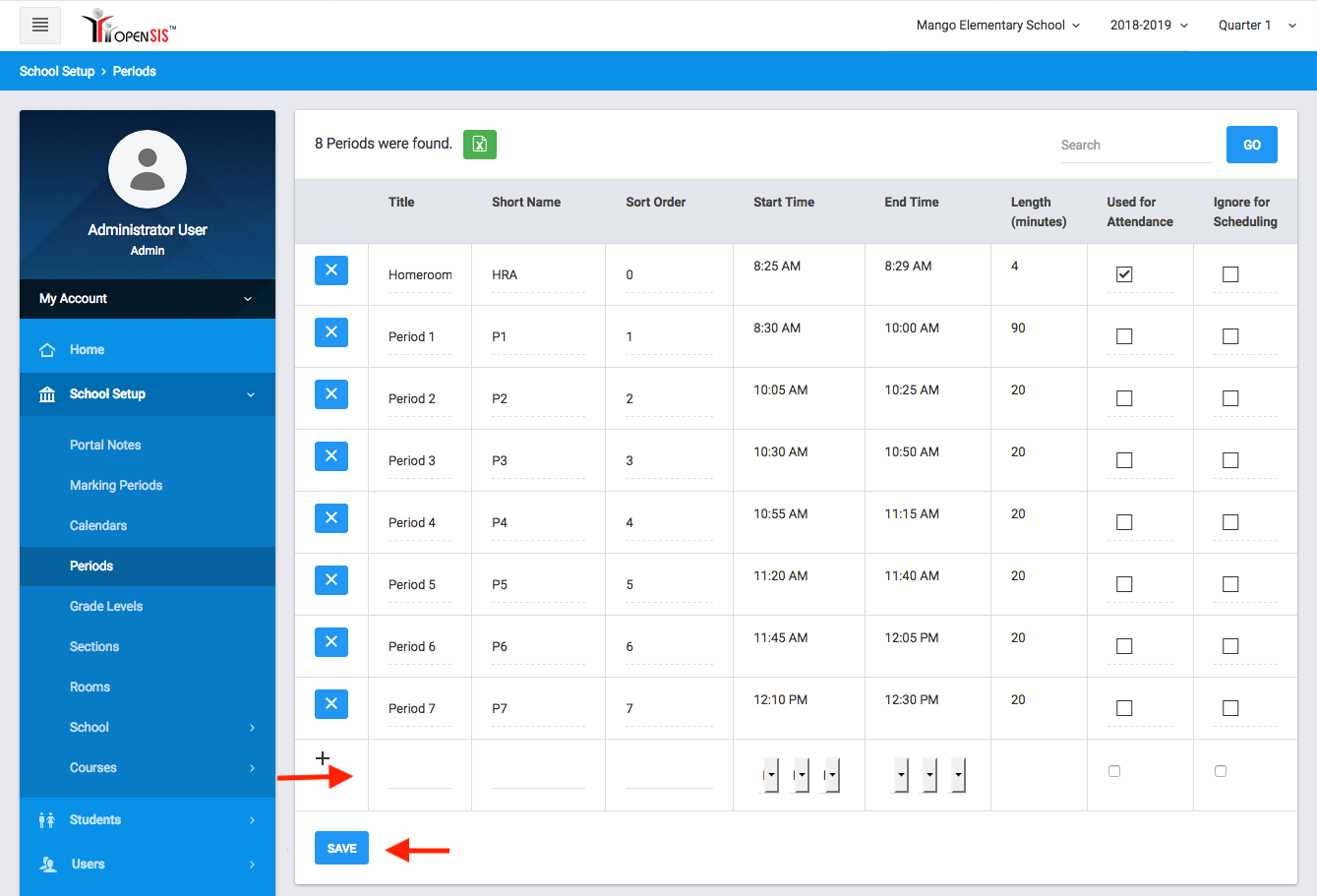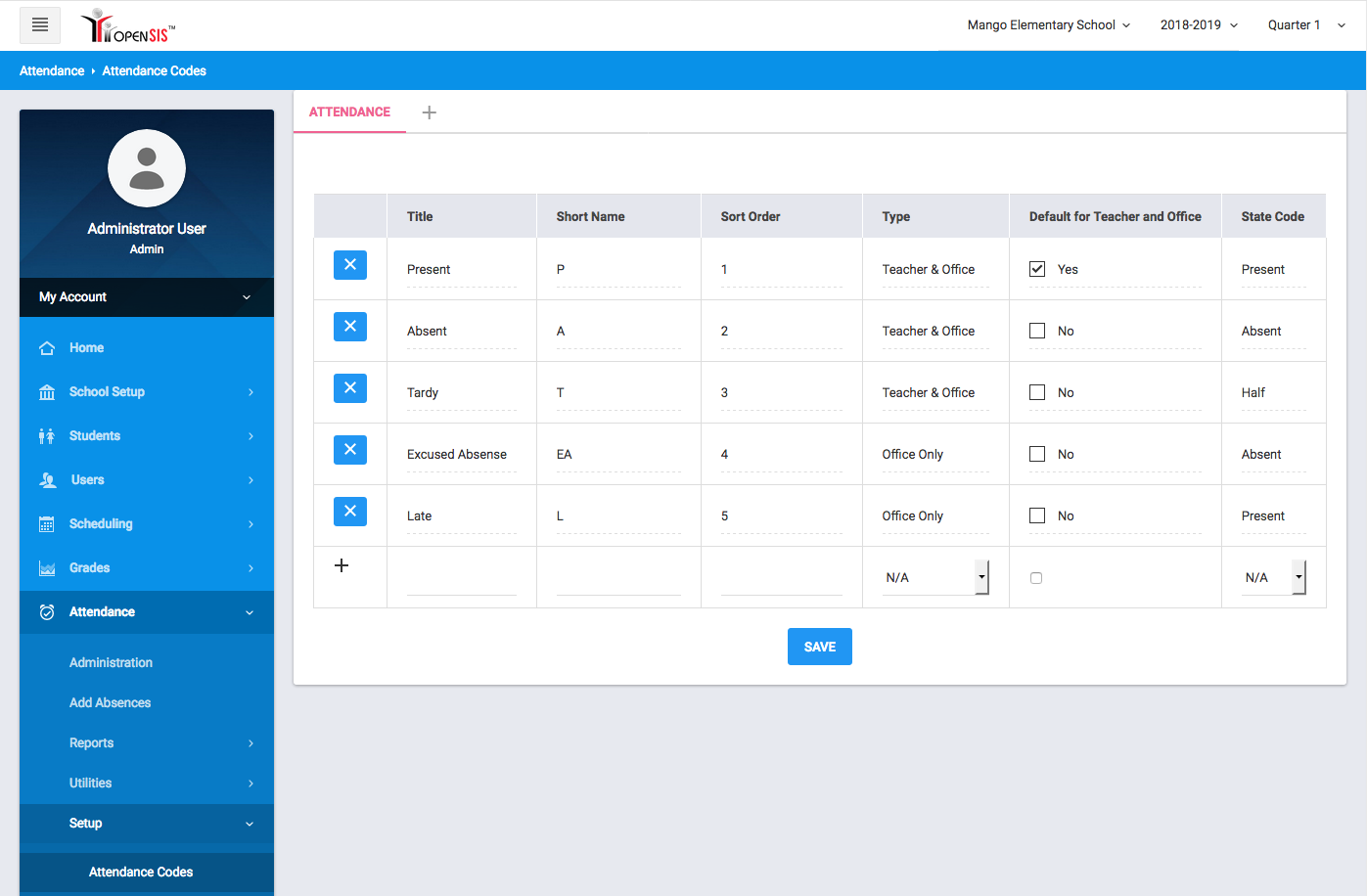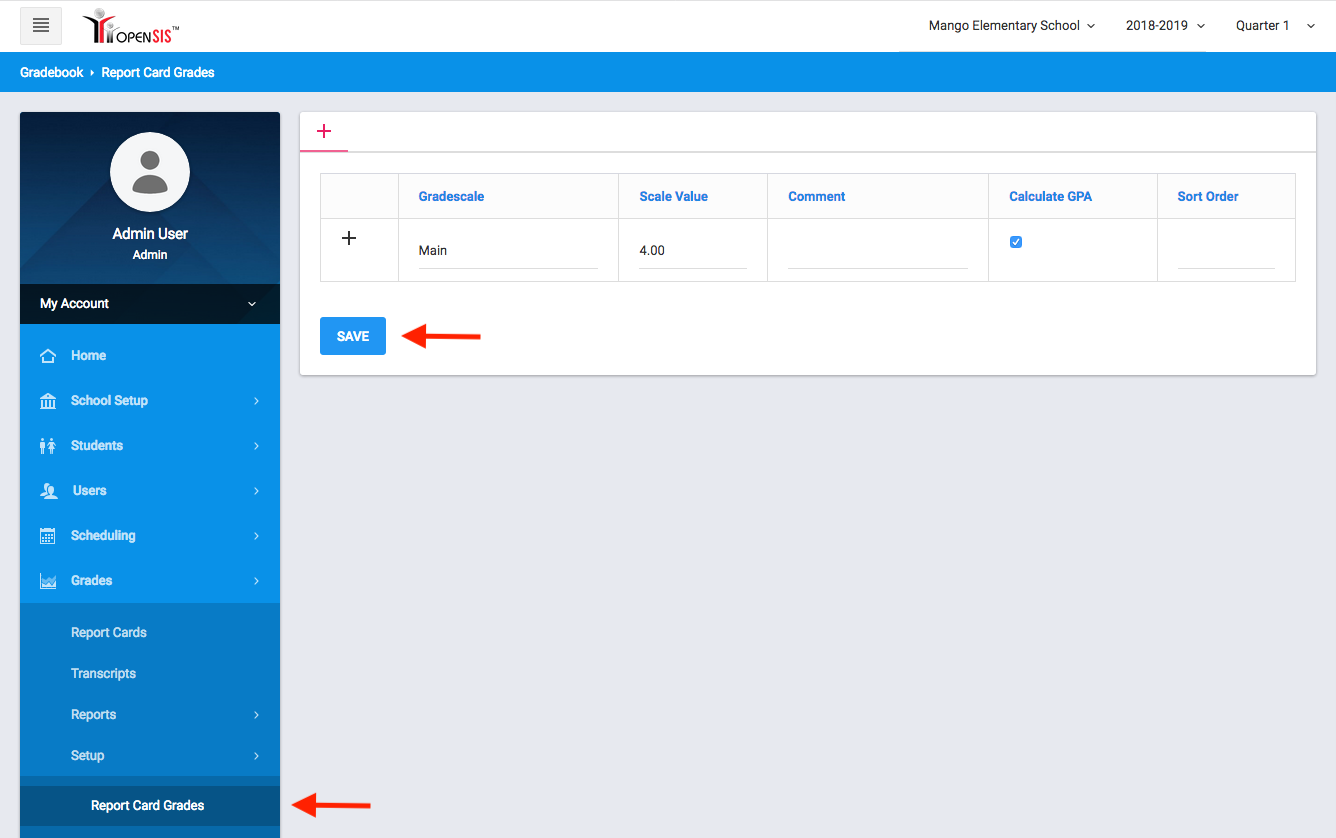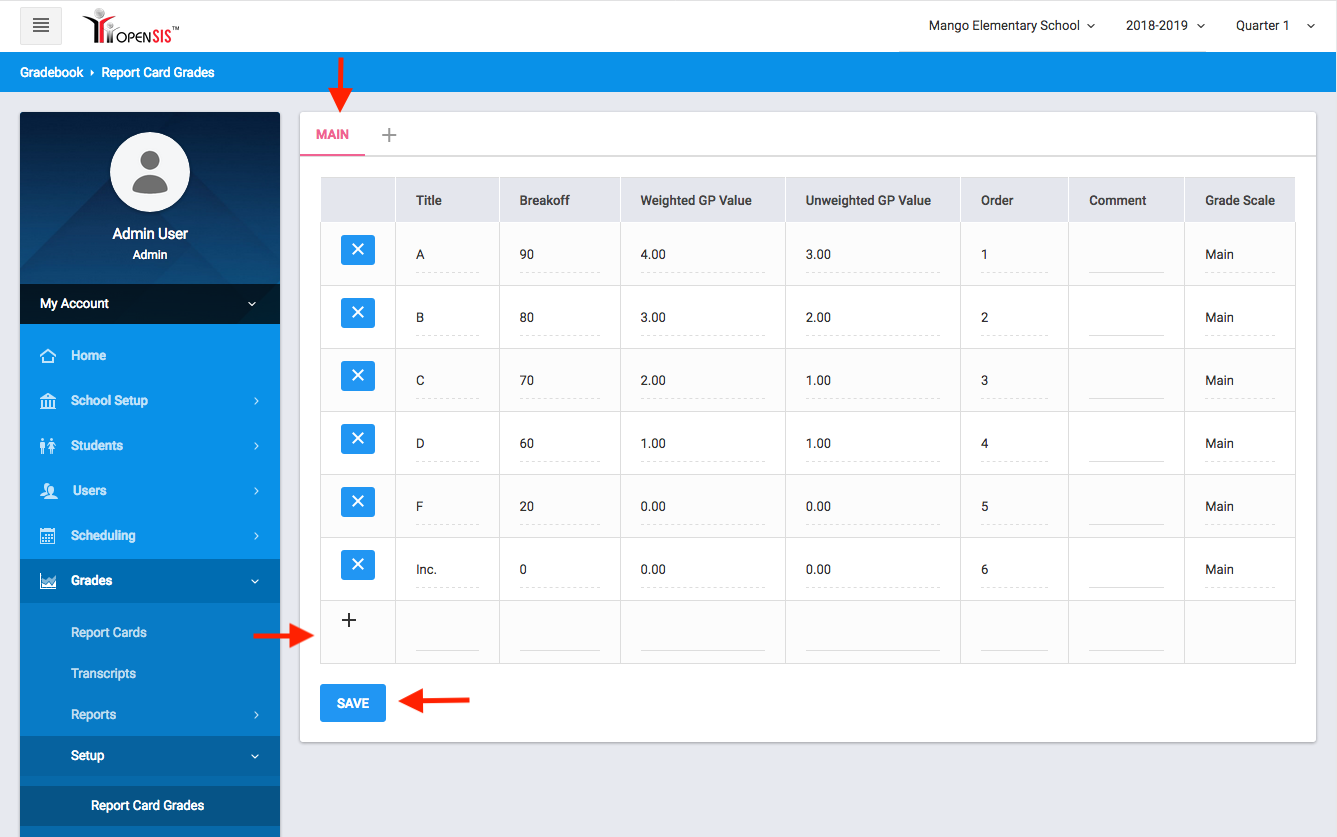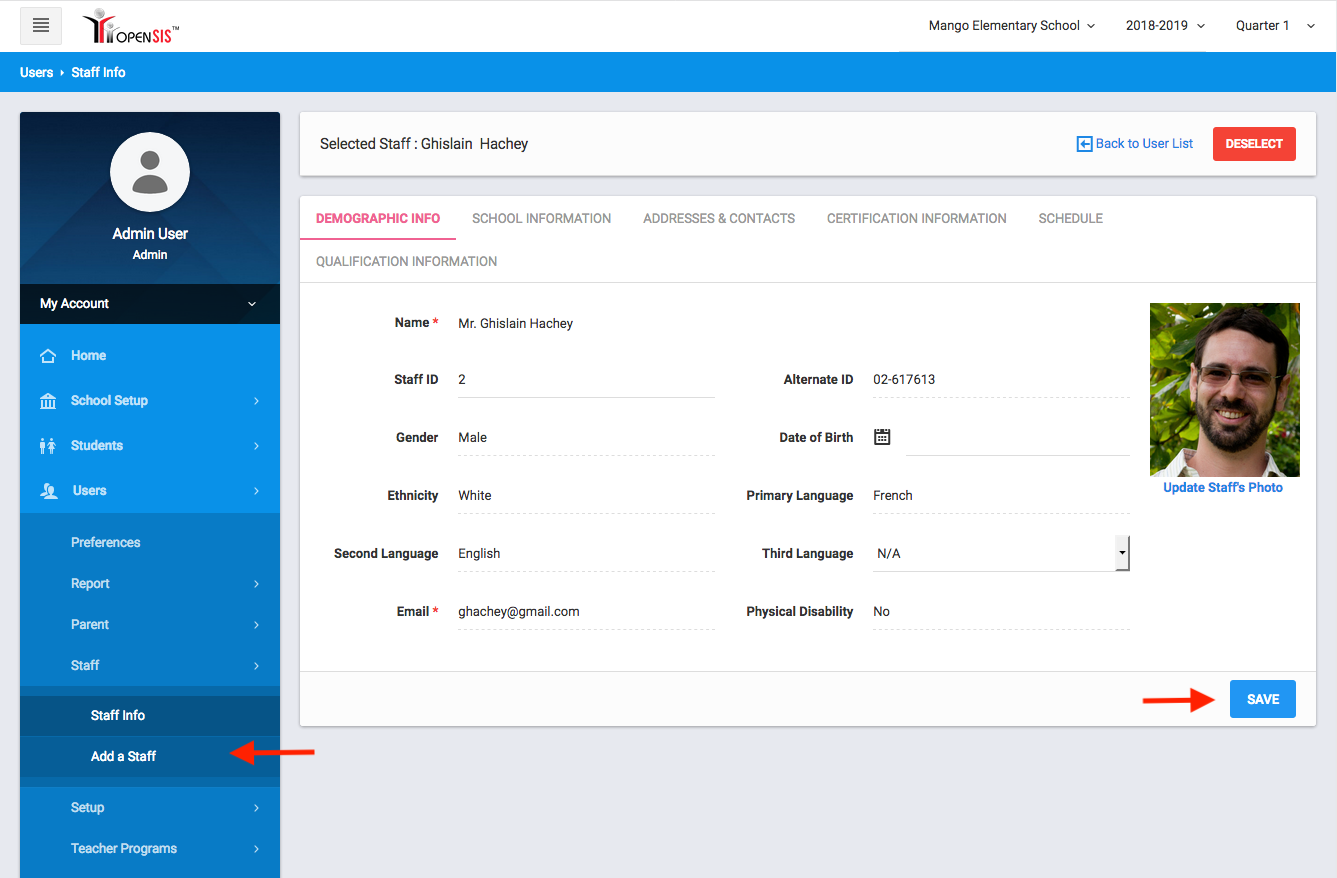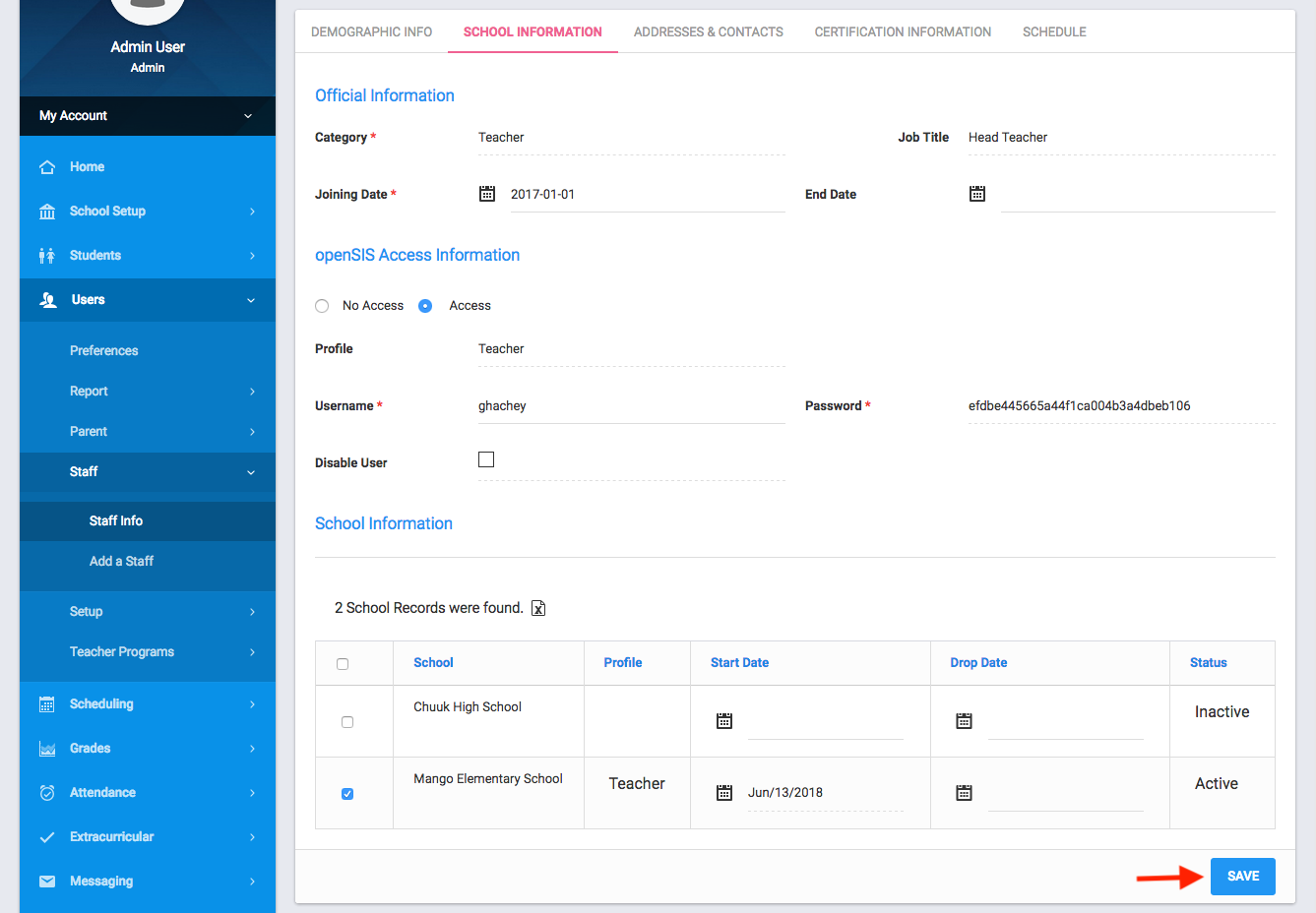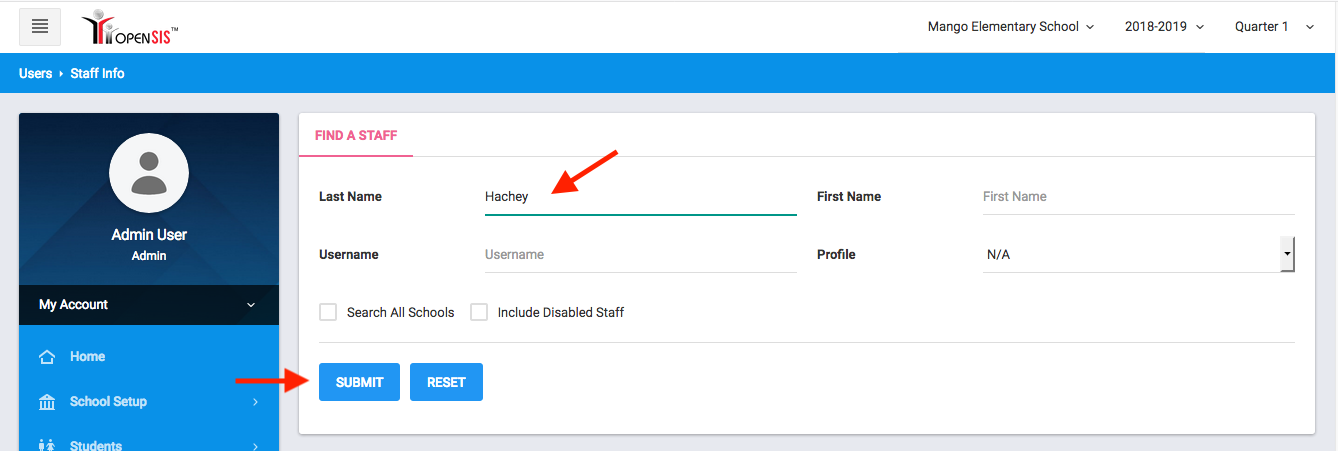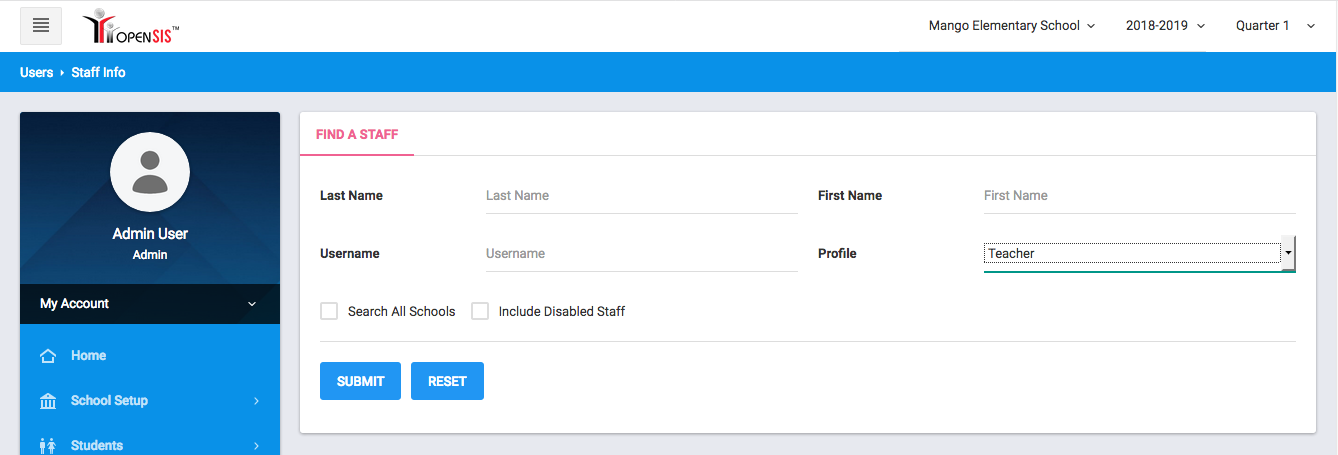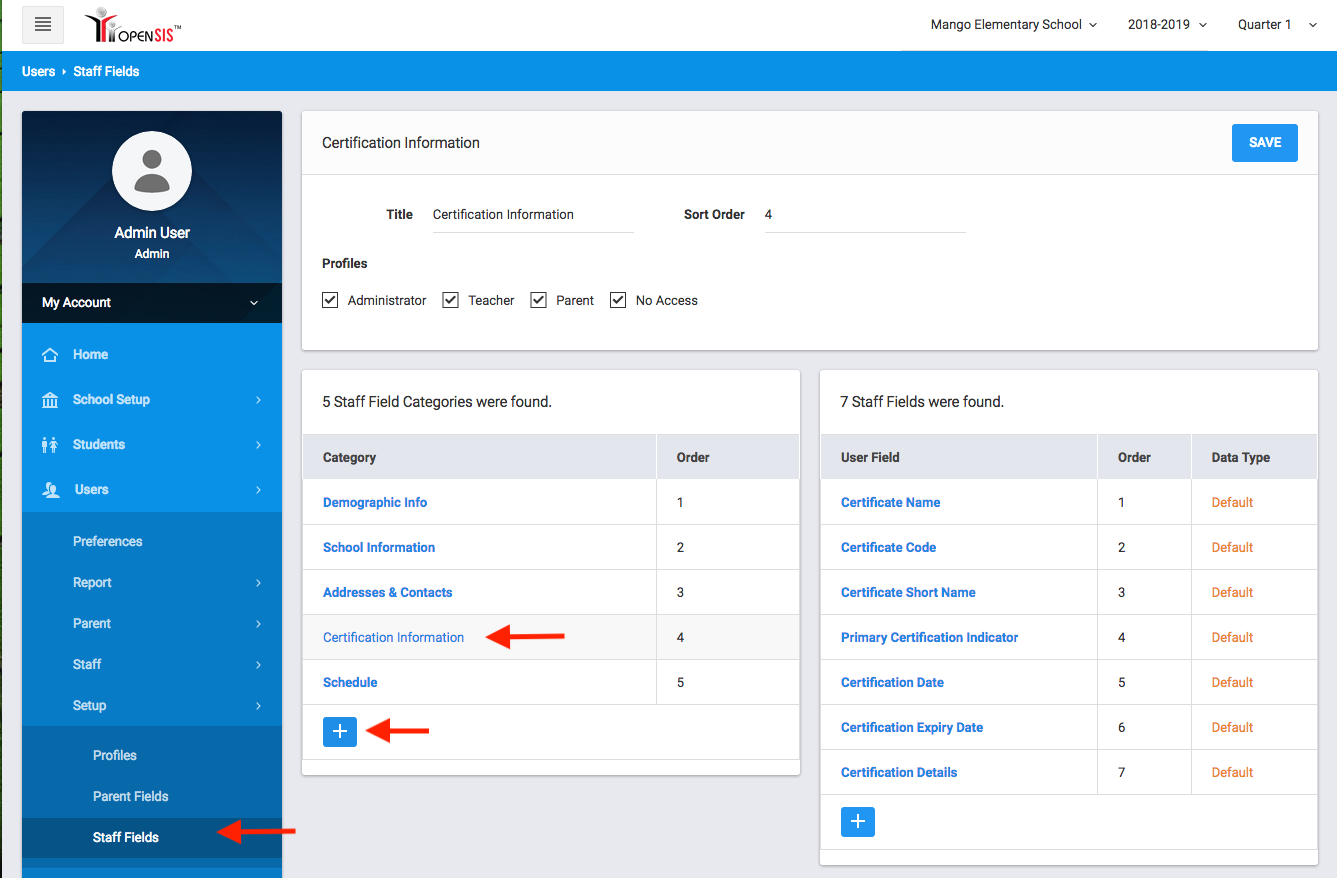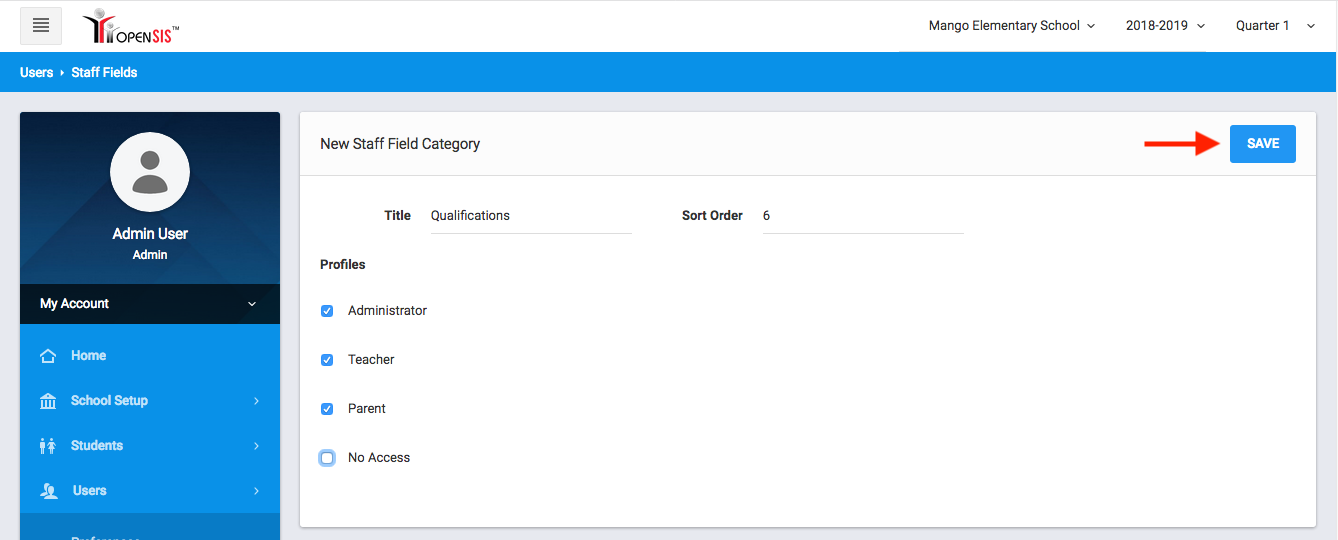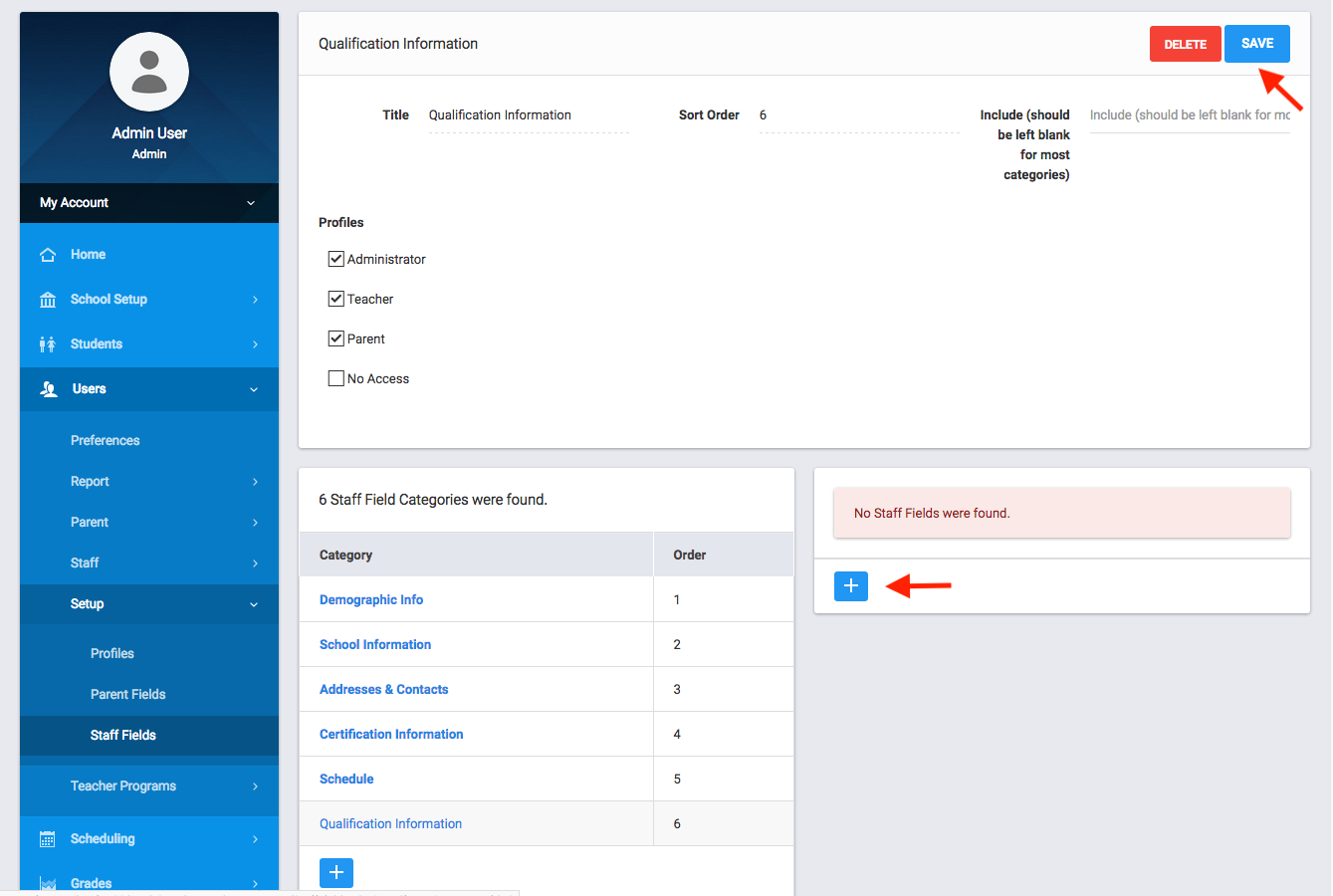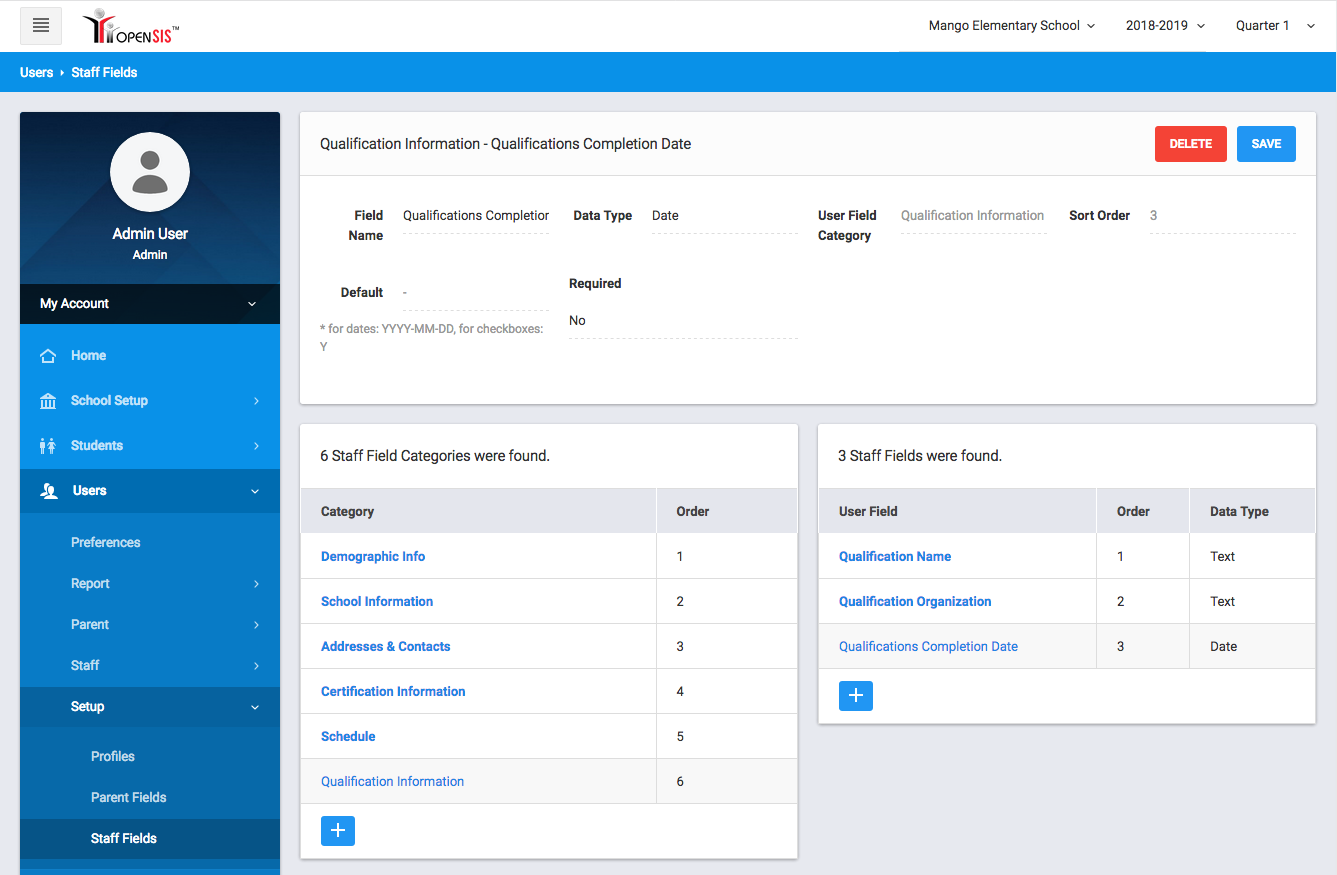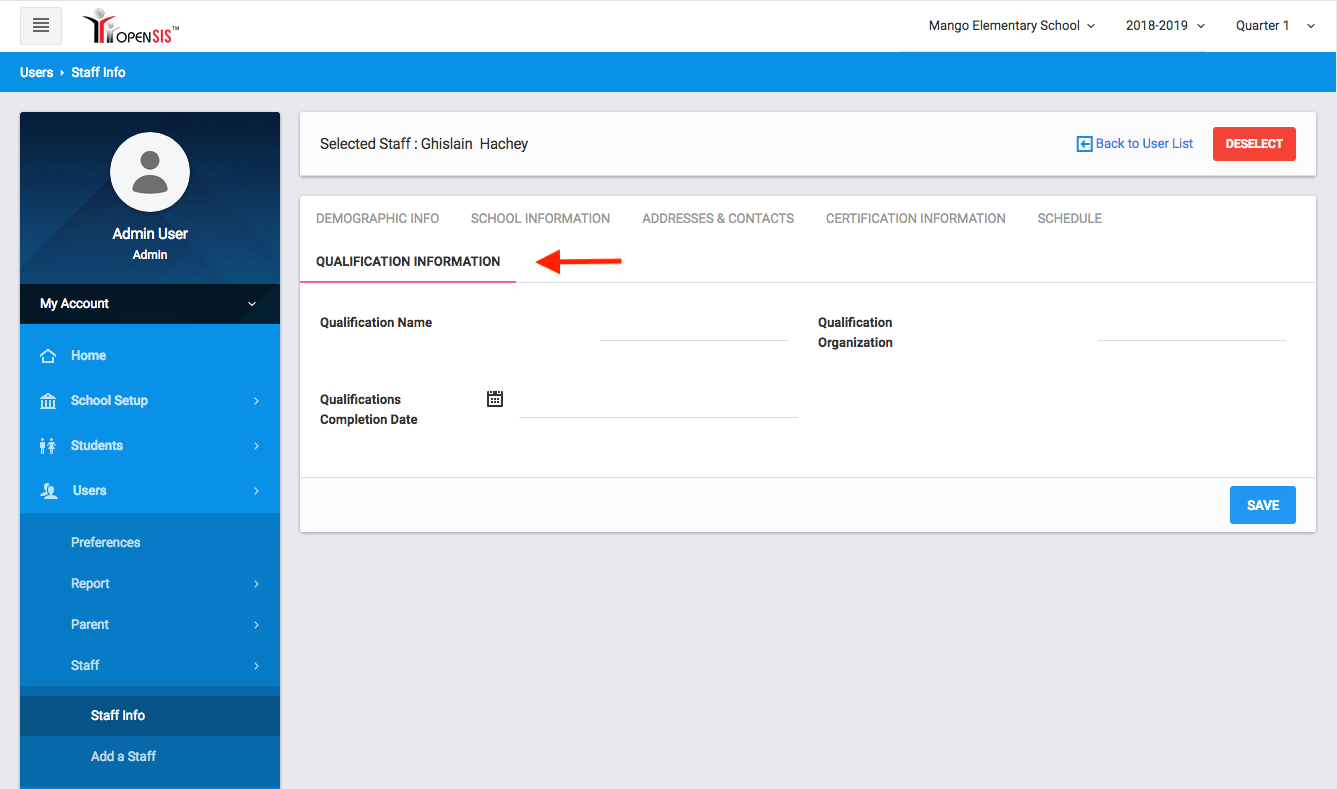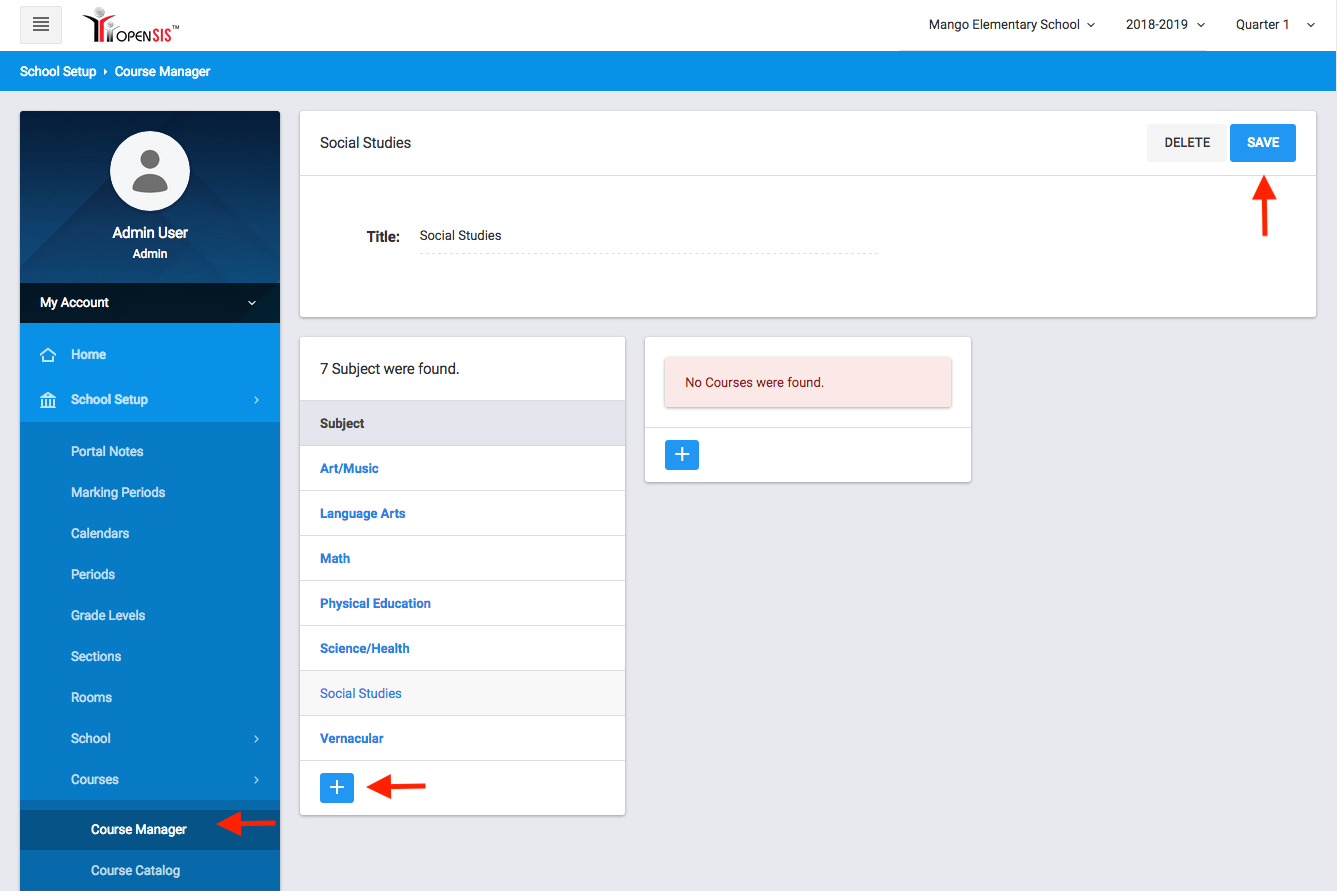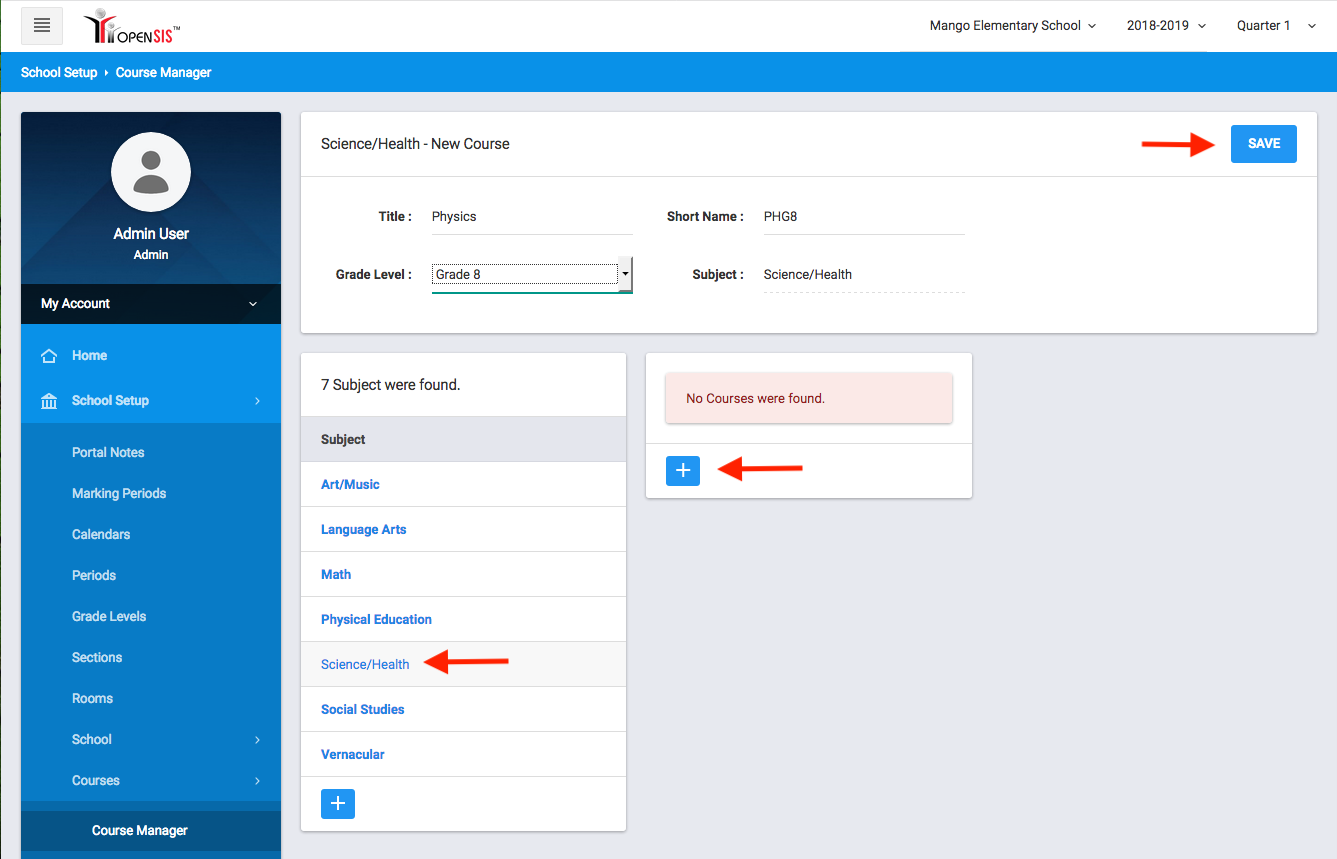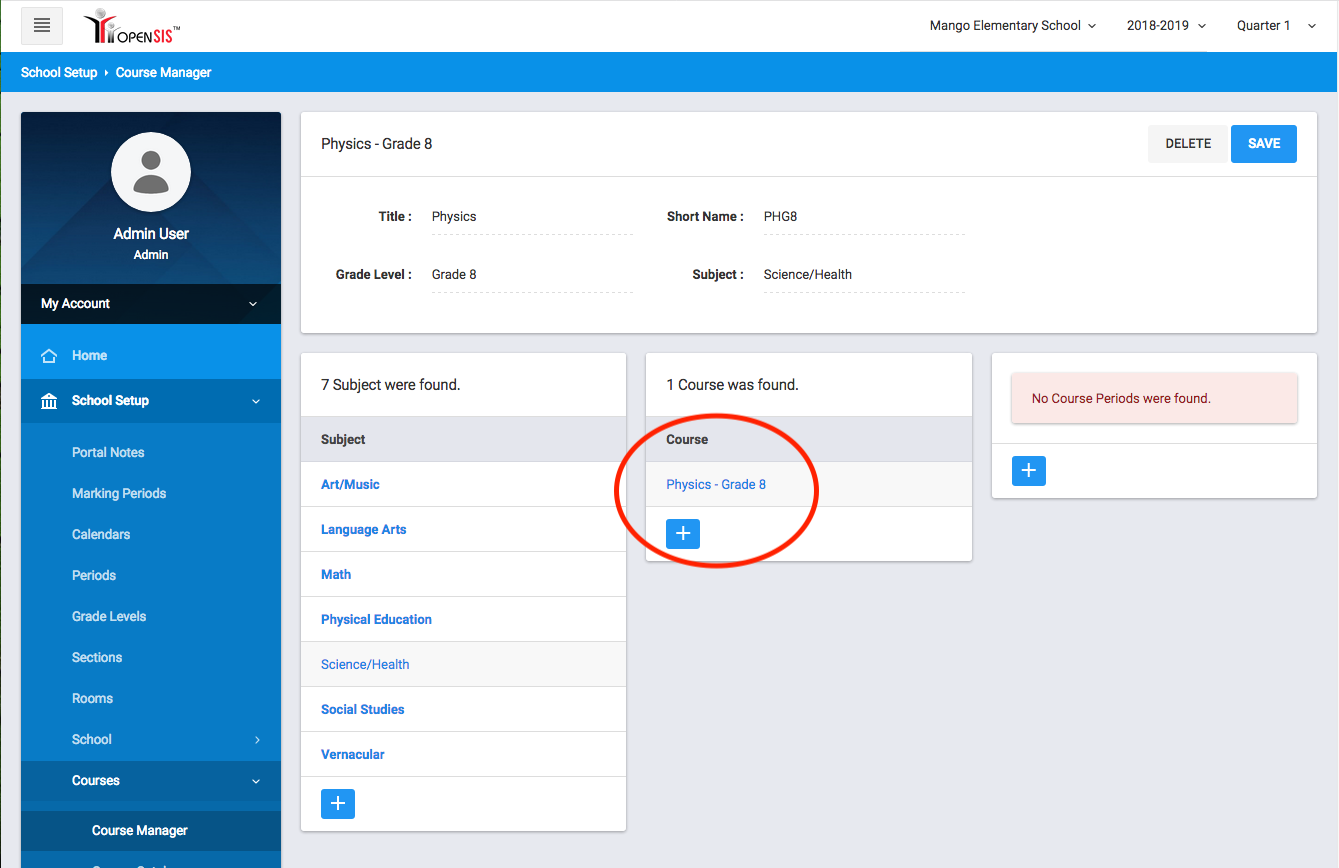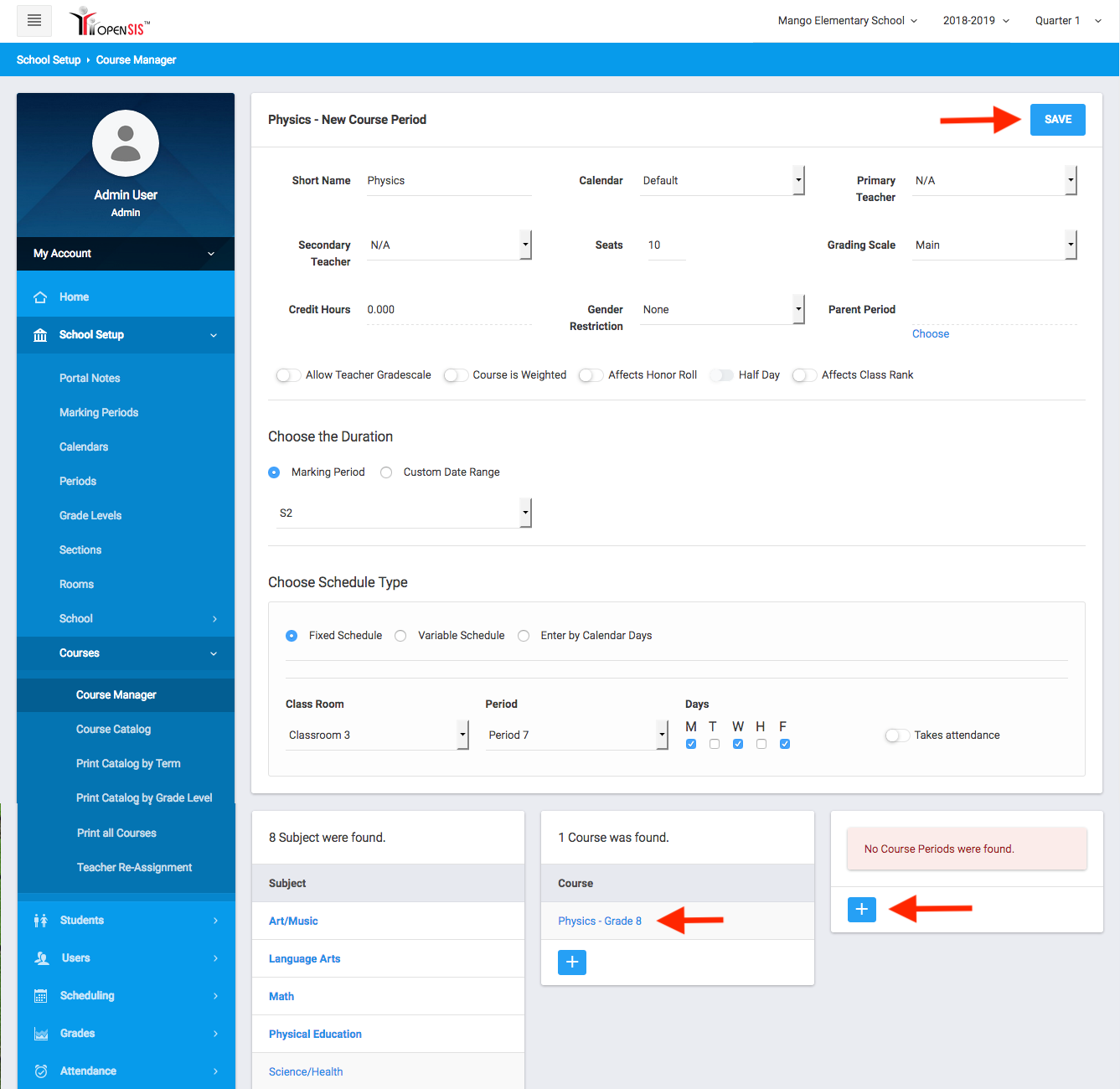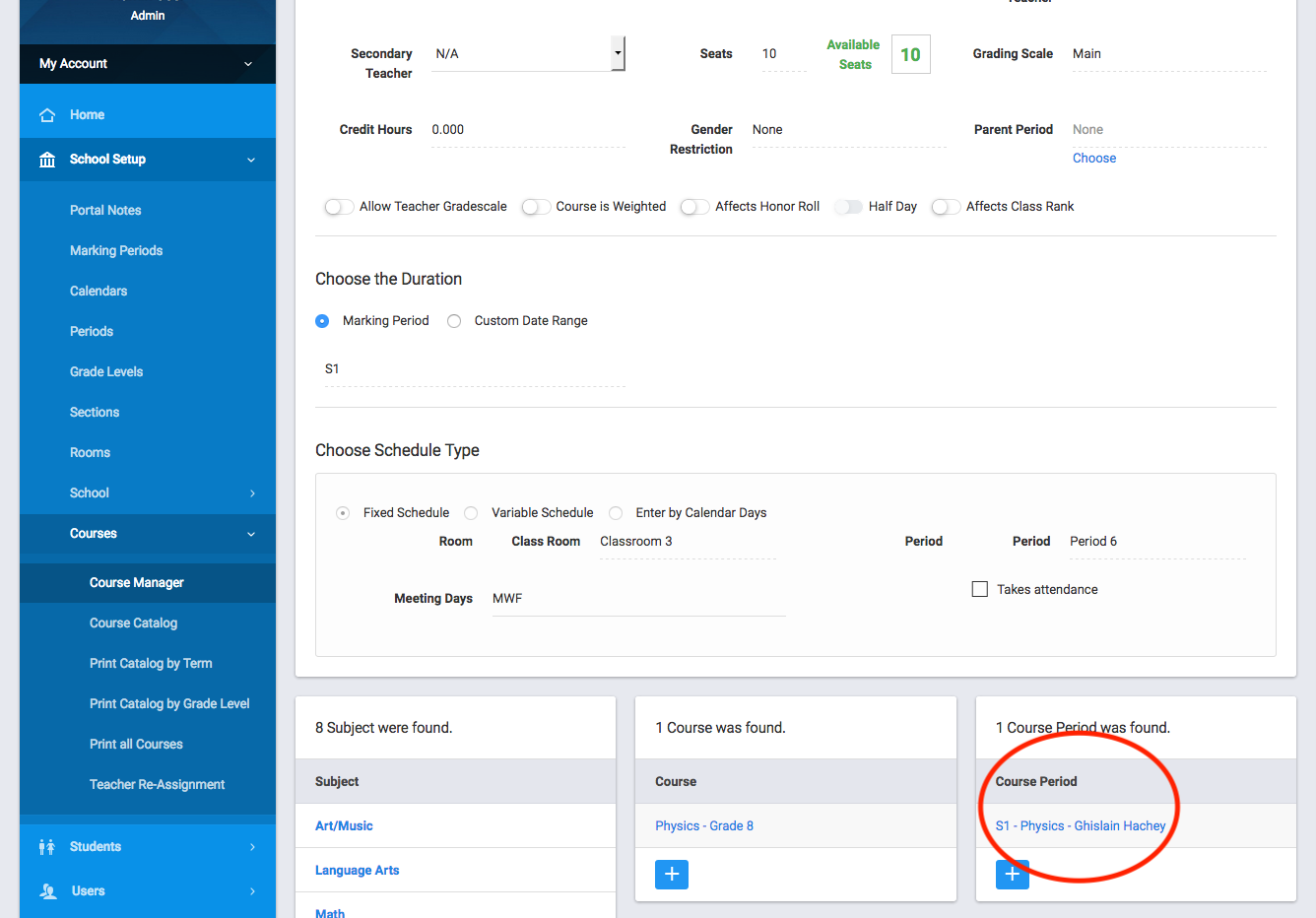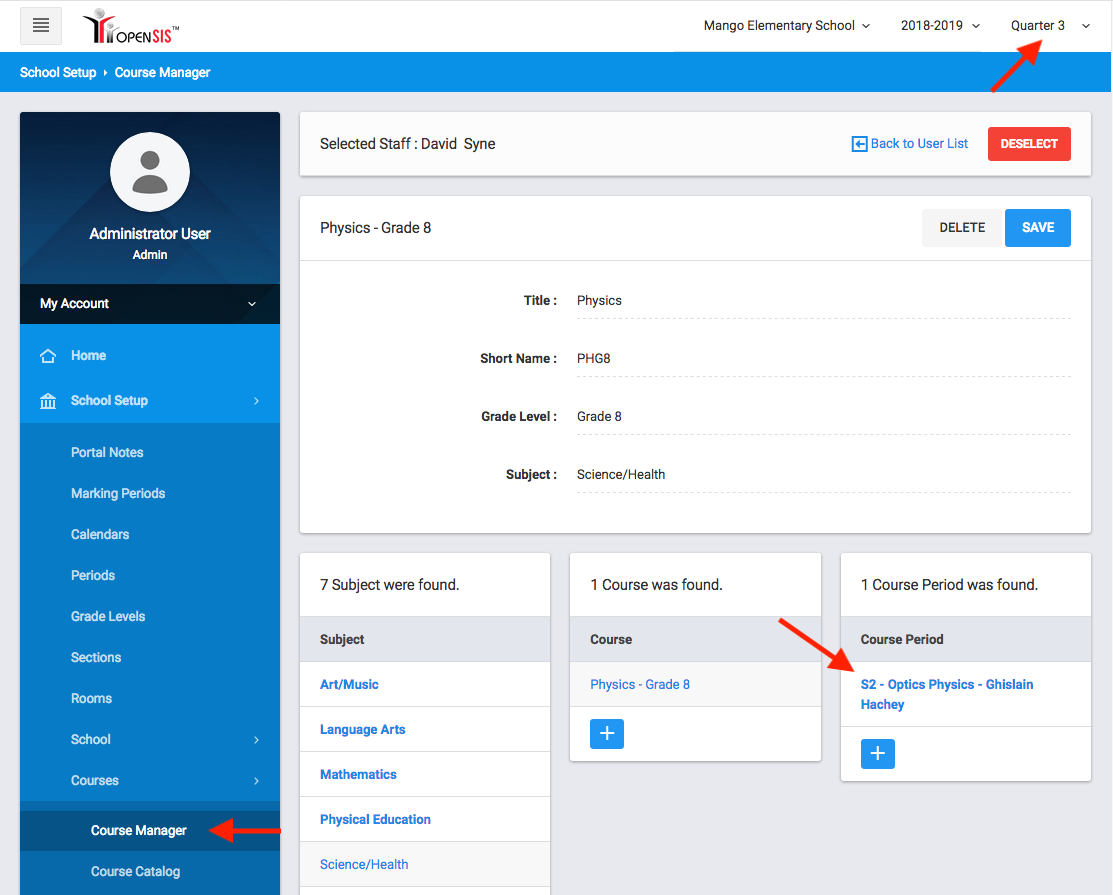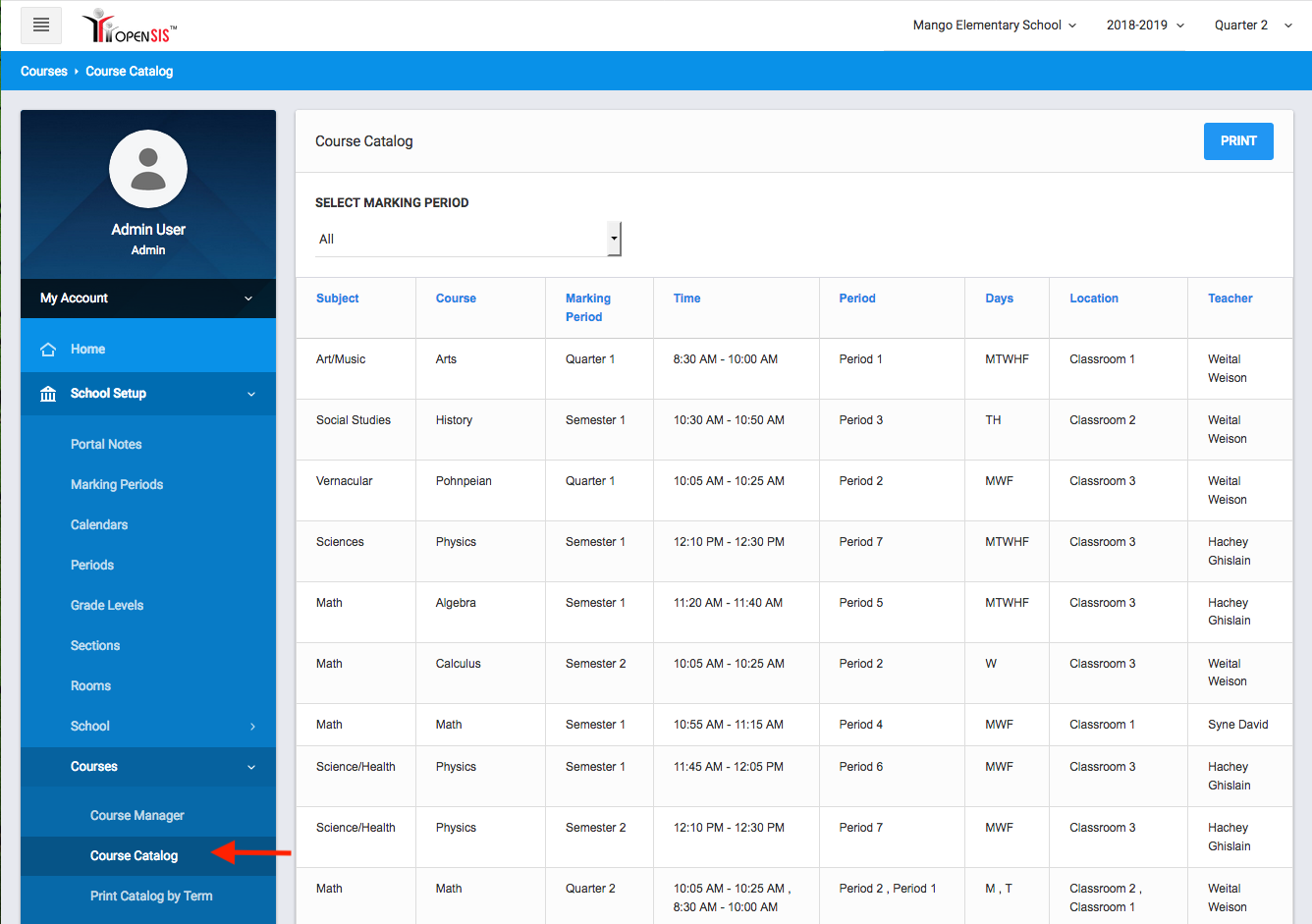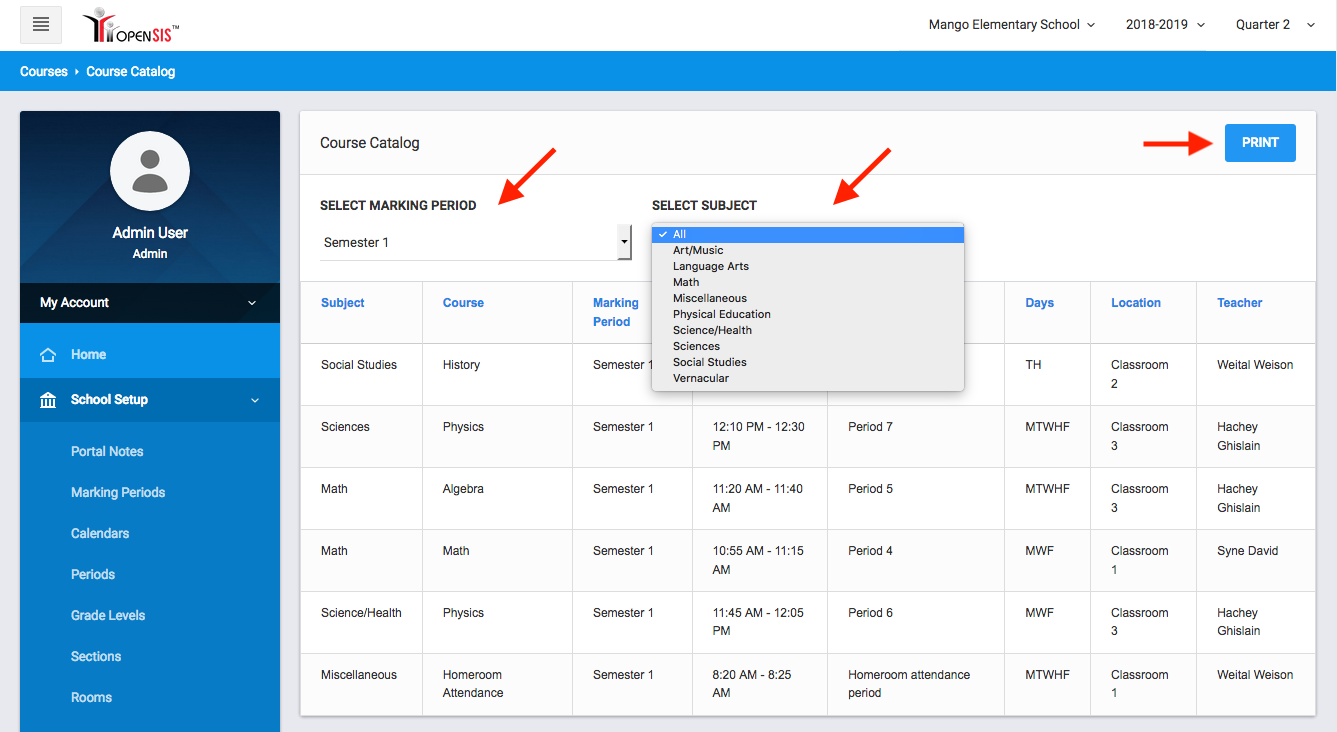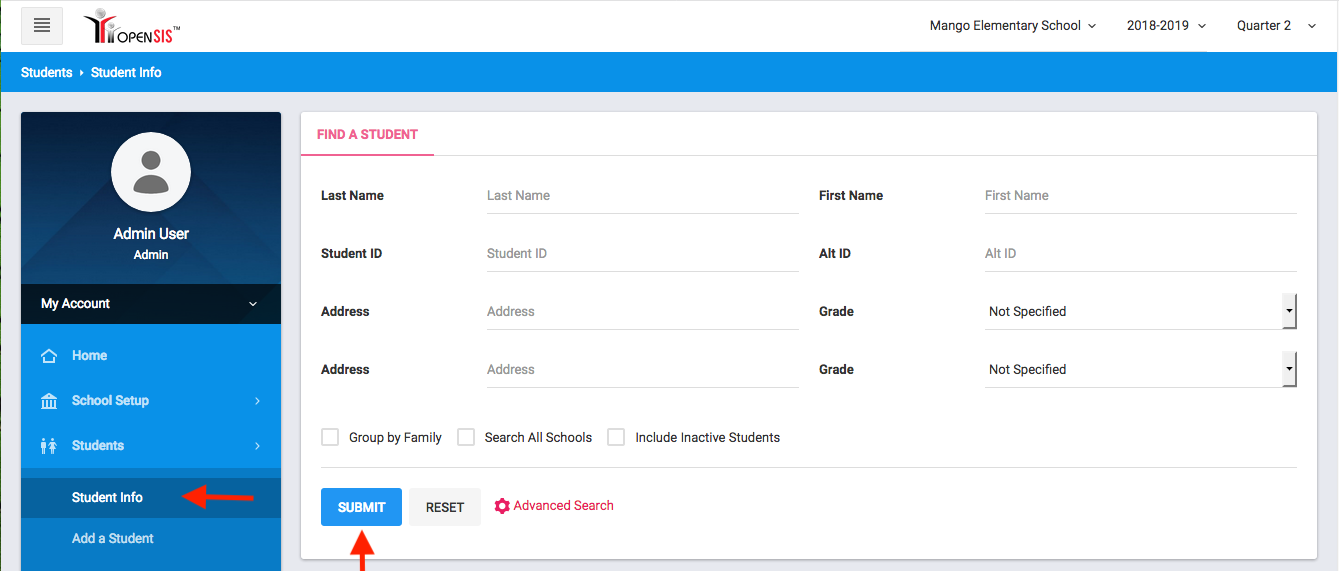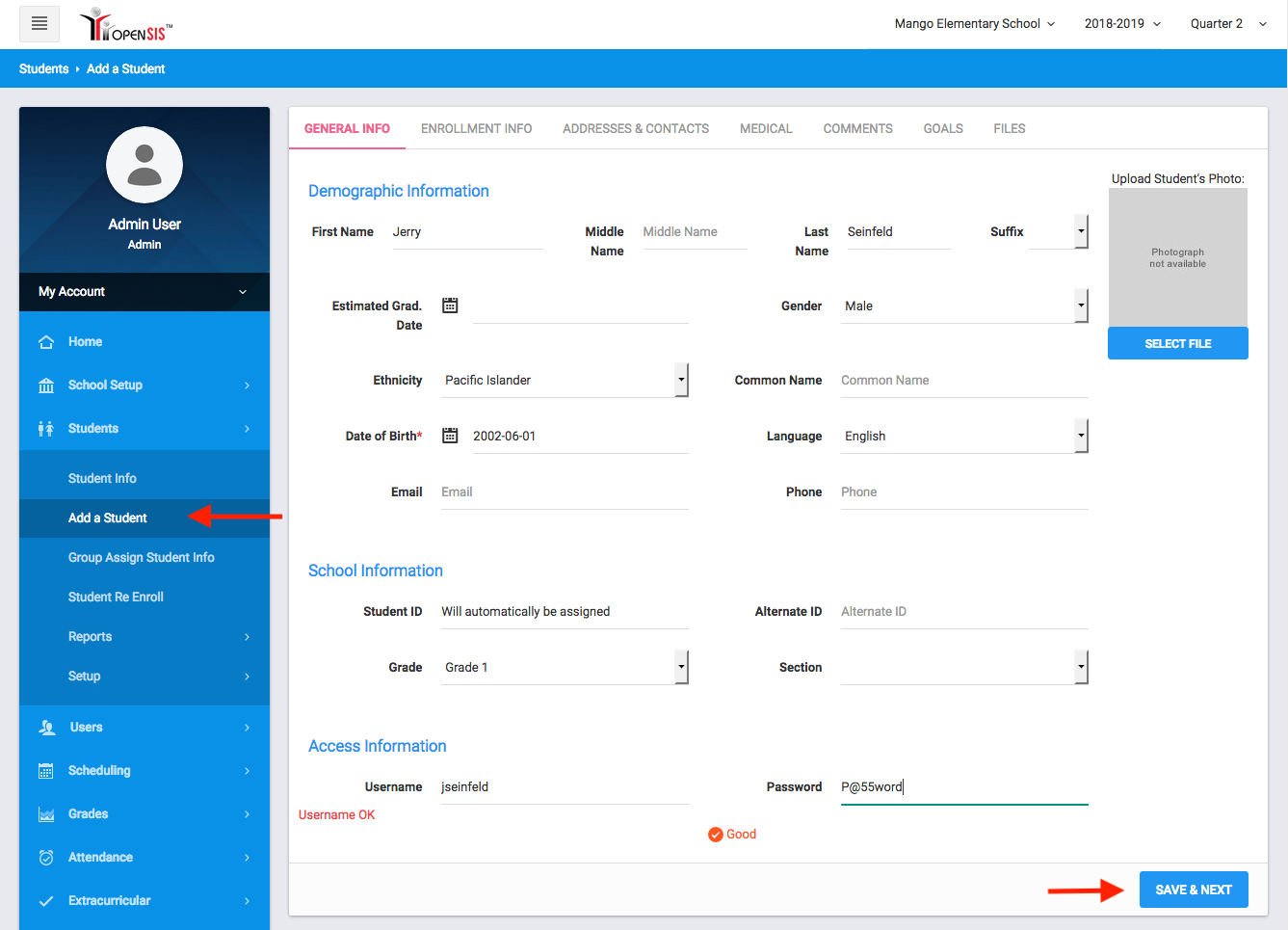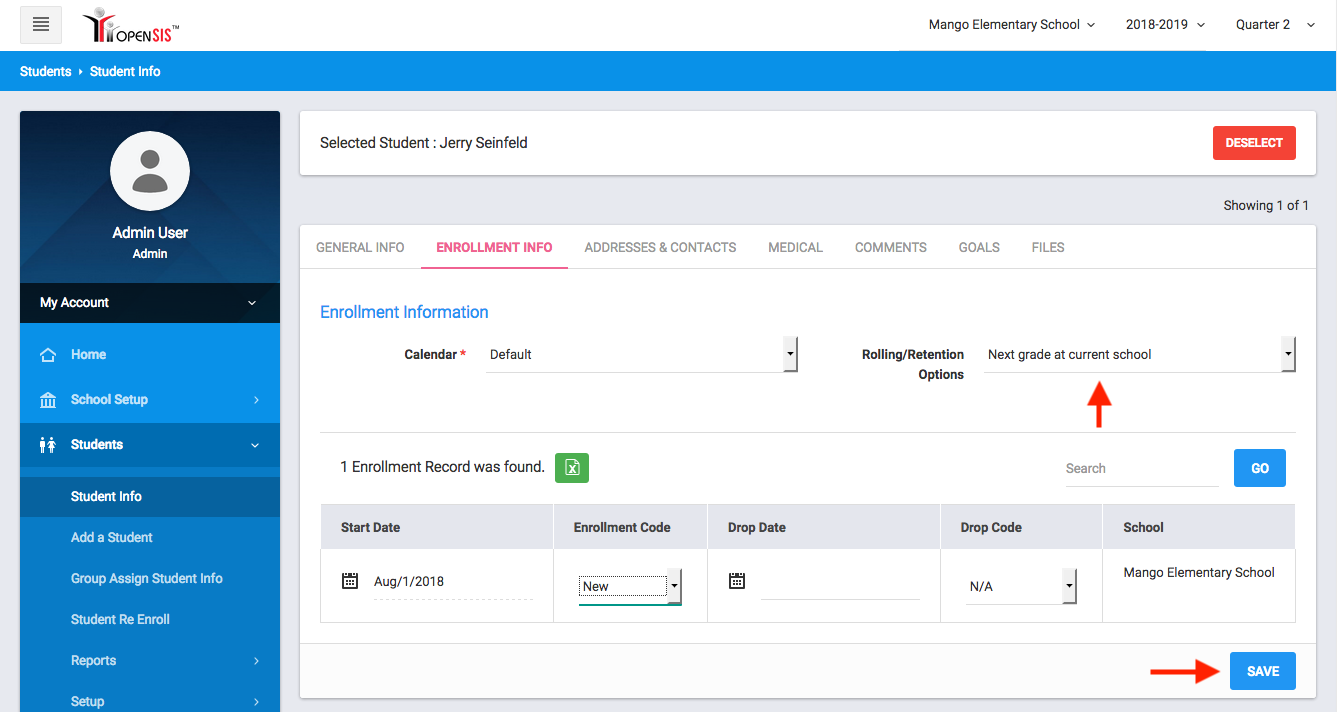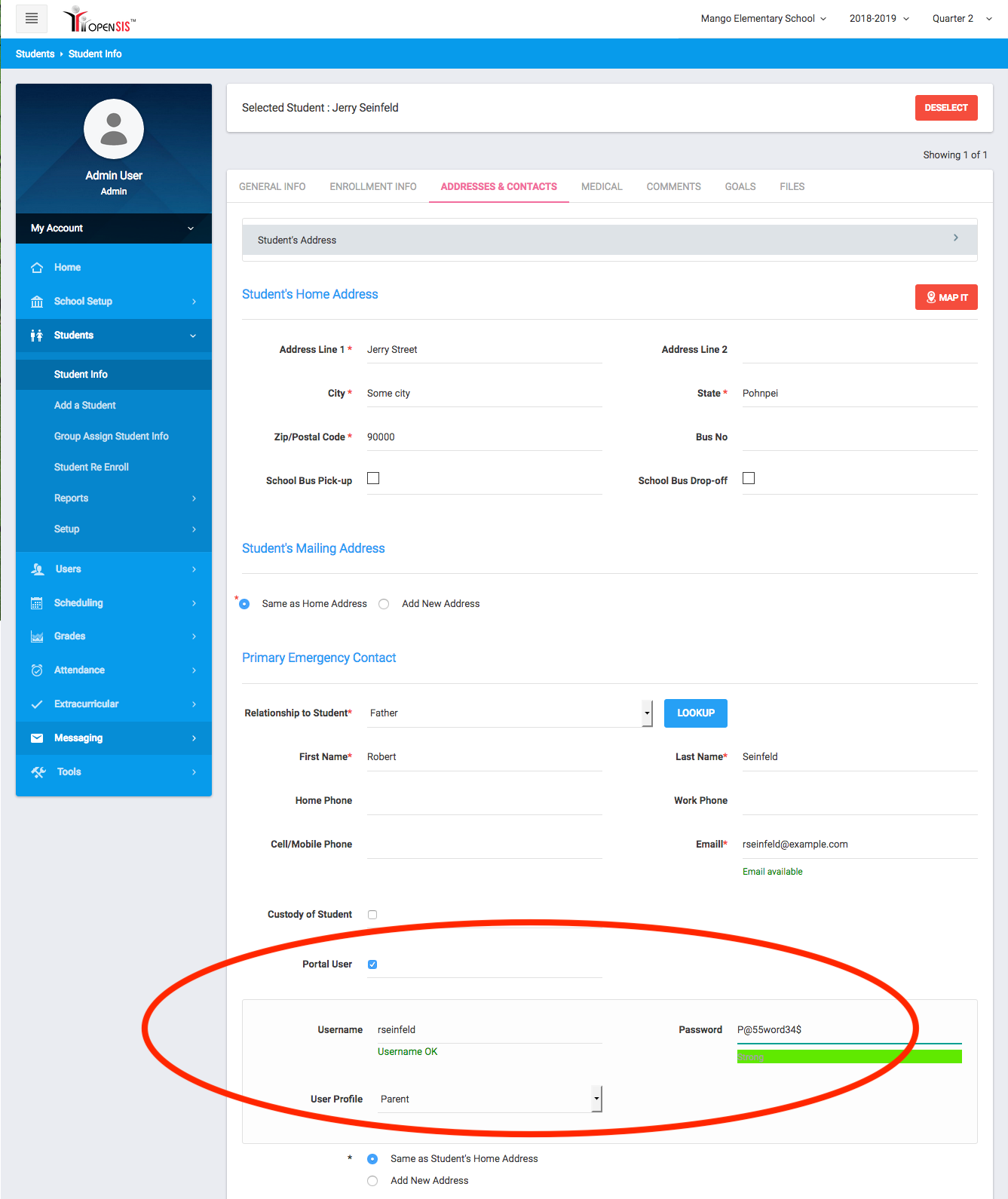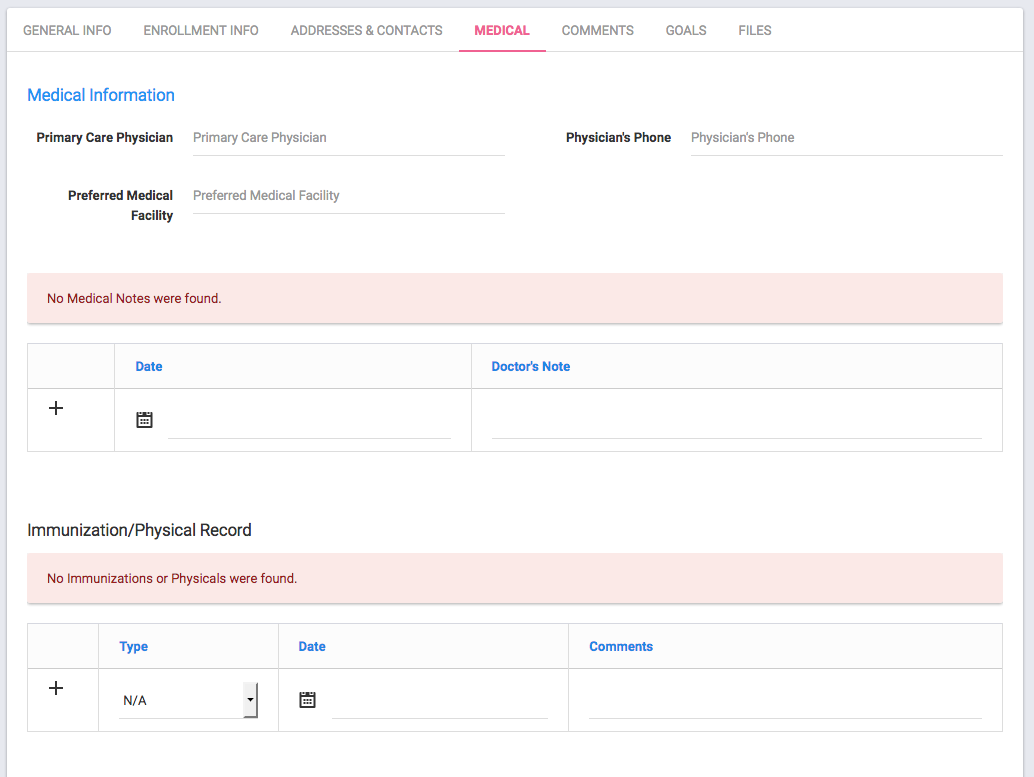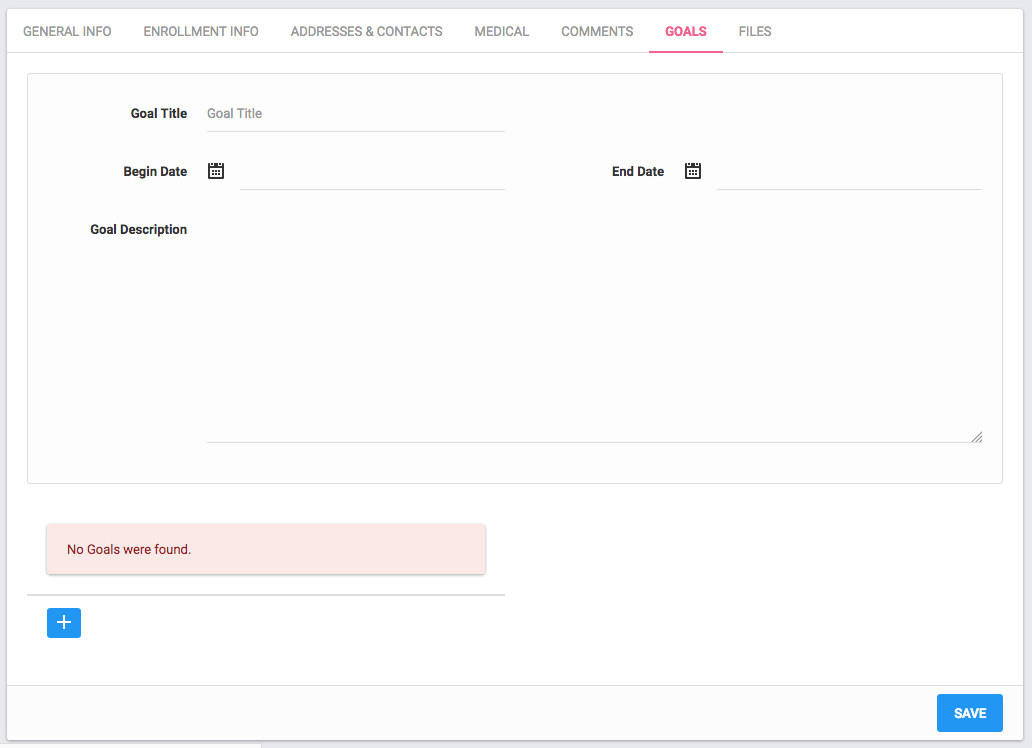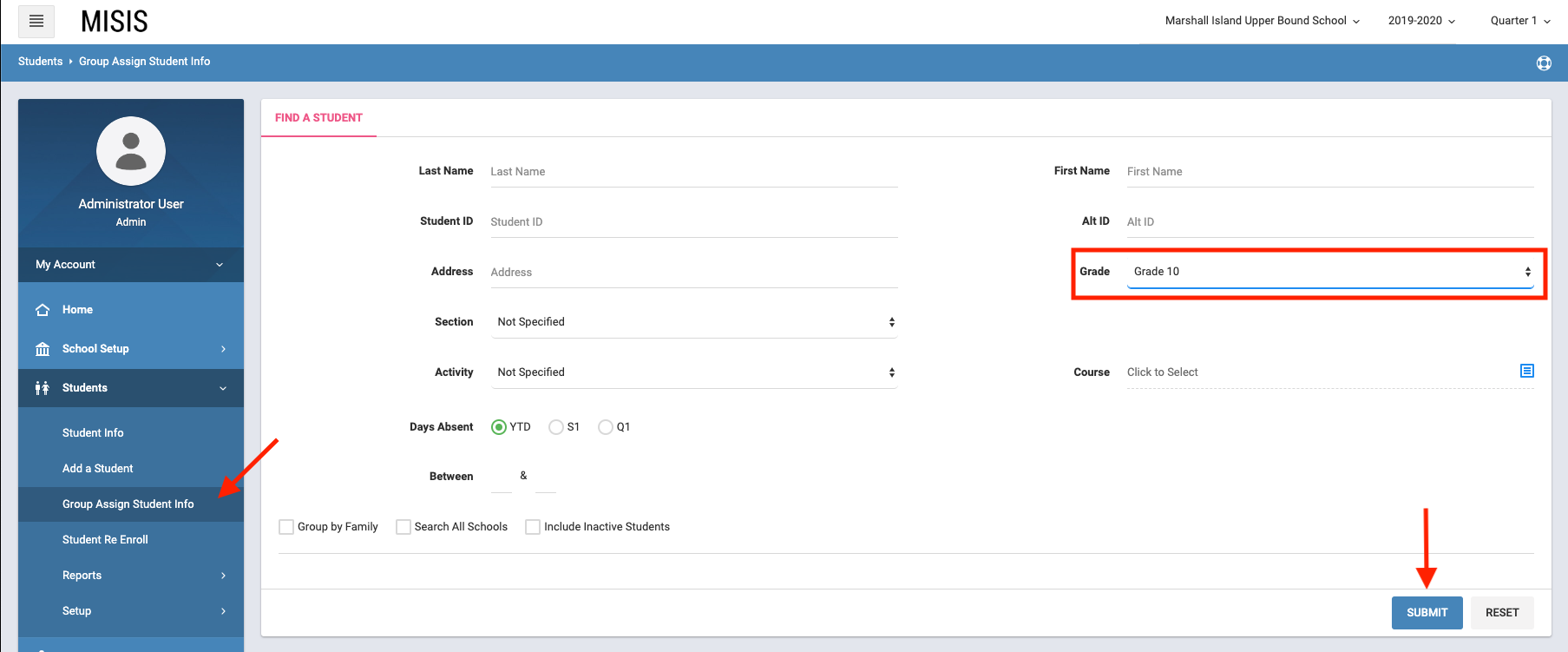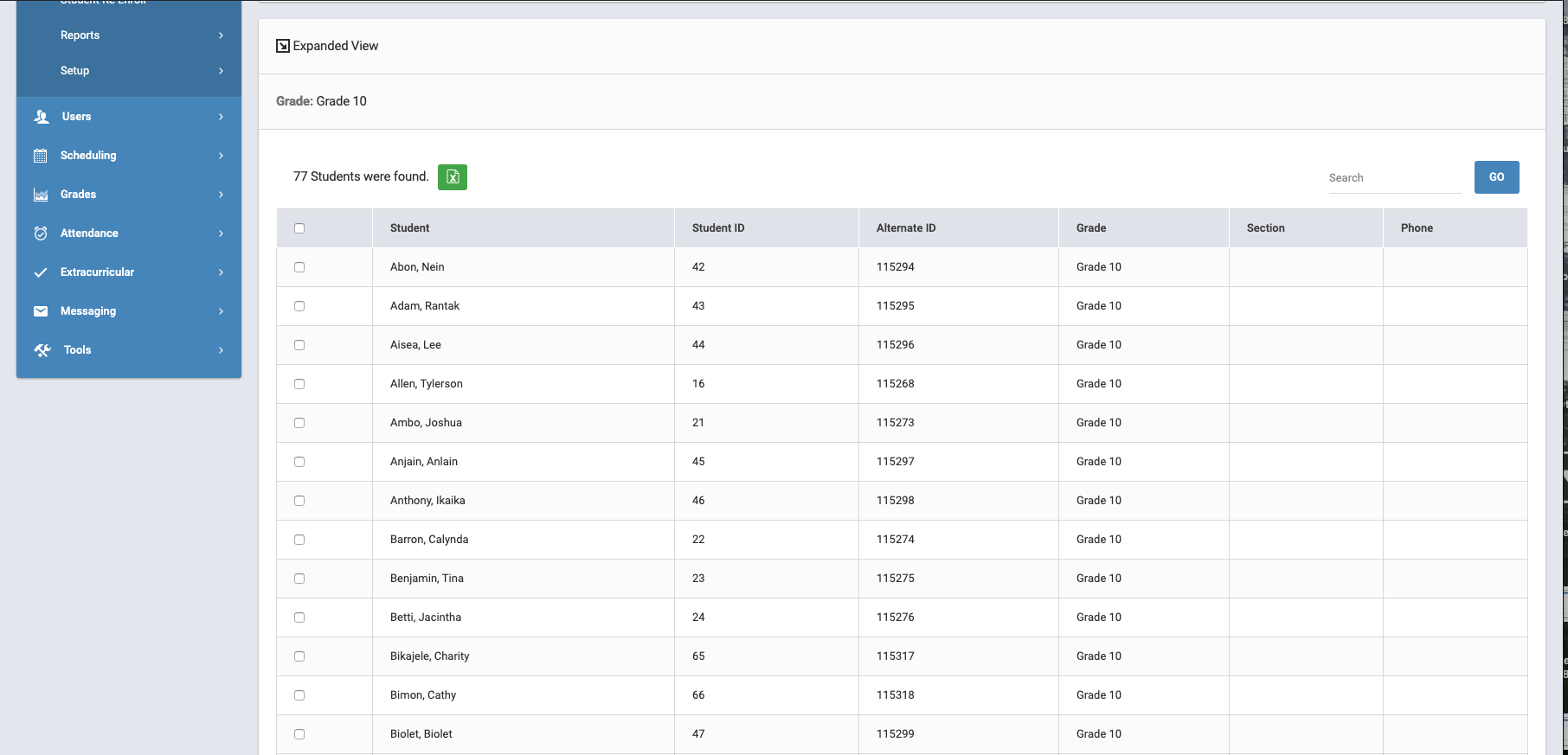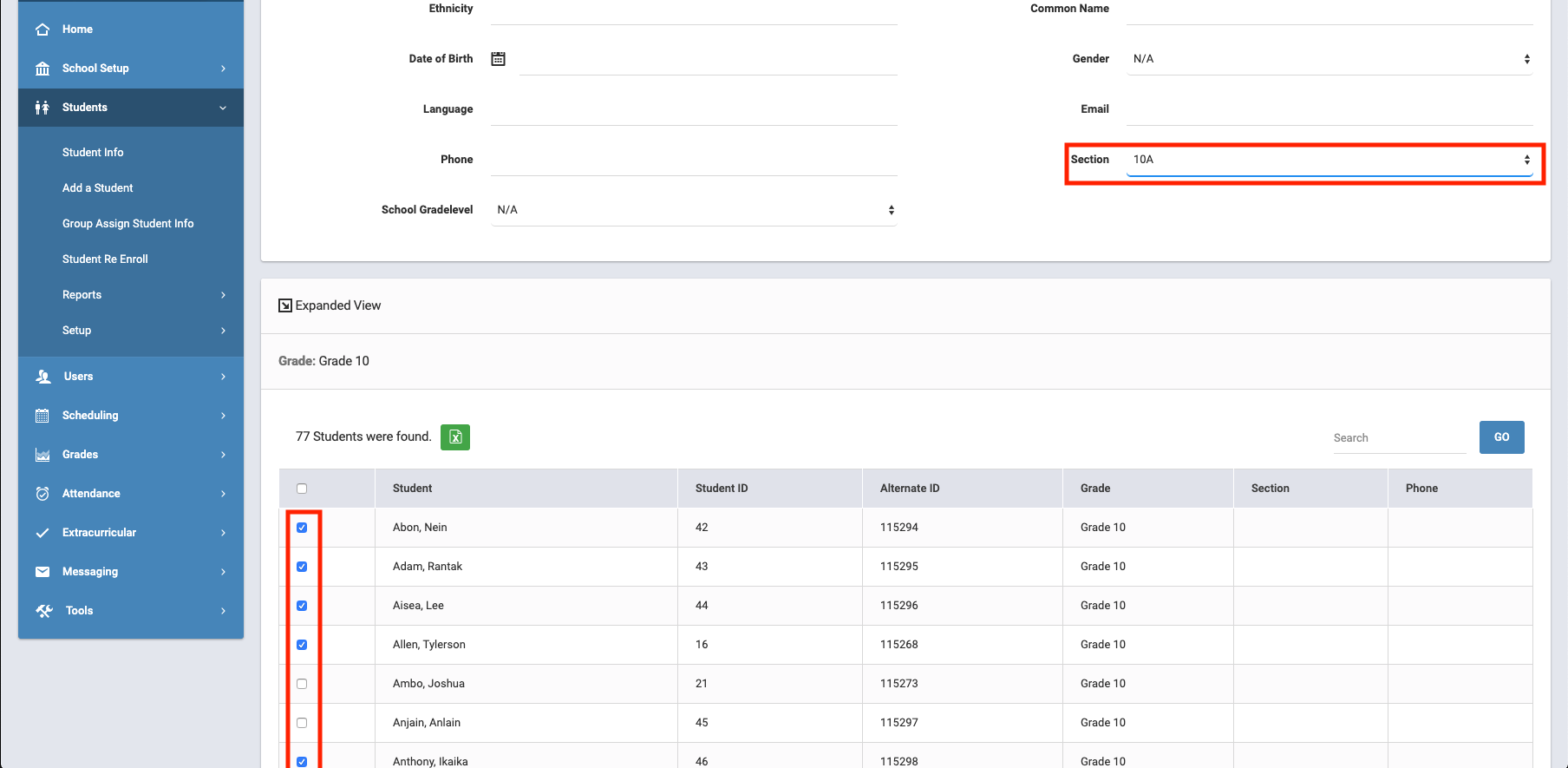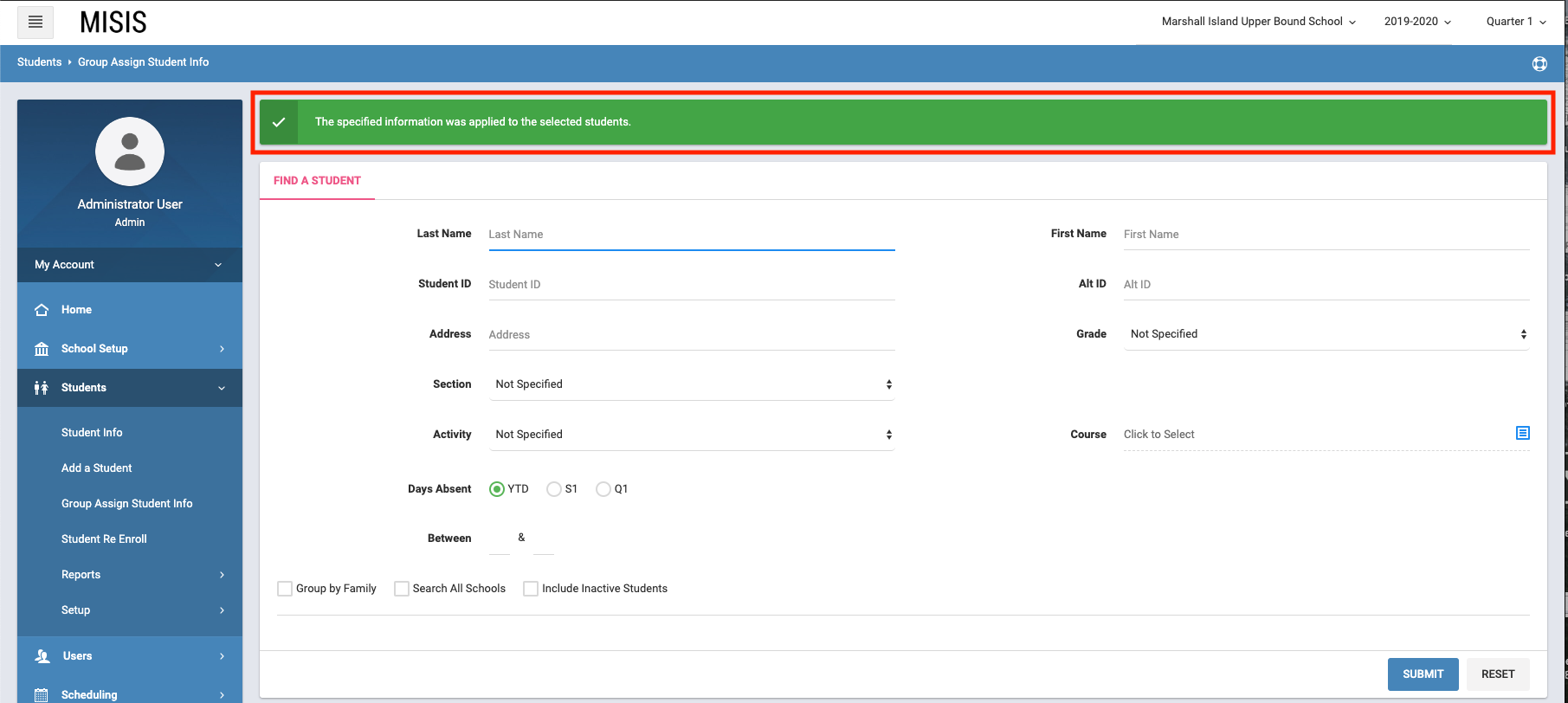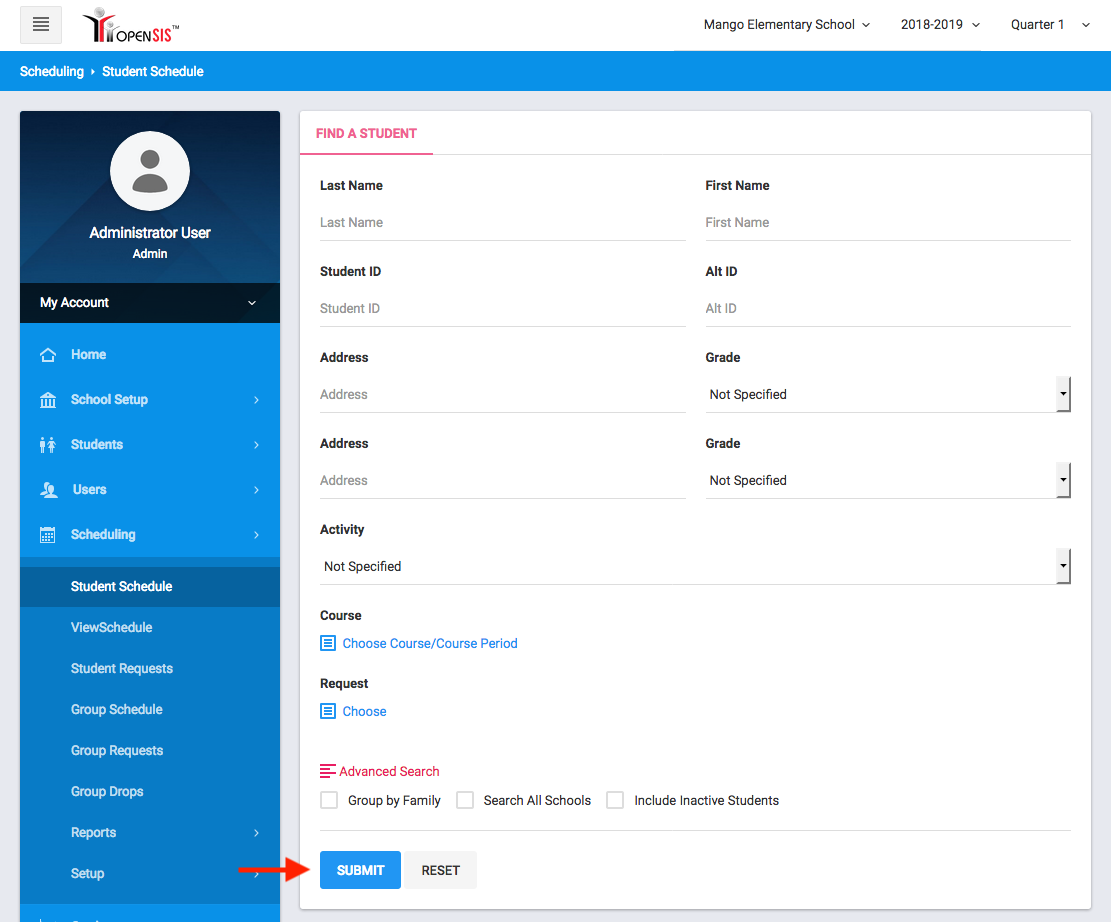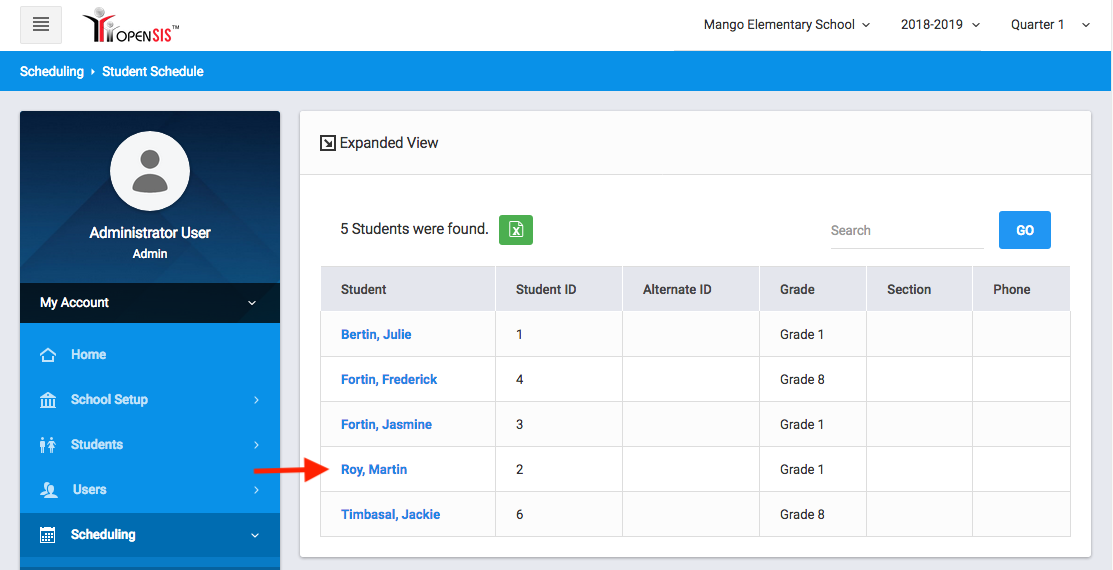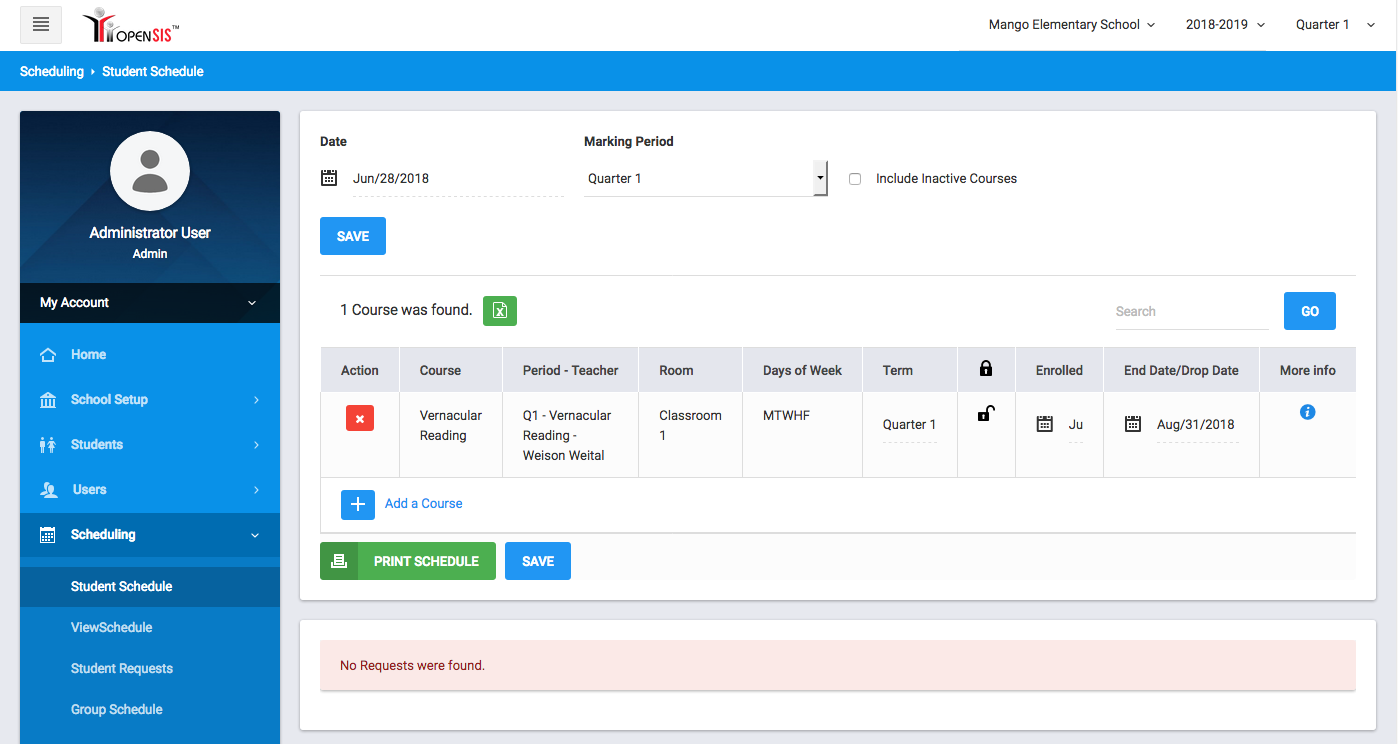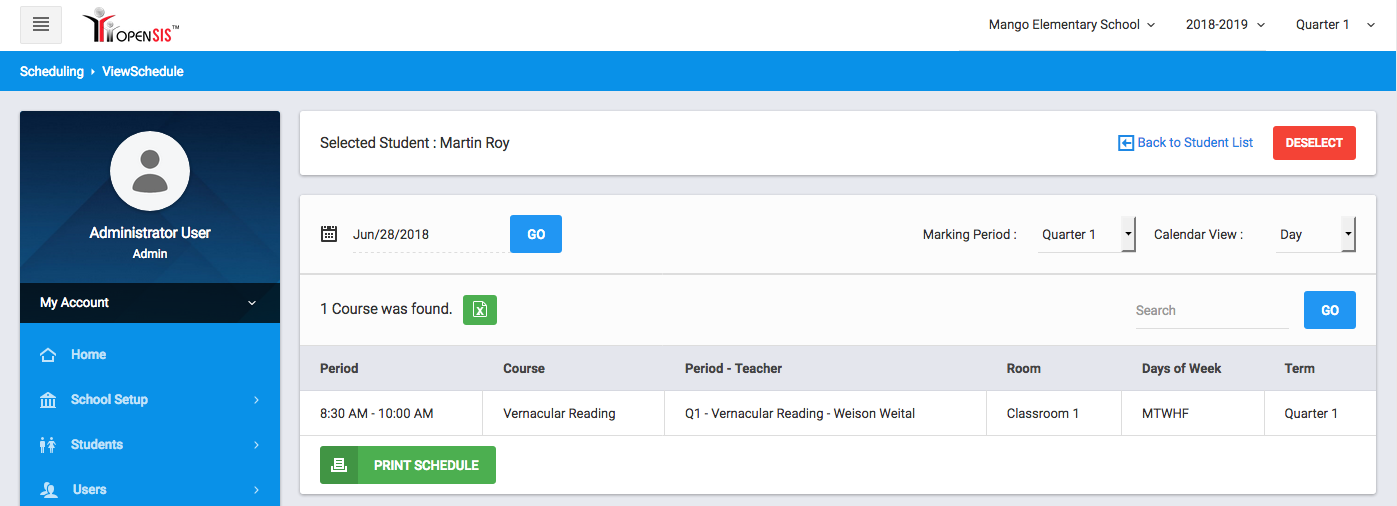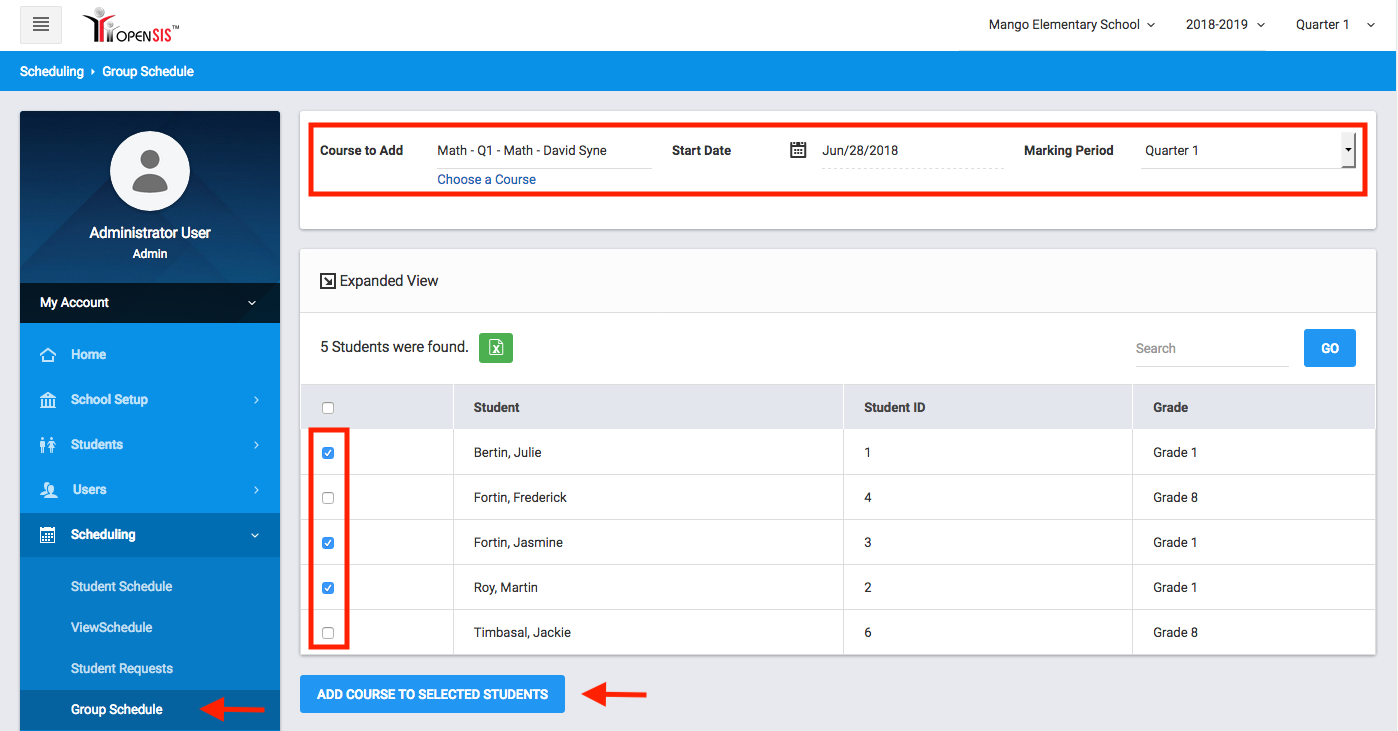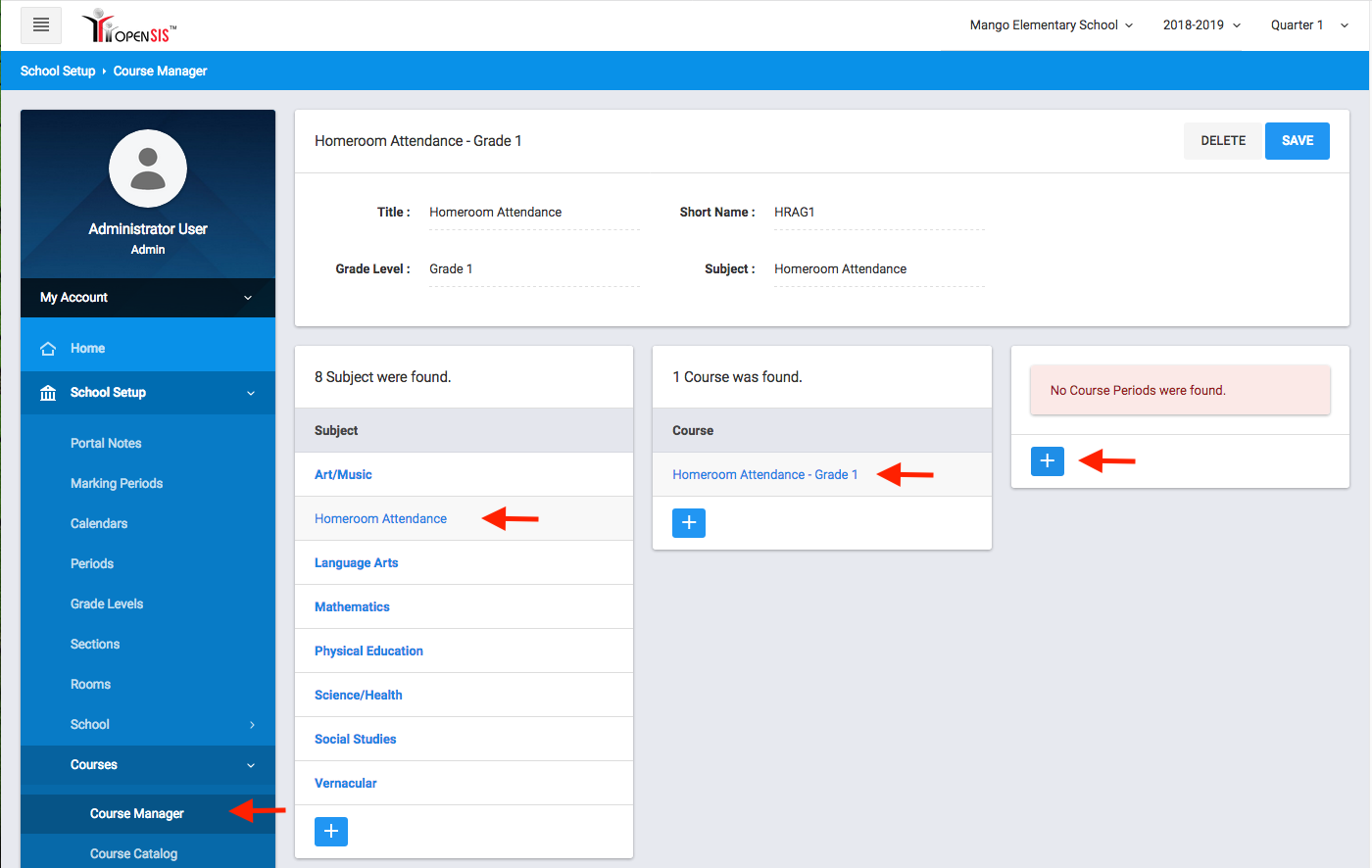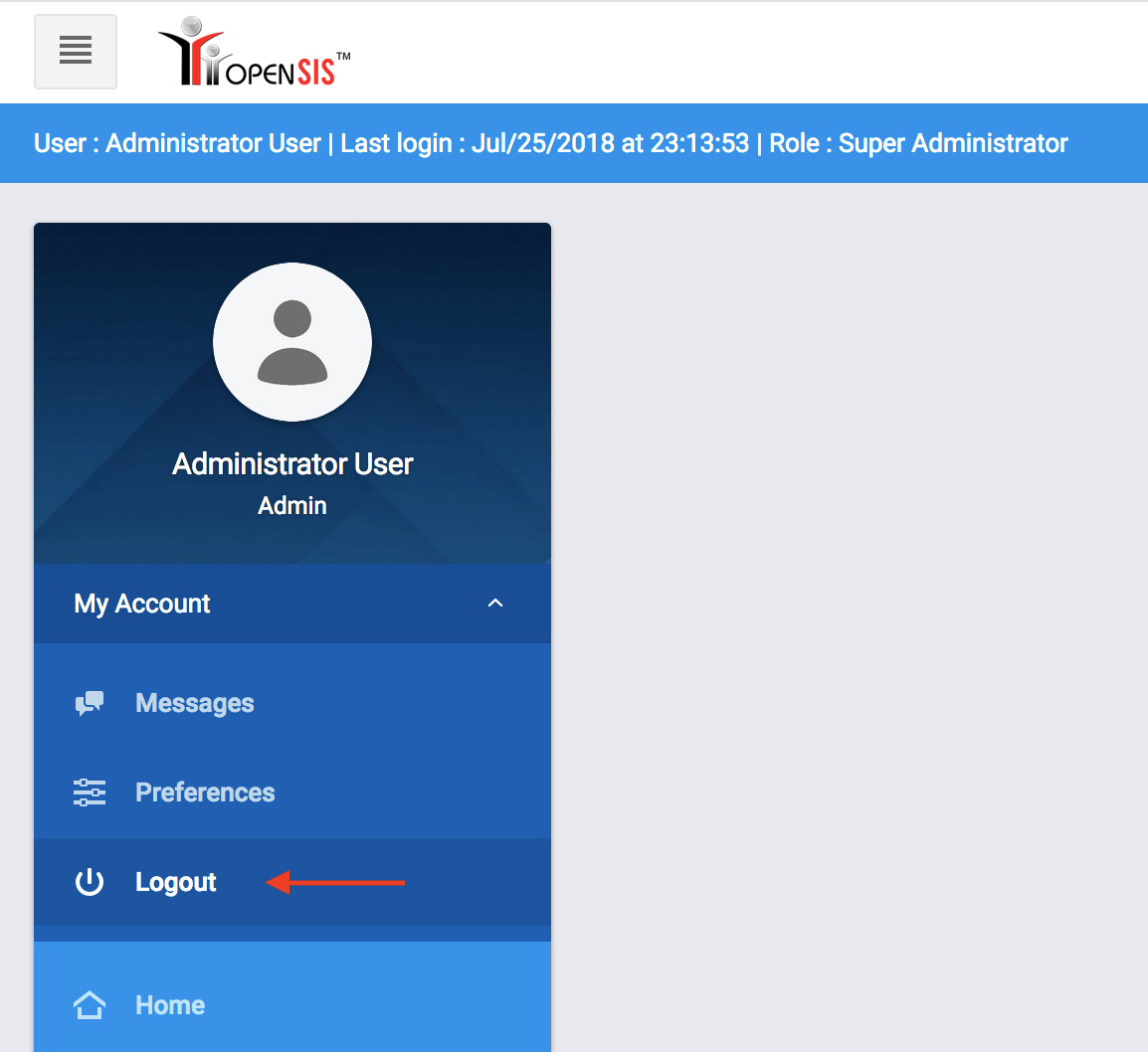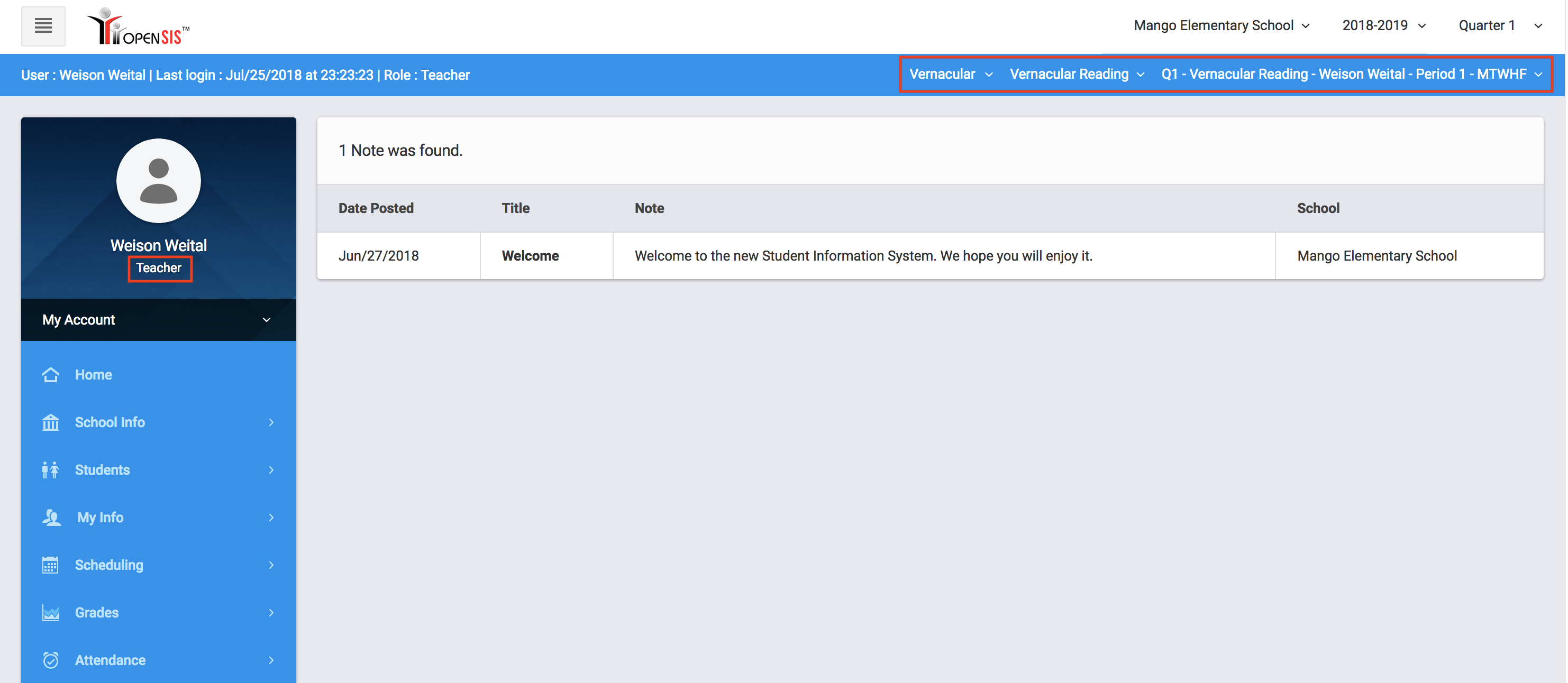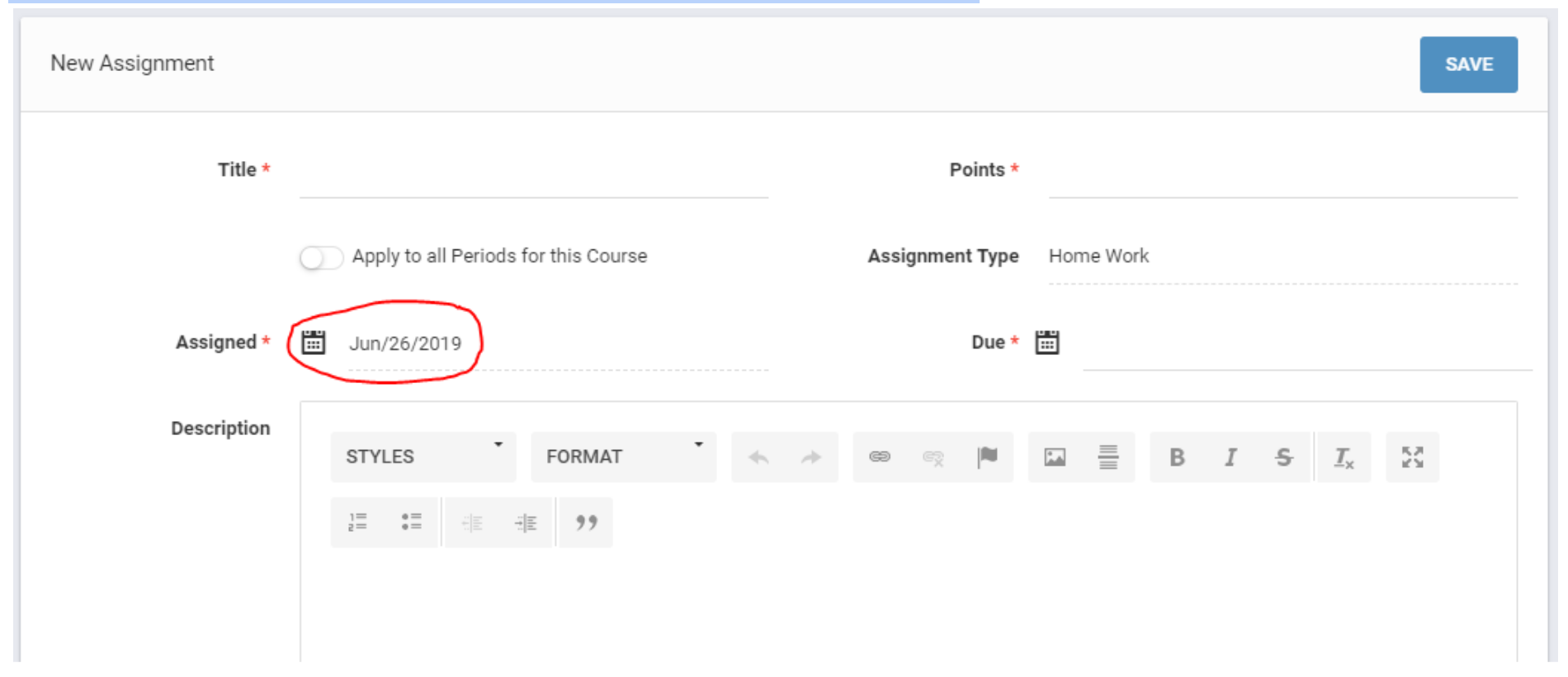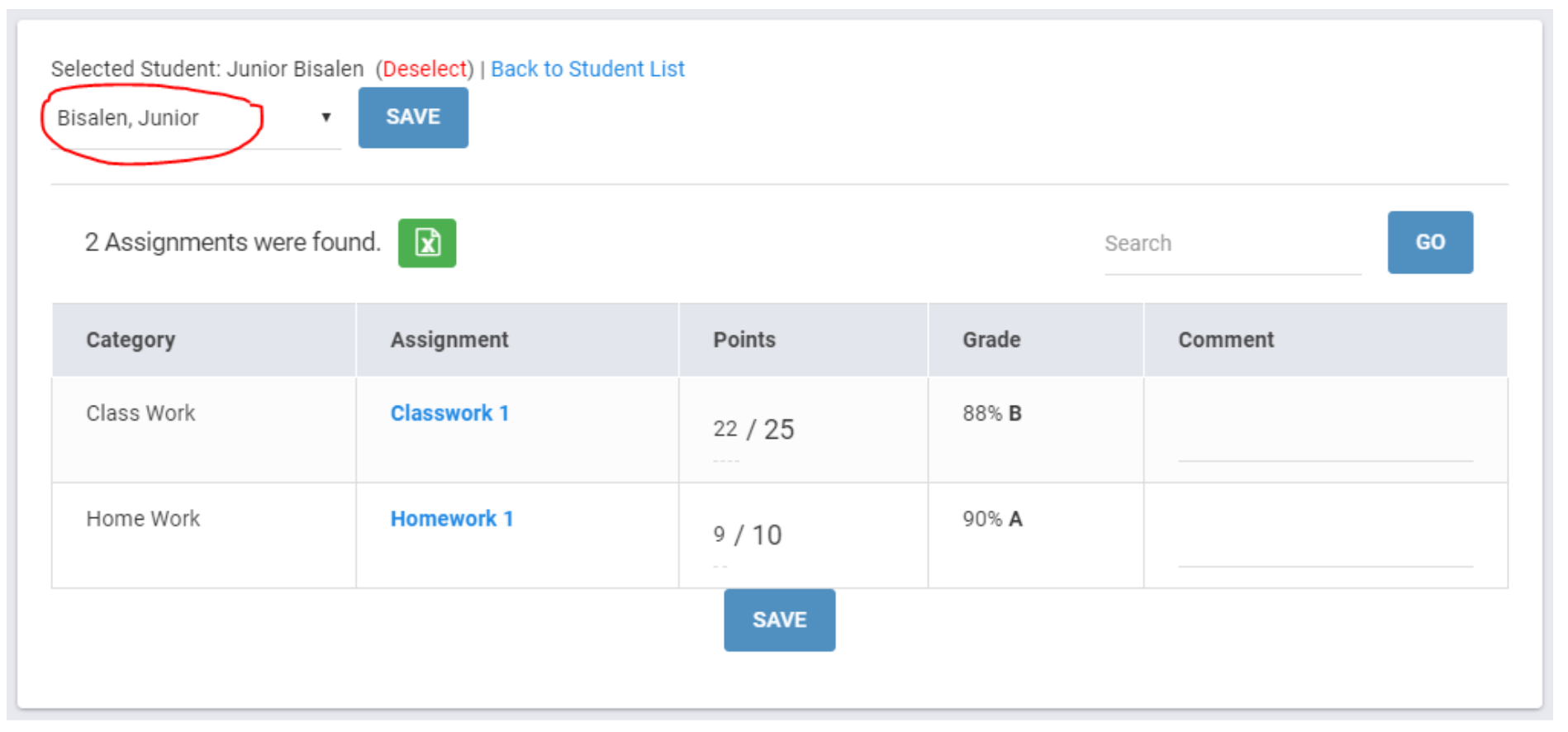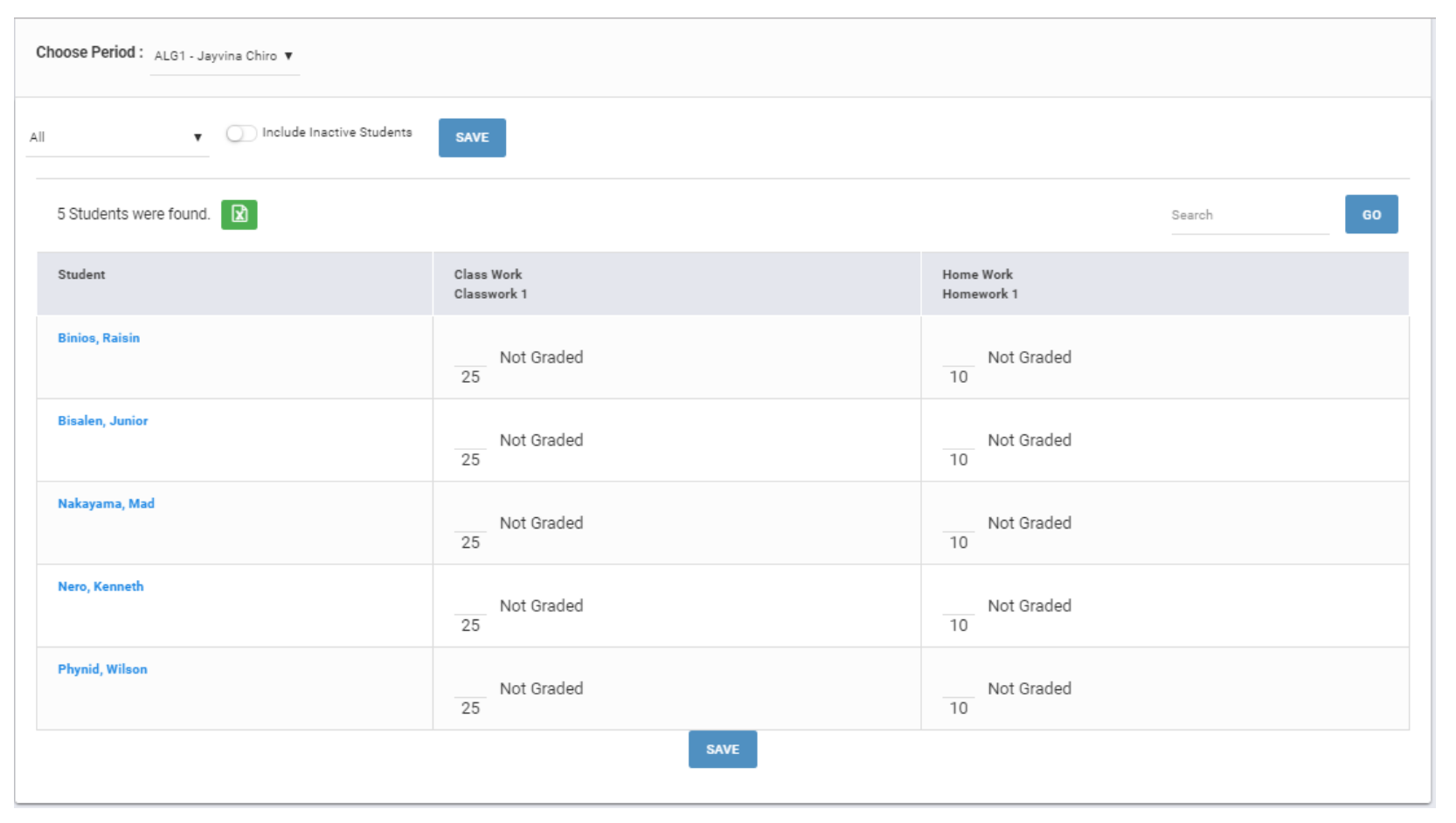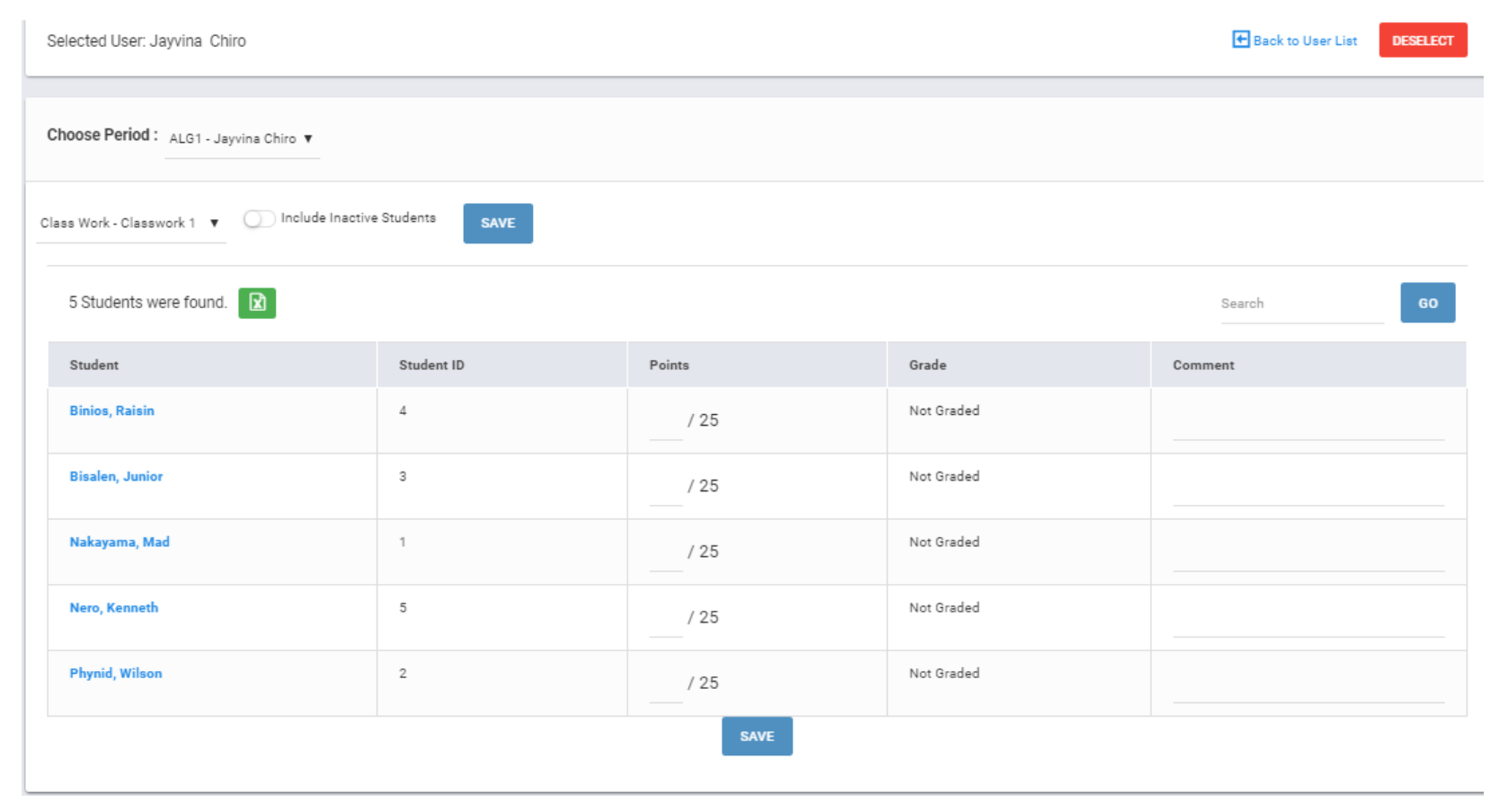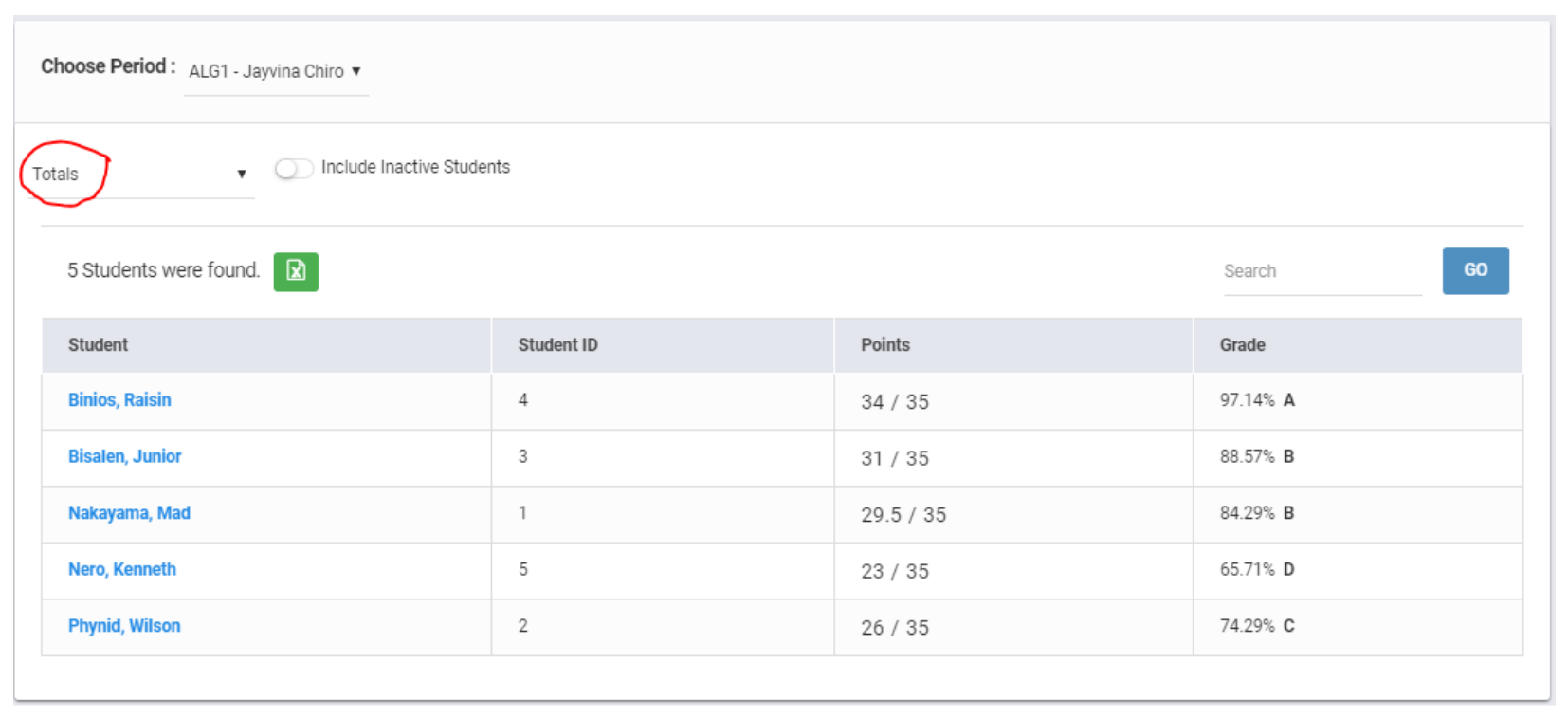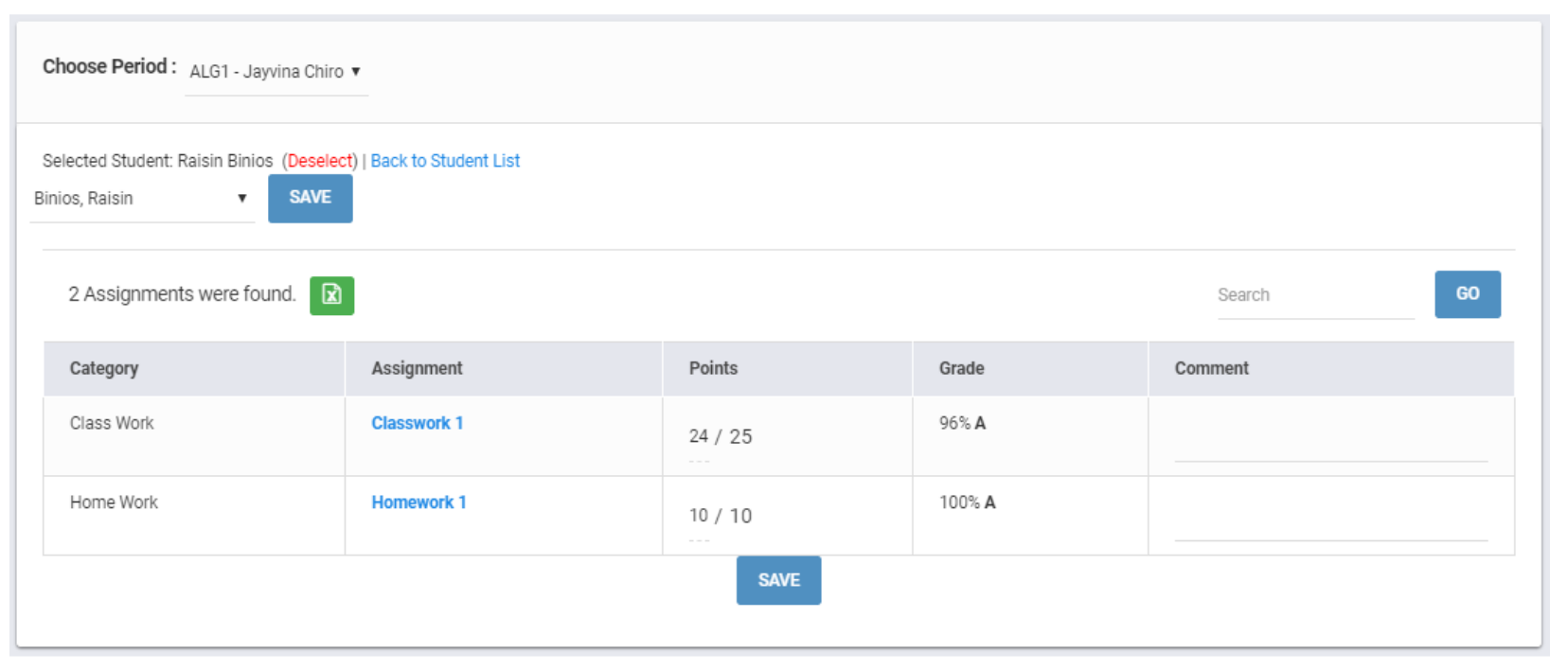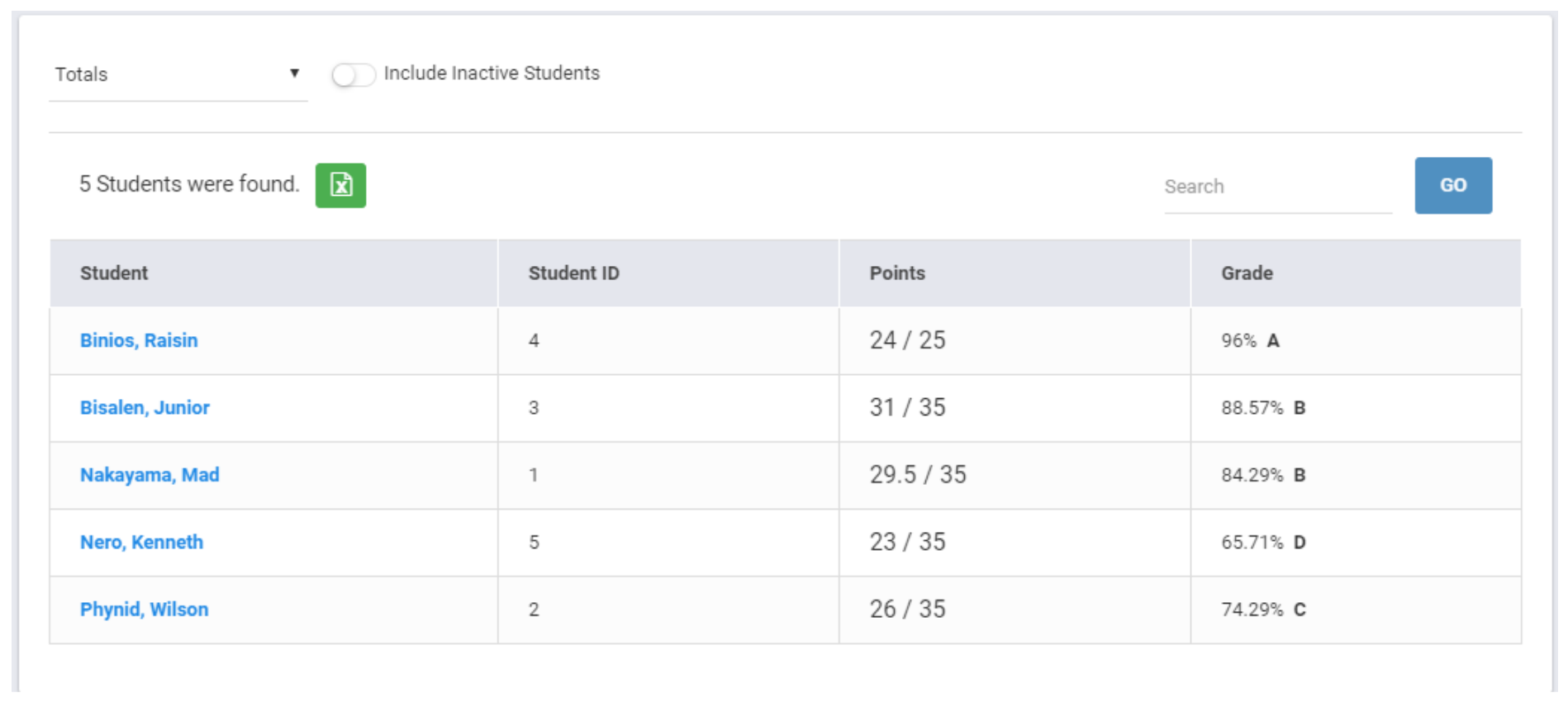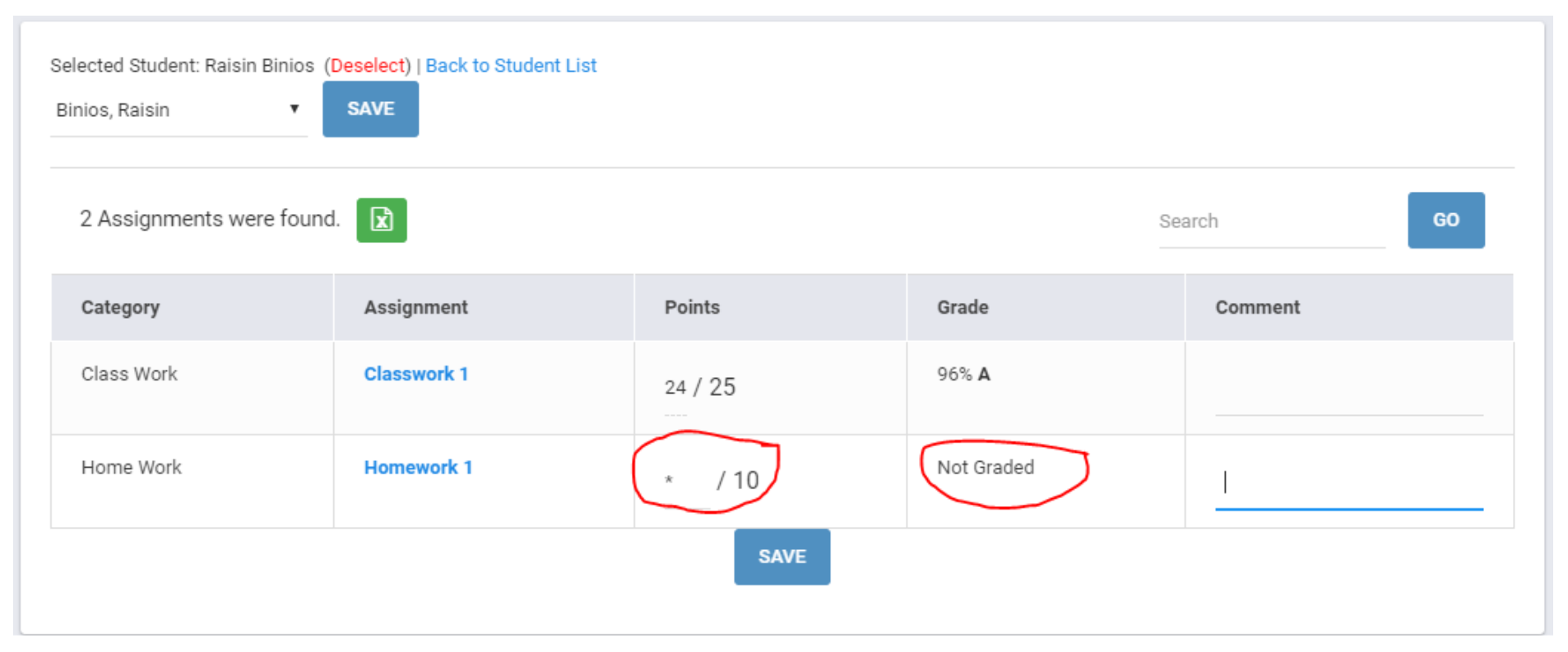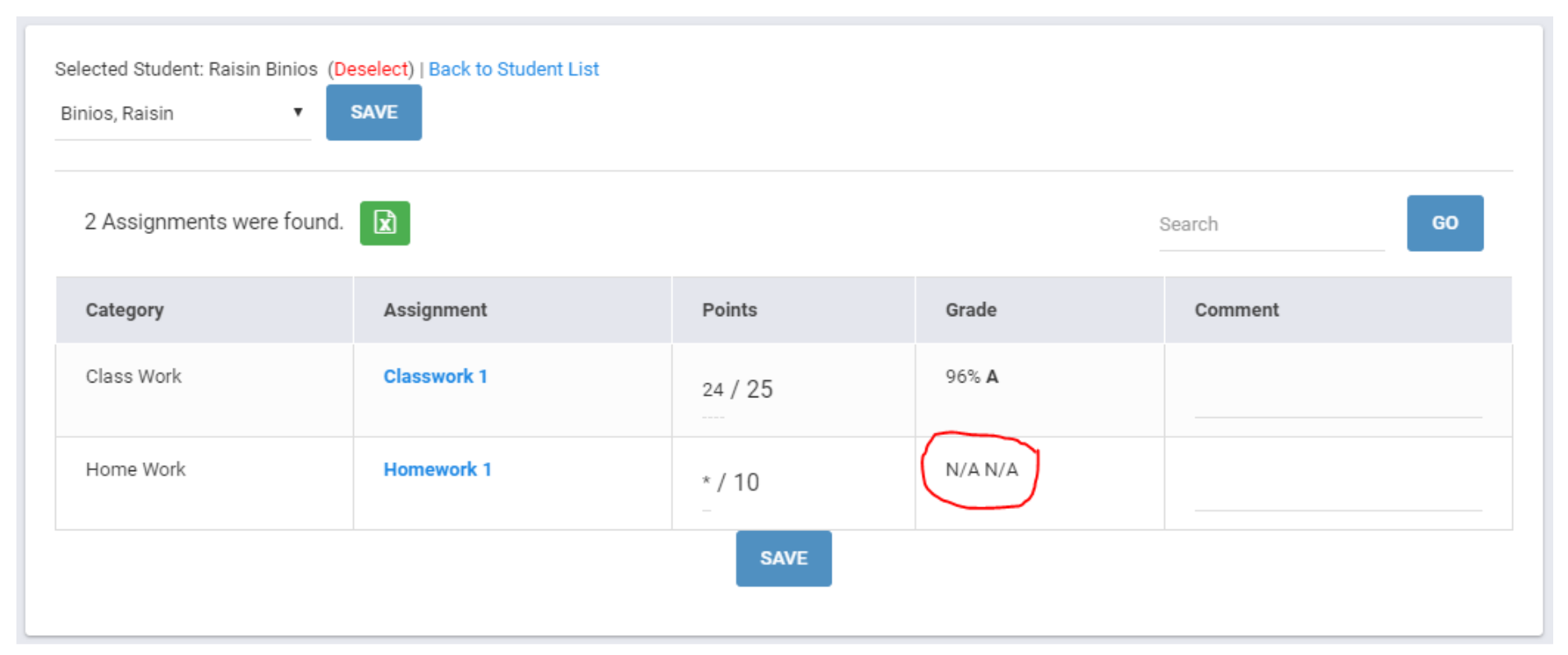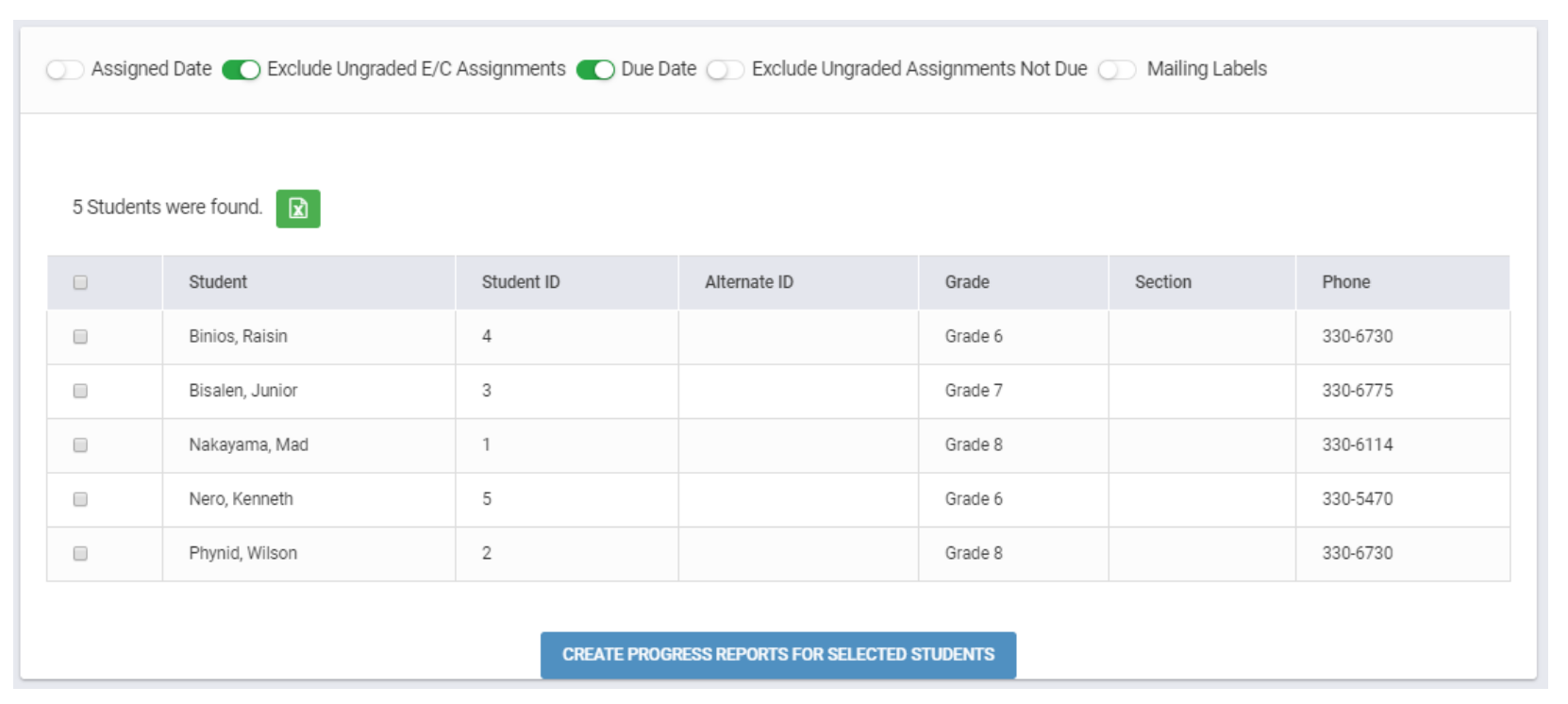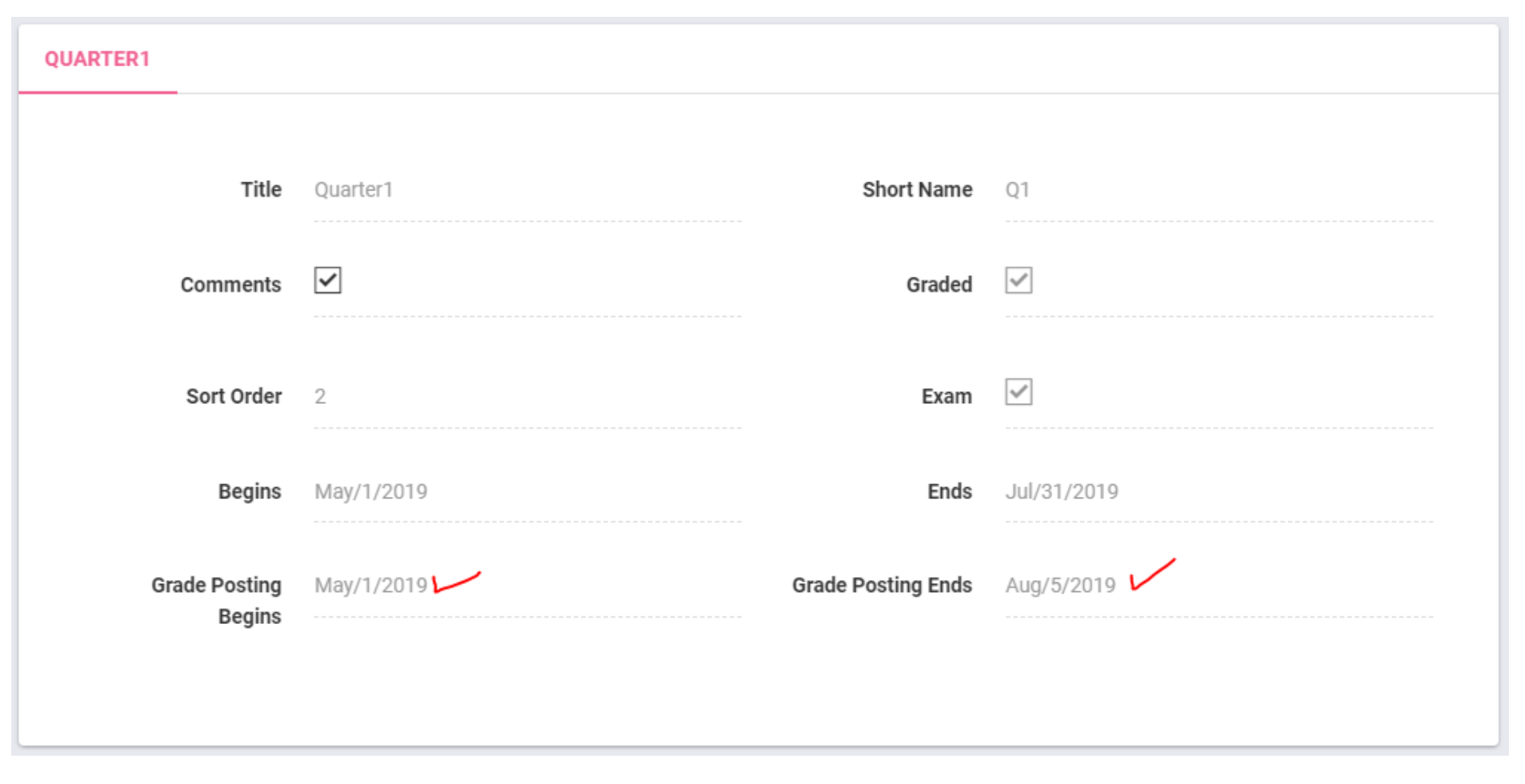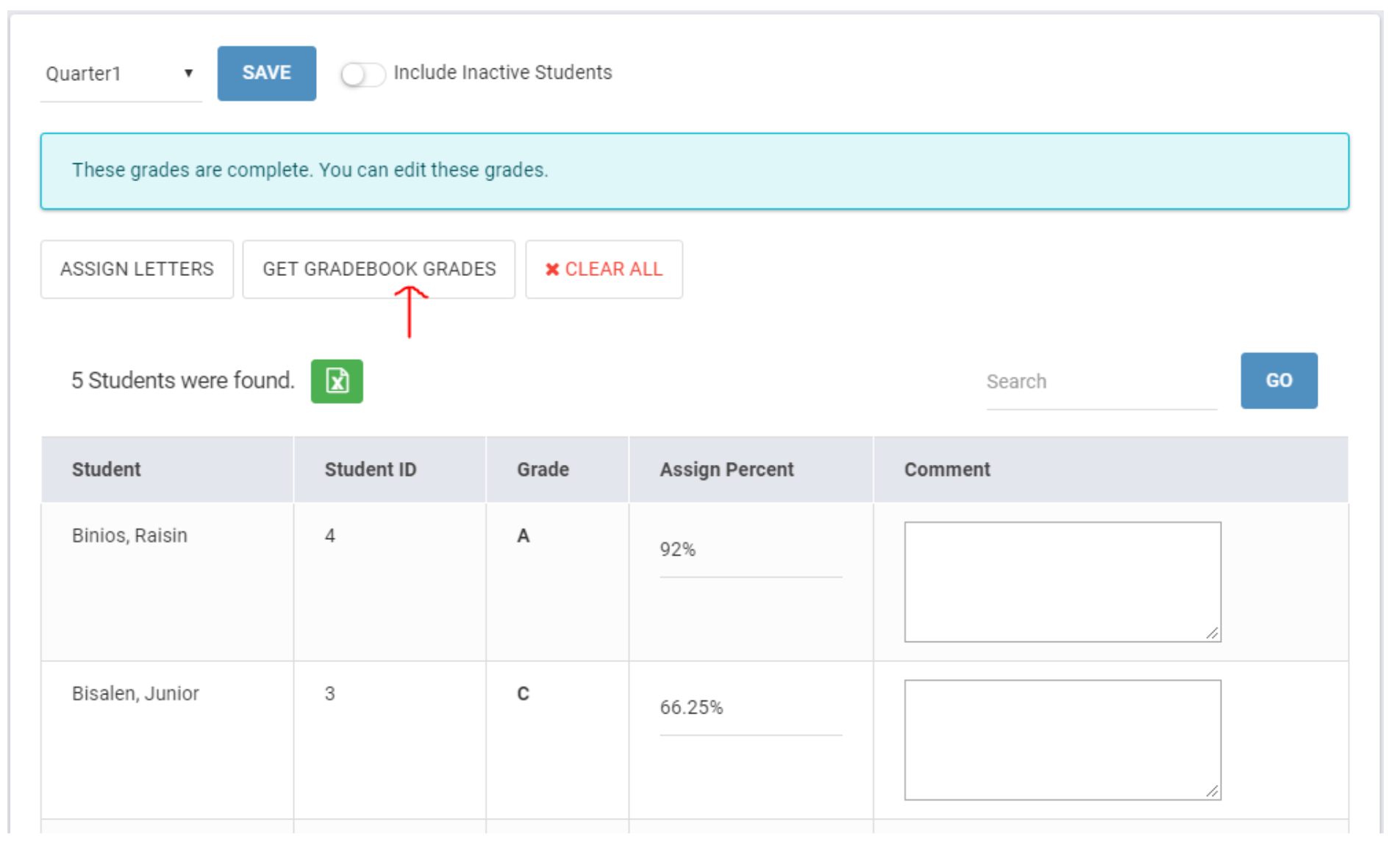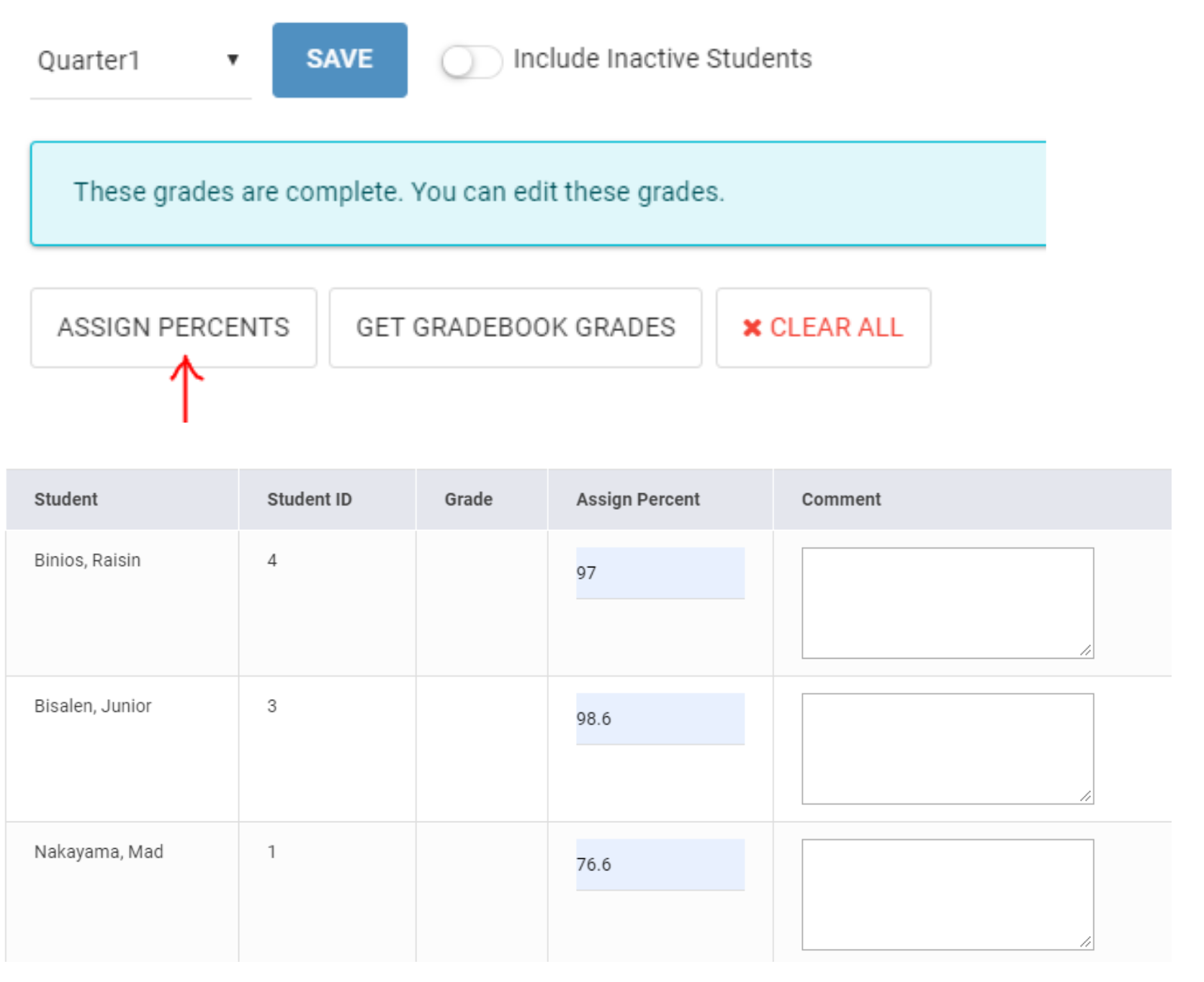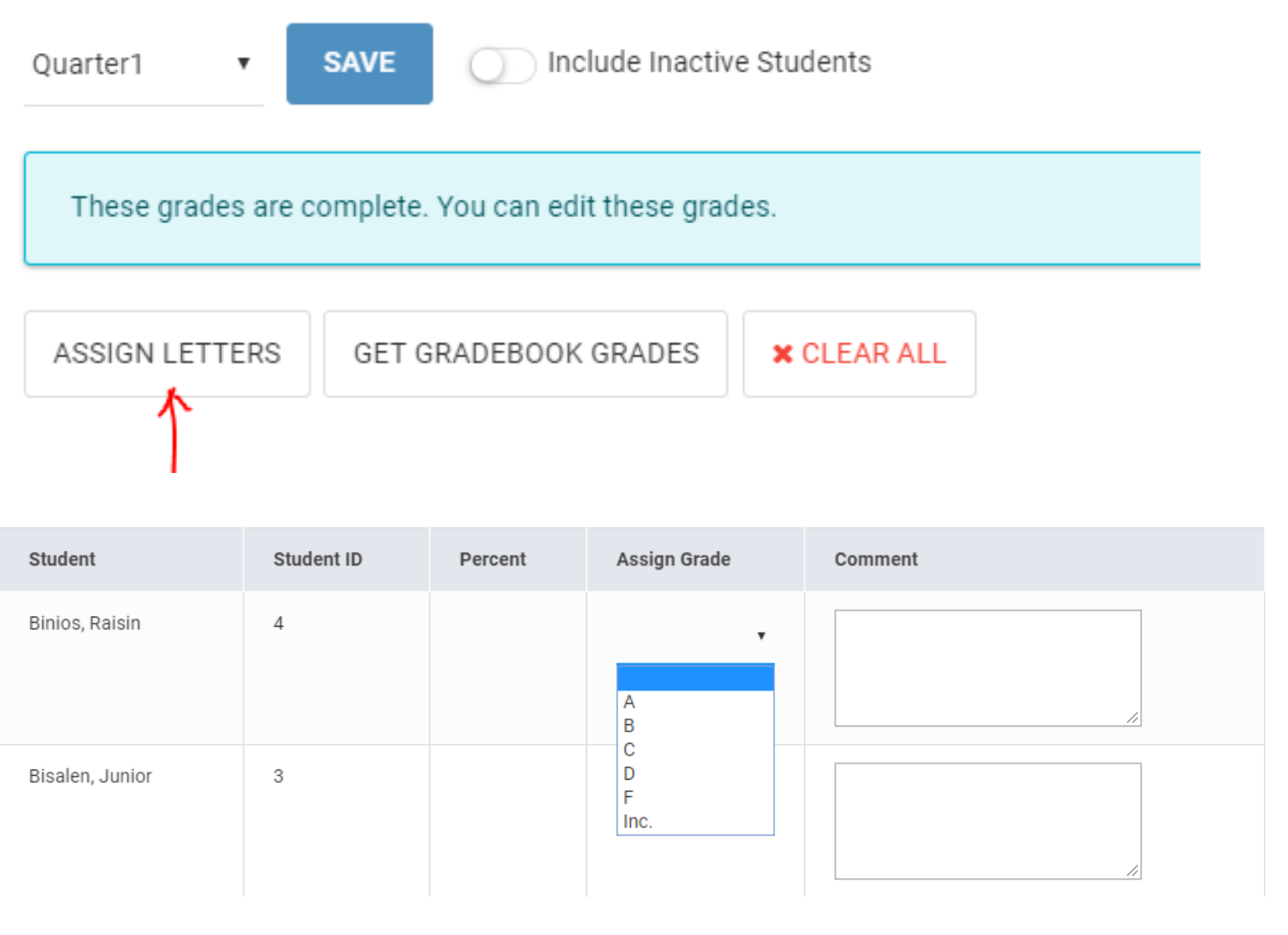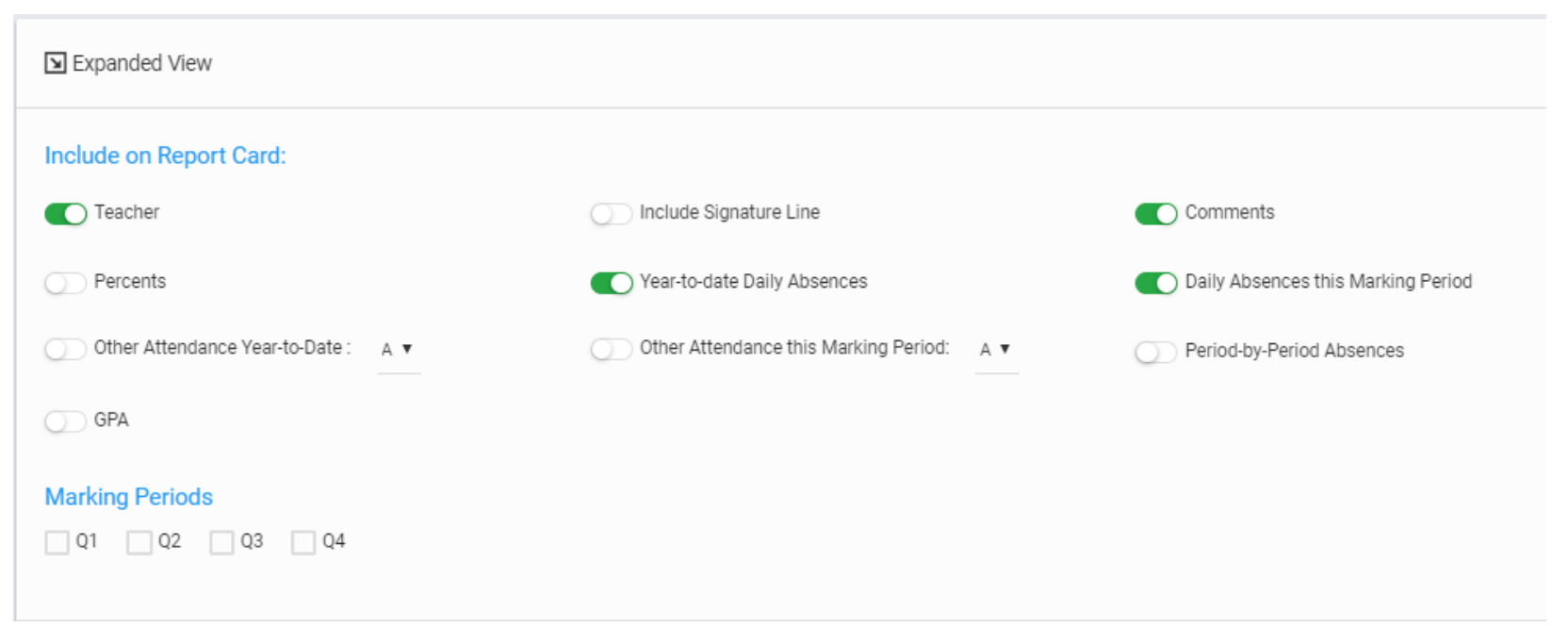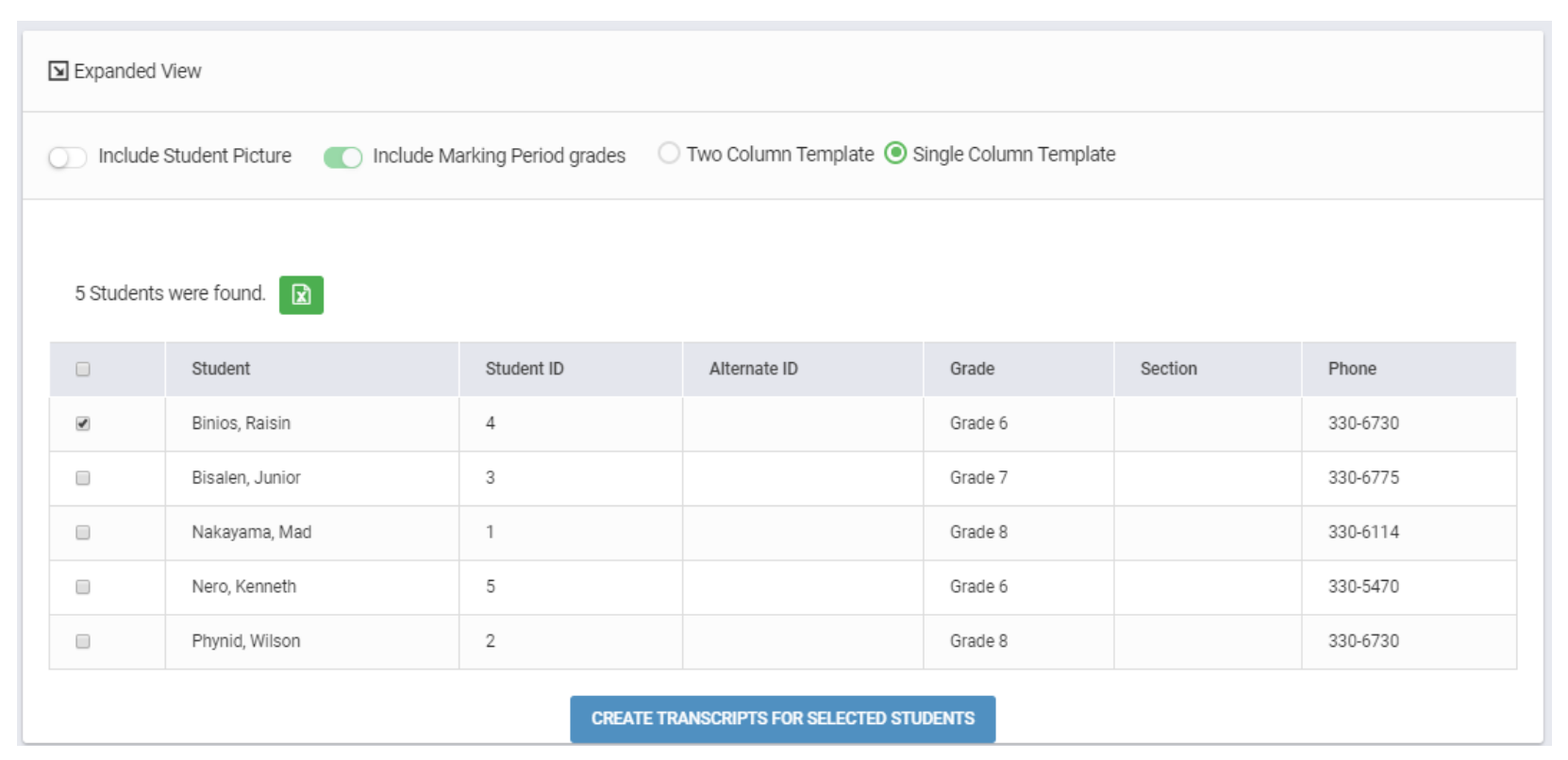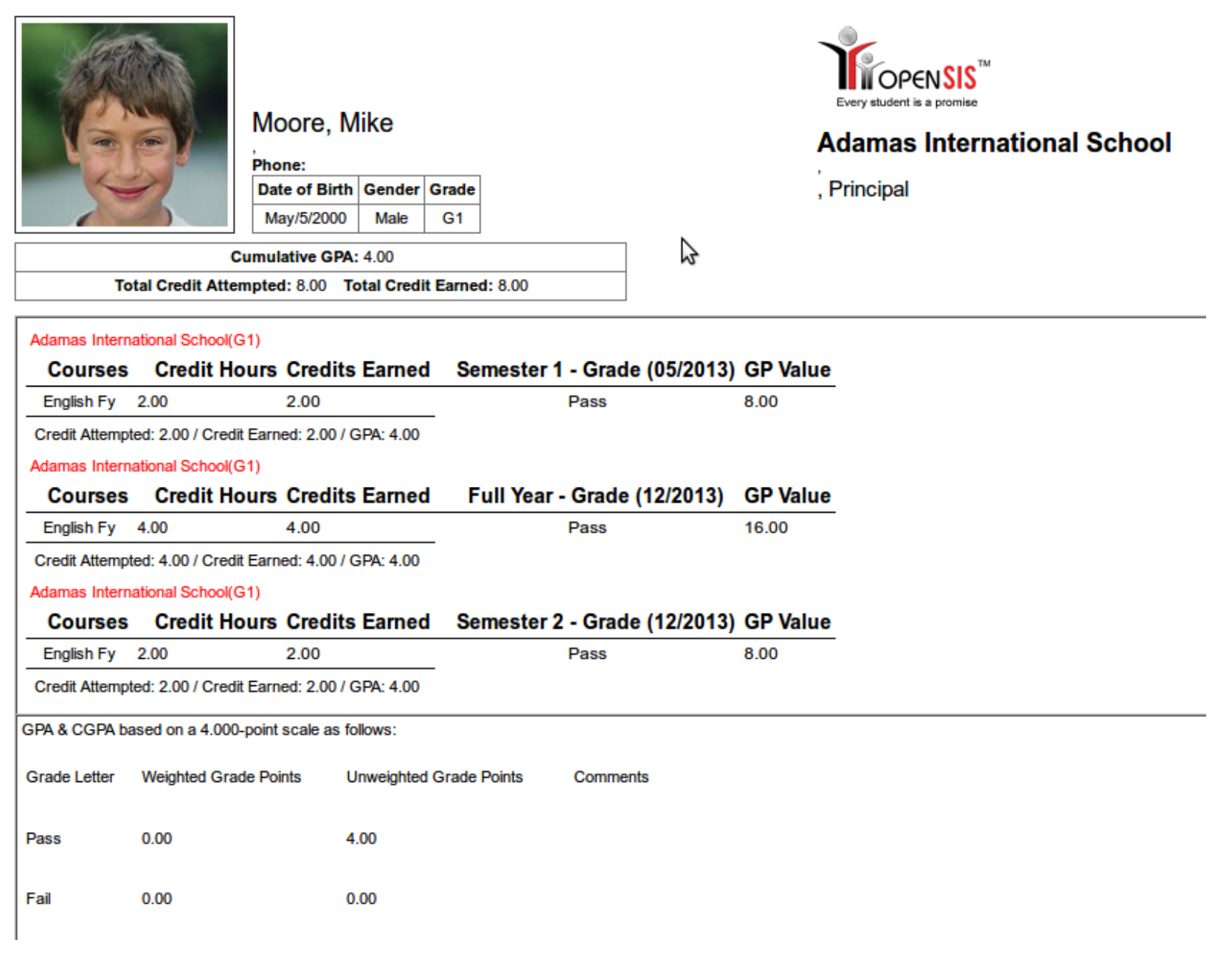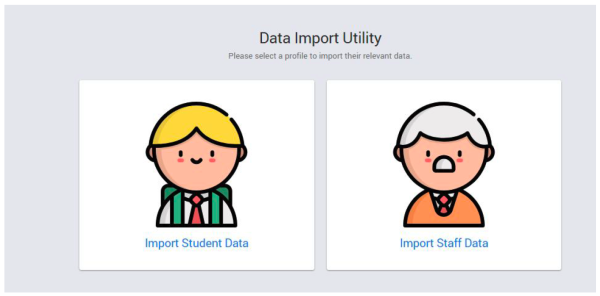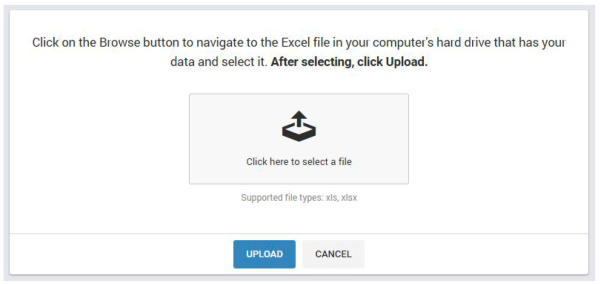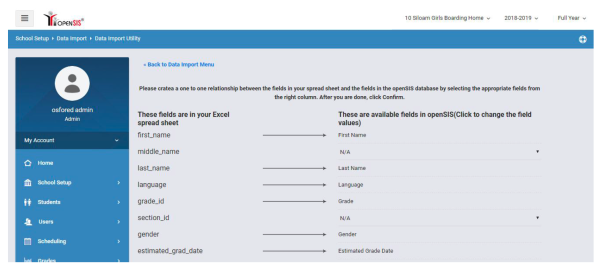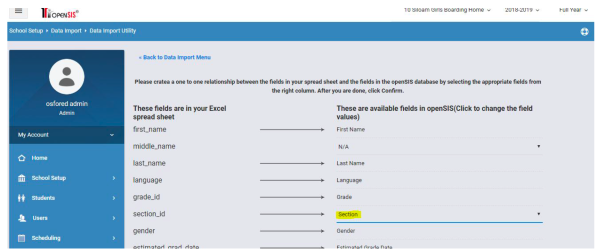Table of Contents
Student Information System User Guide
This is the user guide for the Student Information System used for training and as reminder reference for people using it.
School Setup
This section explains how to setup or model your school.
Create a New School
You create a school in School Setup → School → Add a School as shown below. Enter the information for your school and click Save.
You will then be able to switch between schools (if you are logged with a user with permission to do so) from the top right as shown below. You can also look at the school info that is selected.
Portal Notes
The Portal Notes page is an announcement feature for the admin to communicate messages to the other users like teachers, parents and students; the message will display on the homepage of the user’s portal. Users can access their portal from a smartphone, tablet, laptop or computer with access to the SIS.
To access this page, go to School Setup → Portal Notes.
You can make the text appear for a certain period of time by selecting begin and end dates. You can also control who gets to see the message by clicking on the Visible to options.
For example, if you want only parents to view the message, click Visible to Parent.
You can then delete notes using the “X” button and add new ones as shown below.
Create Marking Periods
Marking Period is the time division of the entire school year. For setting up the marking period go to School Setup → Marking periods. At first, the Full Year is already created with a Start & End date which had been entered while installing the school for the first time. Now the full year needs to be divided into semesters & quarters as per school requirements.
Start by creating your semesters. click on the “+” and fill out the Title, Short Name, Marking Period Begins & End date and Grade Posting Begins & End date for that marking period. Grade posting begins & end date indicates the span of time in which users can input final grades.
In other words, for a training in July you could use the following scheme for a school year. Simply replace the year.
- Calendar Year ⇒ 1 July 2018 – 30 June 2019
- Semester 1 ⇒ 1 July 2018 – 31 December 2018
- Quarter 1⇒ 1 July 2018 – 30 September 2018
- Quarter 2⇒ 1 October 2018 – 31 December 2018
- Semester 2 ⇒ 1 January 2019 – 30 June 2019
- Quarter 3⇒ 1 January 2019 – 31 March 2019
- Quarter 4⇒ 1 April 2019 – 30 June 2019
There are three check boxes:
- Graded: By checking a marking period ‘Graded’, grading option is allowed and you can enter final grades for the courses which run for that marking period.
- Comments: By checking the ‘Comments’ box, teachers and administrators are allowed to enter Comments while giving final grades.
- Exam: Exam option should be checked when you want to take a physical exam at the end of a marking period. Checking the Exam box will allow the teachers and administrators to enter grades manually for this exam.
With your semesters in places you can create their respective quarters. For example, to add quarters in Semester 2 you need to click on Semester 2 and then the + as shown below.
Calendars
Create Default Calendar
Create a calendar for your school in School Setup → Calendars → Create a new calendar.
You can create as many different calendars as you want. You could create a calendar specifically for teachers for example but for simplicity's sake one should suffice. Call it Default and check mark Default calendar for this school. Enter the From and To dates, the days of the week and who the calendar will be visible to.
When complete you can see your calendar as shown below. School days will be shown in light blue while non school days in pink. You may have to change the month to a school month to see this.
Creating a Holiday
If you need to mark a day as a holiday, simply uncheck the checkbox for that meeting day with a double click & save it. That day will become pink denoting a holiday. If you click on System wide this unchecked holiday would also copy to all your other calendars and other schools in the system.
After saving the holiday should be in pink as shown below.
Create an Event
To add an event on a calendar, click on the (+) sign.
A new pop up window will open up. Enter the date, title & notes and save it. If a system has multiple schools and multiple calendars, then the Show Event System Wide check marked will copy an event to all other calendars. So you don’t need to create it repeatedly.
The event information is saved. You can edit it by clicking it.
It will also be show on the calendar and on the portal page of the selected users for that calendar.
Delete a Calendar
To delete a Calendar from the school, click on the “X” button as shown below. If the calendar does not have any association (like students or course periods created in it) you will be able to delete it. If the calendar has been associated with the students or course periods, it will show a message stating, “Calendar can't be deleted as it has association”.
You will be asked whether you are sure you want to delete.
And if you only had one calendar you will be left with none as shown below. But you do need a calendar!
Edit a Calendar
To edit a Calendar click on the pencil icon as shown below and you are given access to edit the calendar title, check/uncheck default calendar option and select events visible to list as per preferences.
Creating Periods
This is the area where you define the time divisions of a school day, known as periods. To create periods go to School setup → Periods. Start entering your periods by filling out the last row with a “+” sign and then click 'Save' as shown below.
The Title, Short Name, Start Time, End Time are self explanatory. The Sort Order is merely used to arrange the order in the way you like. The checkboxes are explained below.
- Used for Attendance: Checking this option will allow the teachers to take attendance on that particular period when that period is associated in a course period.
- Ignore for scheduling: It is used to avoid period time clash while scheduling a student into 2 clashing course periods.
You can always edit any of the previously created periods if you need to. To delete a period, click on the X icon to the left of the period name.
Grade Levels
This section captures the different grade levels as per your school’s requirement.
Fill in the information from School setup → Grade levels and pay particular attention to the Next Grade field. When the school is rolled over at the end of each academic year, the students who are set to be promoted to the next grade are done according to the value you set here.
So, always set the next grade value as the one following the previous grade level.
Other than that, Grade Levels are created much in the same way as Periods.
Rooms
This section lets you to create and define numerous rooms in the school. Go to School Setup → Rooms and the page opens where you can enter the room title and its capacity along with a brief description.
After entering every room, click Save and to delete a room, you can click on the X icon beside the room title.
Attendance Setup
Attendance Code
As a one time setup you need to configure your attendance codes as per your school's policy. For example as below.
- Teacher & Office: means a Teacher as well as Office staff can enter Attendance for that code.
- Office Only means Office staff can only use that code.
Example use case of “office only”: A parent calls at 7:00 AM to the school’s front desk and reports that his child is sick and won’t come to school. The front office marks the Student “excused absence” ahead of time. When the home room teacher actually takes the attendance, say at 9:00 AM, she will see that that student is already marked excused absence by the office. The teacher does not have edit rights to the field.
Attendance Configuration
For the Attendance Chart feature to work you need a final step to complete the configuration of attendance. In School Setup → School → System Preference. In the Half-day and Full-day minutes you need to enter what it is at your school a full-day and a half-day. This will depend on how you setup your periods. The most typical use cases are:
- An elementary school creates a small homeroom attendance period to take attendance only one time in the morning. This homeroom period could be 15 minutes. Therefore a full-day would translate to 15 minutes and half-day to 7 minutes.
- A secondary school or any school taking attendance for each periods. Then to get your full-day minutes you would add the total minutes for each period of the day as you configured them in Periods. The half-day could be half those total minutes or you could define them as all the total minutes of the first 4 periods out of a total of 7 periods in the day for example.
Grade Scales
Grade Scales are created to enter letter grades with the actual scores. To create a grade scale go to Grades → Set up → Report card Grades. Then create a Grade Scale with a name, maximum scale value and sort order and click on Save.
After the grade scale is created, letter grades need to be entered as per requirement as shown below. Just keep on adding the rows and clicking Save.
Put the Title, Breakoff, Weighted GP value, Unweighted GP value & sort order & then click on save. The Breakoff fetches the letter grades as per the scores. Here, A=90; when a student gets 90 & above he will be entitled to get an A. The Weighted GP Value is entered to calculate GPA of the weighted courses (where “Course is weighted” option is on). The Unweighted GP Value is entered to calculate GPA of the unweighted courses (where “Course is weighted” option is off).
Basically, creating this section would help to get the letter grades on the report card and to calculate GPA while creating Transcript.
User Management
Users is where you manage staff and also optionally parents of students. Students are managed elsewhere.
Adding a new staff
To add new Staff (e.g. Admin, Teachers and other Staff) in the system, go to Users → Staff → Add a Staff. Fill up the information and click Save.
Fill up the school information. This is where you assign roles such as teachers, administrators and non-teacher staff.
Click Save and you will then see the school the new staff is assigned to. This could also be changed is desired.
Finding existing staff
You can find staff using a number of fields. Example below finds a staff with Last Name.
You would retrieve all staff with Last Name searched as shown below
You can also list all Teachers as shown in the following two illustrations.
Customize staff field
You may have a need to record more information not available by default. You can do this in Users → Setup → Staff field. For example, click on Certificate information and you see a list of all the existing fields under it. If you want to add a new one click on the + icon.
Then enter your new staff field category. For example, Qualification information. Then click Save.
You can then add more fields inside the new Qualifications information by clicking on the + icon.
One by one you can add the fields inside Qualification information. You can assign them various type such as text, dates, etc.
Finally, go into one of your staff and see the new tab Qualification information and the fields where you can enter some new custom data.
Courses
Course Manager
To be able to assign students to courses (or any learning period in class,) mark attendance and grade student you must create subject, courses and course periods.
- Subjects: think of subject as simply a high level way to organize your areas of study (e.g. Mathematics, Arts, Social Sciences)
- Course: are individual courses taught at the school (e.g. for example in Mathematics we could have courses in Geometry, Arithmetic, Calculus)
- Course Periods: are what define what course is thought by what teacher in what classroom and at what time.
First define some Subject or general areas of studies as shown below. Below the subject “Social Studies” is being added.
Then for each subject you can create courses inside the subject by clicking on the subject and then the + icon under courses. Below we add a physics course for Grade 8 under the Science/Health subject.
The following is what you see after creating the course.
Final step to be able to assign students, grade them and mark attendance is to create the course period. You select which course you want to create a course period for then click on the + icon under course period.
Fill out the Course period details as per requirements. The following are the description of various functionalities in a course period. You need to be careful while filling the details here as it holds great importance while evaluating the final grades, class ranks, etc.
- Short Name: a short name/title for the course period;
- Calendar: select the calendar to be followed; Primary Teacher: select the teacher for the course period;
- Secondary Teacher: select the teacher, if required (since it is not mandatory). It is provisioned to schedule two teachers in a course period;
- Seats: number of seats available for the students for this course period;
- Grading Scale: any grading scale name that the school system uses;
- Credit Hours: if the course period is credit bearing, you must fill in the Credit Hours for the transcripts to show the completed credit hours for a course;
- Gender Restriction: mark the desired set of students based on gender (if required) so as to restrict the scheduling of opposite gender students in a desired set of course period;
- Parent Period: choose a parent period for this course period so that at the time of scheduling, that parent course period stands compulsory to be scheduled first before this course period. For instance, if there are course periods named Theory (CT) and Practical (CP) under a course named Chemistry, you can mark CT as a parent period in CP course period. Now, at the time of scheduling, if you try to schedule CP first, you’ll be notified to schedule CT instead, as CT is marked parent period in CP course period;
- Allow teacher Gradescale: To allow teachers to override the school’s grade scale and to use their own, check this option. Checking this option would allow the teacher to create their own grading scale for the selected course period. Also, Score Rounding can be configured from teacher’s portal if this option is checked;
- Course is weighted: check Course is weighted if this course period needs evaluation based on weighted GP value;
- Affects Honor Roll: check Affects Honor Roll if you want the course to be counted in the honor roll;
- Half Day: When this option is checked, it entitles the student scheduled in this CP to retrieve half day minutes which overwrites the actual CP’s per class minutes when the student attends this CP.
- Affects Class Rank: mark the checkbox if you want this course period to be counted for class rank evaluation.
- Choose the Duration: you can choose the duration either from the demarcated marking periods or a Custom period range (say a month or some days)
- Choose Schedule type: you can choose any of the three options as per the system requirements.
- Fixed Schedule: it enables you to choose a selected period for selected number of meeting days that continues in the same routine for the whole duration range that has been marked above. Select a Class room and the Period from the drop down list (the list must be created while setting up the system), check the Meeting Days you want the course period and lastly, to enable the course period for attendance, check the Takes Attendance checkbox. After filling all the details, click Save button in this page and the course period will be created.
- Variable Schedule: it enables you to choose periods invariably for all the days in the duration of the course period. Select a Day, Period, Room and check Takes Attendance to validate the course period for marking attendance. Now, click Save and the page refreshes with the entered course period details and alongside will show a (+) sign, beneath the variable schedule, to allow adding of more periods and days similarly.
- Enter by Calendar Days: This schedule type lets you to choose selected dates in the chosen duration. For instance, if you have a course period that you don't need it regularly as other learning lessons like a test period, you can enter particular dates by the calendar for that test period. To do so, after filling out the above details, select Enter by Calendar Days.
When done click Save as shown below. After saving you should see as below with a new course period.
Note that note all the course period you will create will be showing in the Course Period. For example, if you create a course period for Physics meant to be delivered in second semester but you are in Quarter 1 (inside semester 1) then it will not show. You can have those show by switching yourself to the Quarter 3 or Quarter 4 as shown below and then again going to School Setup → Courses → Course Manager and locate your course period.
Course Catalogue
You can browse your course periods by going to School Setup → Courses → Course Catalog.
You can filter which one to display. For example, below we are filtering first by the marking period. Then you can filter further by subjects and even further by courses.
Print Catalog
It might be useful to print the catalog sometimes. You can print the catalog in a number of ways by going to School Setup → Courses → Print Catalog by Term, School Setup → Courses → Print Catalog by Grade Level and School Setup → Courses → Print all Courses. For example, below we print catalog by term Quarter 2
And the result we get is the following in a new browser tab ready for printing if desired.
Teacher Re-Assignment
If you need to re-assign teachers after the school year is under way and you whole catalog has already been created you can do so in School Setup → Courses → Teacher Re-Assignment. For example, a teacher is transferred to another school, leaves the country or is otherwise no longer available and must be replaced by another.
Students
Student Info
Go to Students → Student Info to find your students. At first you will have no students. So clicking on Submit as shown below will result in no students found.
Add a Student
You need to add your students in the system one by one carefully. You do this in Students → Add a Student. Fill up at least the basic information of the student.
Pay particular attention to the student enrollment information as shown below. The options are explained below.
- Next Grade at Current School By default this option is selected which means when you rollover the data to the next school year, the student in 1st Grade would be promoted to 2nd Grade in the same school.
- Retain you can retain a student (if failed) to the same Grade level he/ she are in after rollover.
- Do not enroll after this school year can be used when a Student is graduating; the student’s data are not rolled over to the next grade in the coming year.
- School Name If you have a multi-school database, you will have the option to select any of those schools from this dropdown list to move the student directly to another school after rollover.
These options should be selected correctly to get the proper student data in the next school year. At the bottom of the Enrollment Information you get an enrollment record of the student over the years.
- Start Date indicates the enrollment date;
- Enrollment Code you can give an enrollment code to describe how the student enrolled in your school; for instance, this could be a new student coming to school, an existing student that has been rolled over into a next grade (or same grade), or transferred in from another school.
- Drop Date can be used for students leaving the schools
- Drop Code with a code of Transferred out, rolled over and dropped out.
- School the school in which the enrollment record is.
Finally, click on Save to proceed.
You can enter the student address in the following tab. There you can also assign a parent or guardian of of the student and optionally allow that person to have access to the system and various information such as events and student's attendance and grade.
Optionally, you can also include the students medical information, comments, goals and upload files.
Student Group Assign Info
This feature is used to assign some student information in bulk. For example, selecting a list of students from grade 10 to be in a section called 10A. It can useful in a number of cases. For example, you might have loaded all your student in the system but you did not know the section. In that case you can group assign the section to your students.
Here is how. We will in the example below assign section 10A to a list of grade 10 students. First go to the Student → Group Assign Student Info as shown below, filter for all your grade 10 students and click submit.
You should see a list off grade 10 students like below.
From the list you select the ones you want to group assign some information. For example, below I select a list that should be in the 10A section. In addition to selecting the list of student you also define what information you want to give them. In the case below it is section 10A as shown in the red rectangle.
Scroll at the bottom and when ready click on Assign Info to Selected Students.
You should see the following successful message if all went well.
Student Re Enroll
Student Re-enrollment option is used to enroll a dropped student. Sometimes, students drop out from school & re-enrolls again into the school. When a student is dropped from the school, The system keeps that student's data as an inactive student. In this case, if you again create the same student's data there will be two students with same data but with different student ID. System will consider them as separate individuals. To avoid this, we need to use Student Re-enroll to re-admit the dropped student.
More information can be found at following link until this is documented here with new version.
https://support.os4ed.com/hc/en-us/articles/201048146-How-to-Re-enroll-Students
Scheduling
This is where you can define what student takes what course so that you can later mark attendance and grade student carefully for each courses.
Student Schedule
You can assign courses to individual students. Go to Scheduling → Student Schedule to get the below and either click submit to get all students at your schools or search for a specific one.
Click on the student you want to schedule a course for.
You will be under the student's schedule page. There you can add courses to be taken by the student by click Add a Course.
This will open a window where you can browse your courses and select one. In the example below the student is a grade 1 student we are adding the Vernacular Reading Grade 1 course.
You should then see the new course that the student is enrolled to as shown below.
View Schedule
Is merely to shown in a print friendly format the student schedule. The student we just added to a course above would look like this.
Group Schedule
You will most likely want to schedule student several at a time instead of one by one which would become tedious. You can this in Scheduling → Group Schedule. Click on Submit to get a list of all your students as shown below. The example below we are adding the grade 1 students to the Math course in Quarter 1 with David Syne as teacher.
Drop from Schedule
You can either drop a single student from a course or drop groups of students from a course. You can also completely delete a schedule for a student if it was added by mistake. The difference and how to achieve both is explained at the following link.
Attendance
The system can record attendance in flexible ways. For example, you could have a single homeroom attendance in the morning to mark your student attendance which may be more suitable for primary schools. In secondary school you may want to mark attendance for each individual courses as students are getting old enough and may choose to skip individual schools without telling parent.
Homeroom Attendance Course Period
If you followed this user guide then only the “Homeroom attendance” period can take attendance because it was configured as such in School Setup → Periods. So in this case we would need to create a course period to mark attendance during the homeroom attendance in the morning.
First, again in School Setup → Courses → Courses Manager create a new subject “Homeroom attendance” with a course inside “Homeroom attendance” and finally a course period inside the course.
Create a course period just like any other course period but making sure you enable “Takes attendance” at the end. While the marking period could be a semester or quarter it is common to mark attendance throughout the full year in the same way.
Take Attendance
Teachers typically take attendance for their students. So if you followed this guide you should logout as shown below and login again with a teacher.
Then set yourself to the homeroom attendance course period as shown below (or any other course period that takes attendance).
You should then be presented with a list of students scheduled in that course period and can easily take attendance.
Grades
You can record letter grades and percentage grades. In order to give letter grades the grading scale should be set up first.
Configuration of Grades
Before doing any grading related work a teacher has to set their own configuration choices that are much used while evaluating the gradebook grades or final grades. This setup varies with different course section. To setup the configuration, select Grades → Setup → Configuration and choose the course section from the top panel of subject, course & course section. Make changes to the options as per the teacher requirements.
Score Rounding:
- Up - When Up is selected, the grade will always round the decimals to the nearest greater integer. Example, 59.25 will become 60 or 53.67 will become 54.
- Down – When Down is selected, the grade will always round the decimals to the nearest lower integer. Example, 59.65 will become 59 or 53.15 will become 53.
- Normal – This is the regular rounding as we know, i.e. anything equal to or above .5 is rounded upwards and anything below .5 is rounded downwards to an integer without any decimals. Example, 53.67 will become 54 or 53.49 will become 53.
- None – When none is selected, scores do not appear in any rounded integer. It keeps the grade accurate including the decimal points, i.e. no rounding of the integer takes place. Example, for 59.25 it shall remain as it is.
Assignment Sorting: Select one radio button value so as to display the assignments in the respective order in the gradebook assignments.
Weight Grades: Check this option if you want the assignment grades to be evaluated based on a weightage. Once checked, you can add the weight percent in the assignment type.
The percent total of the weight grades can be less or more or equal to 100. The Grades will be evaluated based on the weighted percents.
Assigned Date Defaults to Today: Check this option if you want the assignment’s start date to reflect the present date by default. This option is mostly used when teacher usually creates assignment for the present date so as to skip choosing a date.
Due Date Defaults to Today: Check this option if you want the assignment’s end date to reflect the present date by default. This option is used when the teacher is hosting a surprise test in the class and it shall end the same day.
Calculate Eligibility Using Cumulative Semester Grades: Check this option if you want the eligibility status to be calculated based on the cumulative semester grades instead of the quarter grades.
Allowed Maximum Percent in Anomalous Grades: Enter the maximum value to mark the grades for being considered as anomalous,i.e. if it’s set to 100 then grades if given over 100 will be considered as anomalous.
Days until ungraded assignment grade appears in Parent/Student Gradebook views: Enter the maximum value to keep the ungraded assignment appear in Parent/Student gradebook view.
Default Comment code: You can choose a comment code to appear by default when marking comments for students.
Final Grading Percentages: The Final Grading Percentages helps to calculate the cumulative final scores for the respective marking periods. Here, as per marking period setup we have:
- Q1 = Q1 Gradebook Grades + Q1 Exam,
- Q2 = Q2 Gradebook Grades + Q2 Exam,
- Q3 = Q3 Gradebook Grades + Q3 Exam,
- Q4 = Q4 Gradebook Grades + Q4 Exam,
The grading percentages would fetch the cumulative scores from respective quarters for the semesters and from semesters to Full year. The final grading percentages should not exceed 100%.
Creating Assignments
Teachers can create assignments in Grades → Gradebook → Assignments and click on the '+' sign to create the Assignment Type. Give the Title & Weight Percent if required and save it.
After creating assignment type, create assignments under the selected assignment type by again clicking on the + sign marked in red. Give the title, assigned date, due date, points and description and save the details.
Teachers have to create assignments for every quarter for the course periods by changing the marking period drop-down from the top right. Example, for a full year course period assignments should be created for all 4 quarters. The assignment type gets copied in all the quarters for a FY or Semester course periods.
Entering Grades in Gradebook
To enter gradebook grades, go to Grades → Gradebook → Grades. Grades can be entered in three ways here. Selecting the All view from the drop-down enables the teacher to enter grades for the students in all assignments at the same time.
If you want to enter grades for a particular assignment, select that assignment from the drop-down list and grade the students for the selected assignment.
Also you can click on a student's name from any of the views and enter grades for the selected student in all his assignments.
Entering Grades in Gradebook on Behalf of Teacher
To give Gradebook Grades admin has to follow this path Users → Teacher Programs → Grade Book Grades. Then it will give a search box. Search for the particular teacher with the criteria or do a blank search to get the list of teachers in the school. From the list of teachers, select the particular teacher.
You will get a screen where from the top left hand corner you can select the Course Period. Now, gradebook grades can be entered in three ways here.
1) Selecting the All view from the drop-down enables the teacher to enter grades for the students in all assignments at the same time.
2) If you want to enter grades for a particular assignment, select that assignment from the drop-down list and grade the students for the selected assignment.
3) The Totals View shows the assignment score total with respective letter grades.
Also you can click on a student's name from any of the views and enter grades for the selected student in all assignments.
Admin can enter the grades or edit them if the grades are entered by the particular teacher in the same manner. After Admin gives the grades he will have to click on Save to keep the changes.
Exempting scores of an Assignment
If a student is not applicable in any assignment, that specific assignment can be exempted from the total points in openSIS. This feature is used when a student has joined the course later or is absent due to illness or for any reason based on the administrator's decision. To exempt a student from an assignment, go to Grades → Gradebook → Grades and select the student.
Now, enter asterisk(*) instead of entering any score for the particular assignment and save it.
For the selected student the asterisk marked assignment scores will become N/A.
The exempted assignment will not affect the total scores & the final grades.
The total score appears differently for the student with exempted assignment than other students. Student with exempted score for an assignment now appears 25 in point total whereas other students have their point total as 35.
Similarly, the exempted scores have the same impact on the final grades when evaluated. Exempted assignments list gets created under the Anomalous feature for the further reference of the teachers. Go to Grades → Gradebook → Anomalous and the details will appear.
Generating Progress Reports of the Students on Behalf of Teacher
When the teachers have created assignments and completed entering gradebook grades, a progress report can be generated for the students. Go to Users → Teacher Programs → Progress Reports and search the students with proper search criteria and click Submit. List of teachers appear and click on a teacher whose student’s progress reports are required.
Now, a search page for students will appear, click on submit to get a list of students scheduled with the selected teacher. Select the Course period, check desired options to appear in the report, check the checkboxes beside the students and click on Create Progress Reports for Selected Students.
The progress report for the student looks like the following.
Input Final Grades
Final grades can only be entered within the Grade Posting Period of the particular marking period/term which is set by your administrator.
The teacher can view these dates by clicking School Info → Marking Periods and selecting the required marking period for its Grade Posting dates.
To input final grades, first select the Subject, Course & Course Period from the top panel of your portal's screen.
Then go to Grades → Input Final Grades and follow one of the following procedures.
Get Gradebook Grades
Get Gradebook Grades allows you to automatically retrieve the calculated percentage based on assignment grades having impact from the configuration setup from that grading period. Click Get Gradebook Grades to automatically import these values. Click on Save to automatically assign the appropriate letter grade based on the imported percentage.
Assign Percents
Assign Percents allows you to manually enter percentage grades for each student. Use this option if you do not have grades in the gradebook.
Once you have entered the percentages, you can click on Save to automatically assign the appropriate letter grade based on the entered percentage.
Assign Letters
Assign Letters allows you to manually enter letter grades for each student. Use this option if you do not have grades in the gradebook and do not have a specific percentage grade value.
Once you have entered the letters, you can click on Save to automatically assign the average percentage grade based on the entered letter.
Input Final Grades on behalf of a Teacher
Admin can give Input Final Grades on behalf of the teacher. To perform this task go to Users → Teacher Programs → Input Final Grades. Now search for the particular teacher with the search criteria or simply click on Submit to get a list of all the teachers.
Click on the name of the teacher from the list.
You will get a screen where at the top left you can choose the particular period you will give the final grades for and after entering the grades click on save.
To give Final Grades there are a few ways:
- Get Gradebook Grades: Fetches the cumulative scores from the assignments given on that course.
- Assign Percents: Admin can manually enter scores through this option. After entering the percentage, system will automatically fetch the letter grades according to the grade scale set in the system.
- Assign Grades: Letter grades can be entered from this option. After entering the letter grades system will automatically fetch the average percentage according to the grade scale set in the system.
- Clear All: This option helps the user to delete all the grades given by mistake for all the students.
- Include Inactive Students: This option helps you to grade the inactive students as well if required.
The final grades are now given by the admin on behalf of the teacher and the grades will reflect in the teacher's portal.
Generating Student Report Cards
After entering the final grades for the respective Quarters, Semesters and Full Year, we can generate a report card from Grades → Report Cards and search students with proper search criteria.
Check the Percents option if you want the percentages to be printed on the report cards.
Check the Comments option if you want the comments entered to show up on the report cards.
Now, select the Marking Period you want to generate report card for and select the students by checking the boxes beside their names, finally click on Create Report Cards for Selected Students.
A standard report card will look as follows:
Generating Student Transcripts
Transcripts are generated to view the student's complete academic records in the school including all the grade levels on roll-over basis and the historical grades from other school. To generate a transcript, go to Grades → Transcript and search the student with proper criteria.
The student list will come up with a few options that you can select to add in the transcript report. By checking the Include Student Picture you will get the students photos on the transcript. There are two views of the transcript: “Single” and “Two” column template. Now select the students by checking the boxes beside the student names and click on Create Transcript for Selected Students.
A standard transcript report would look as follows.
Grades (Standards and Effort Based)
Some schools might need to grades students based standards or efforts. They can do that.
Standard Based Grading
This includes the following:
- US Common Core Standards
- School Specific Standards
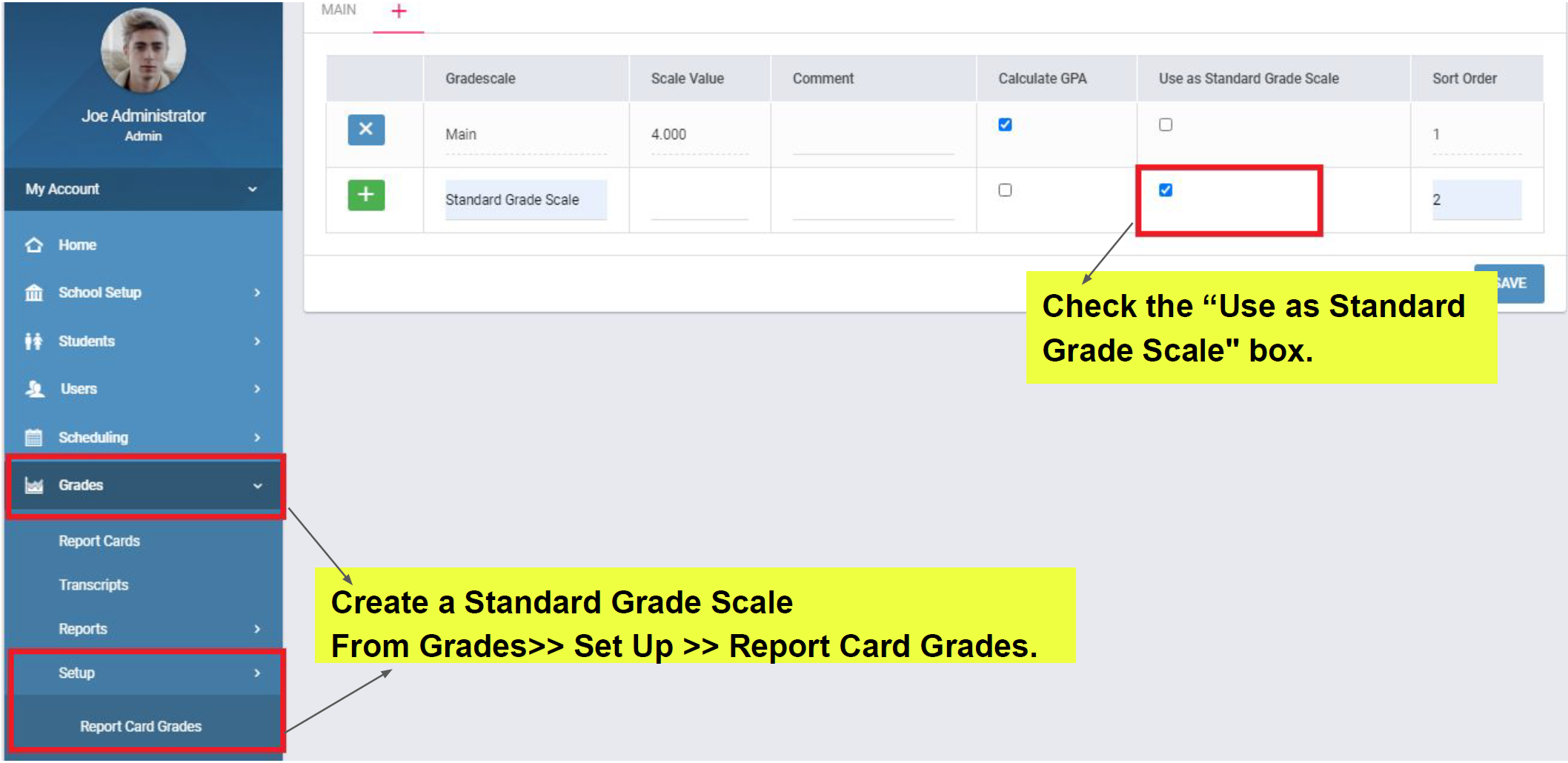
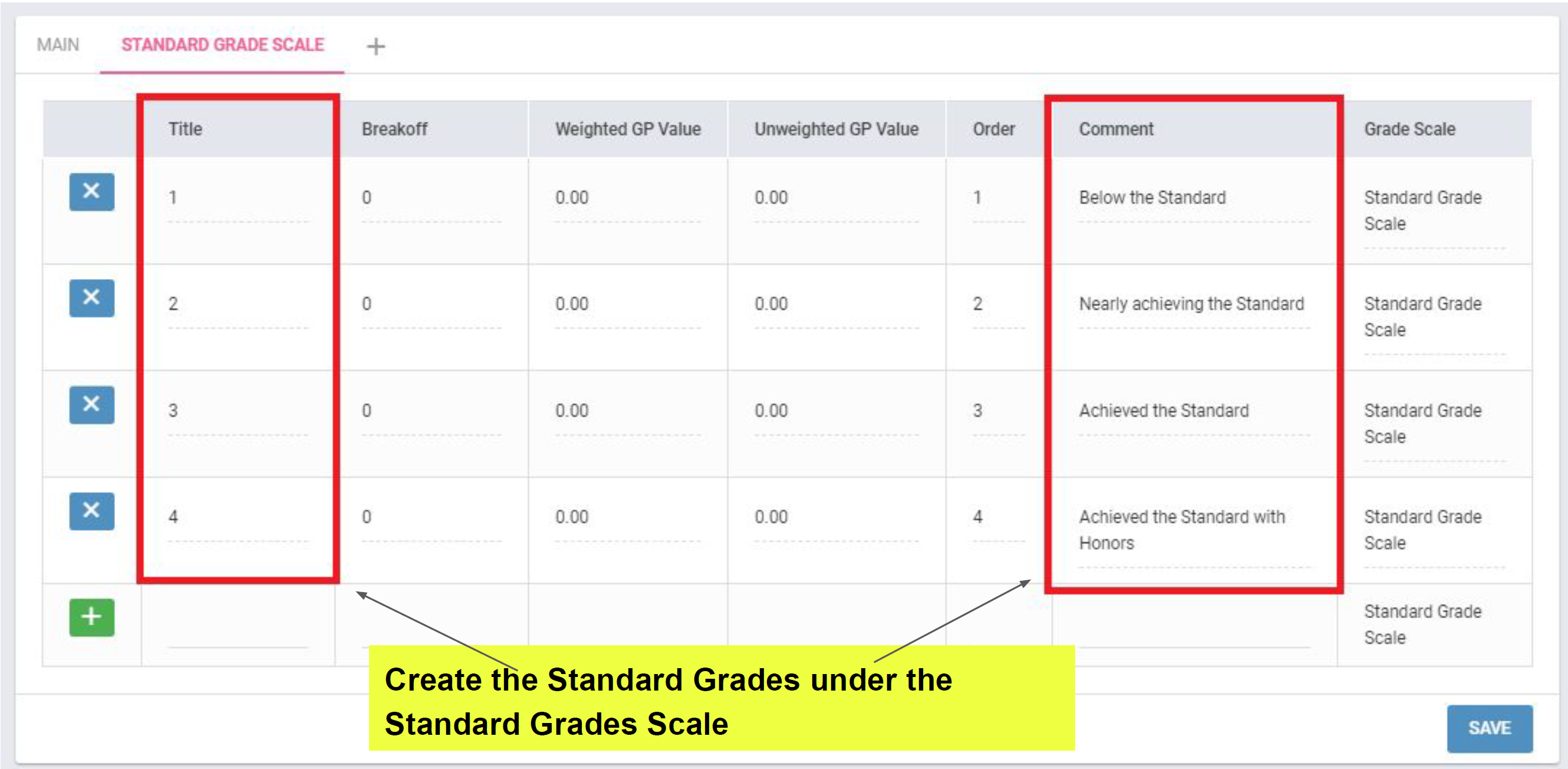
Optionally, you will need to load the US Common Core standard if you need to use them as shown below.
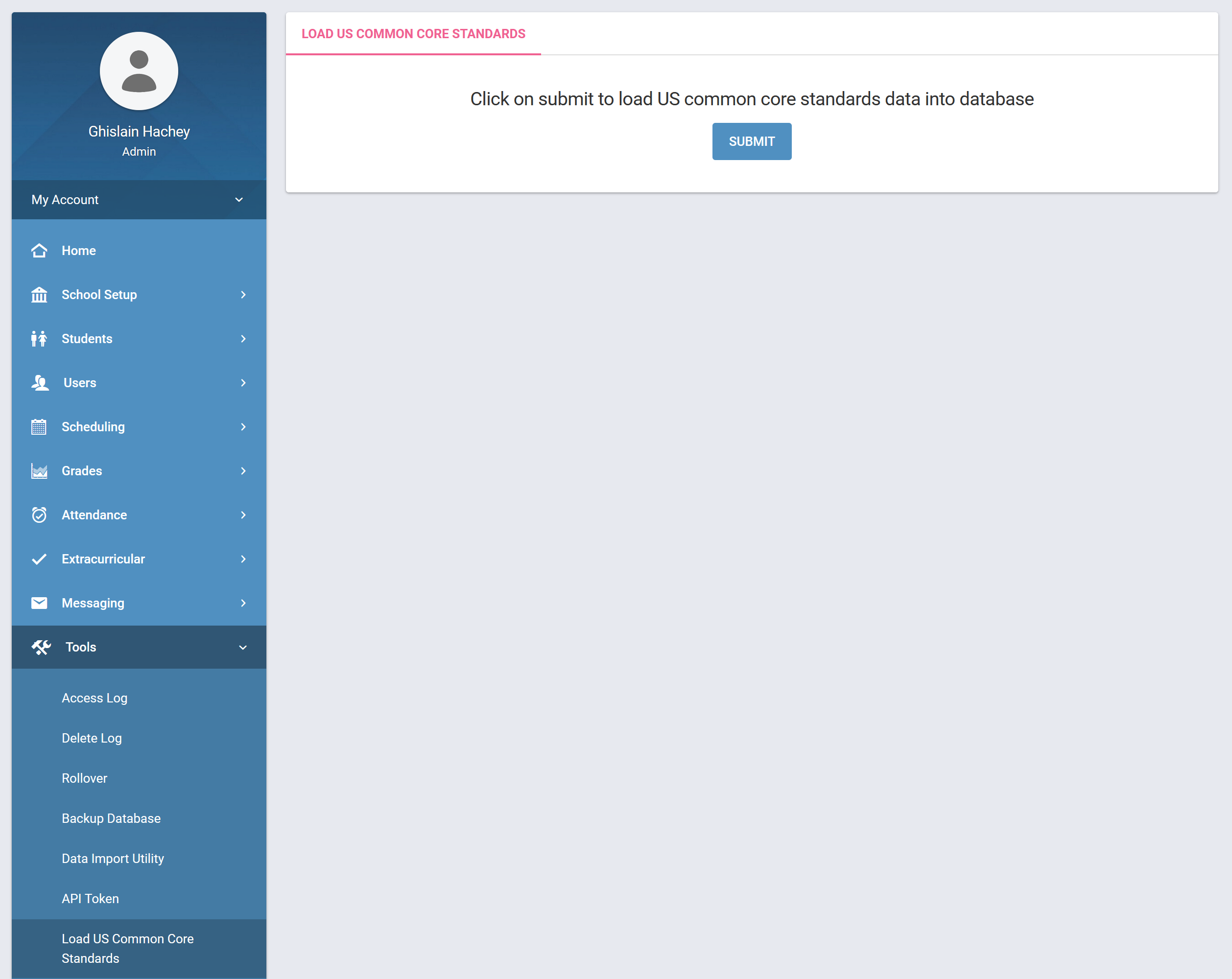
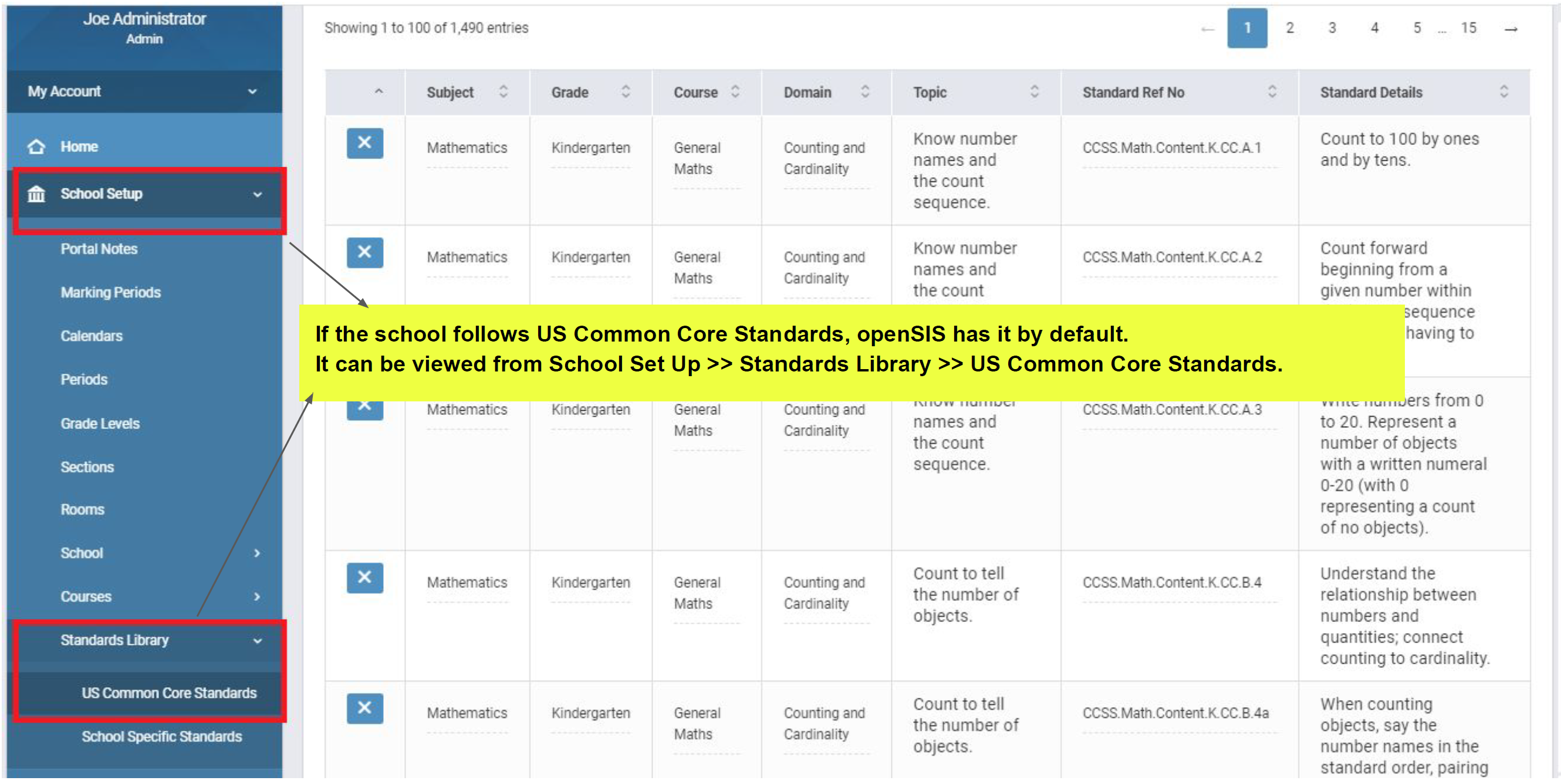
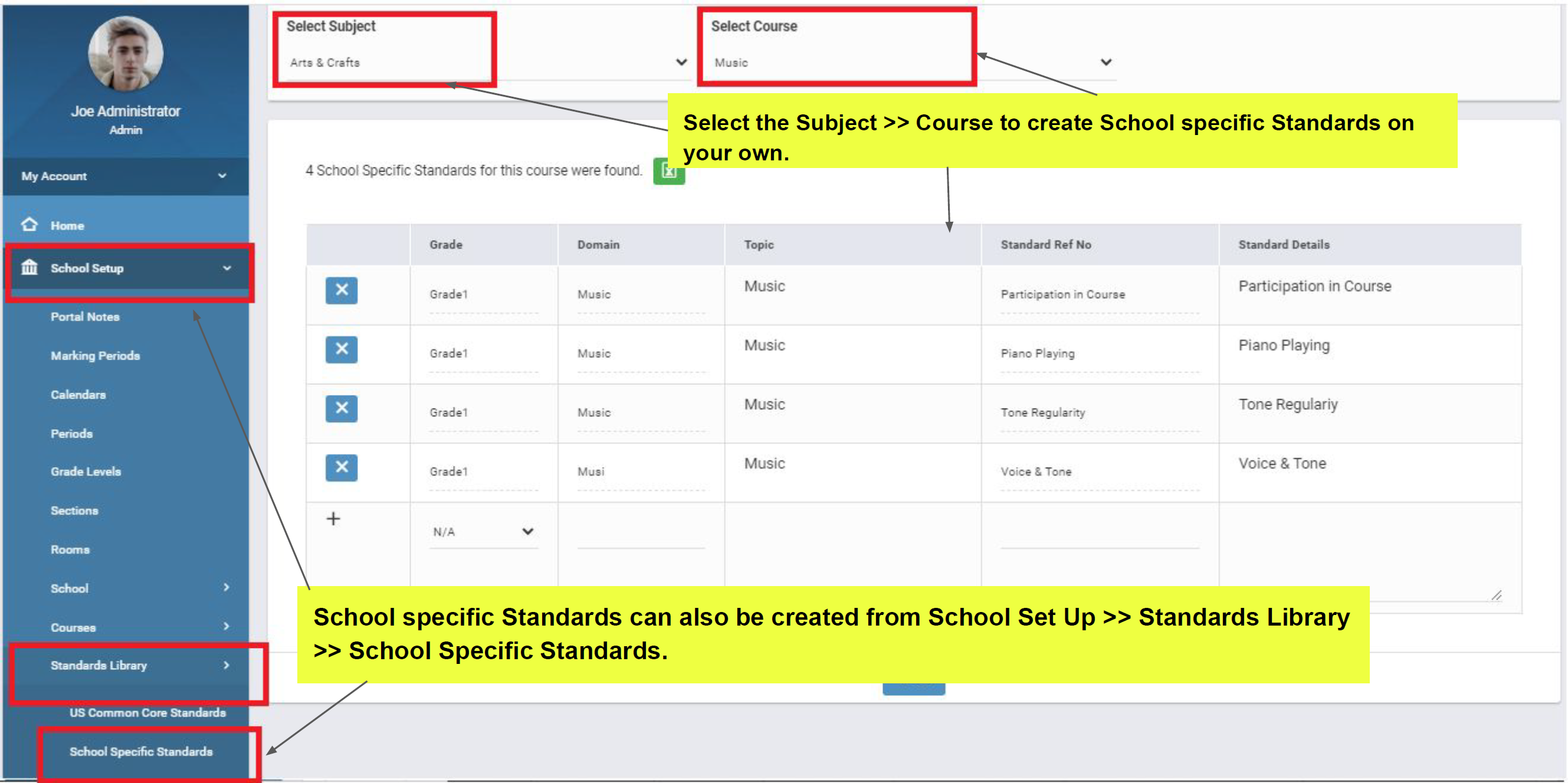
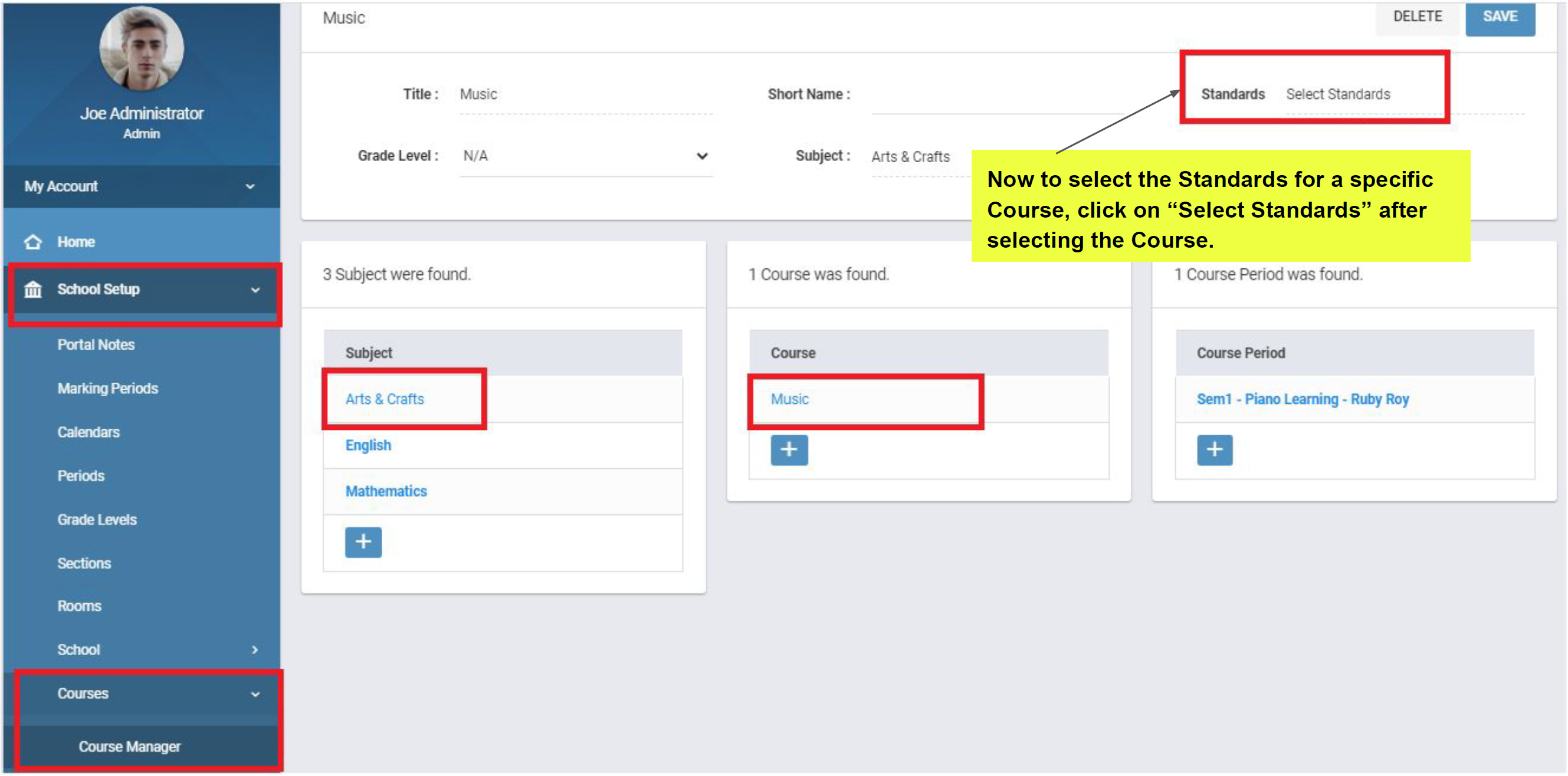
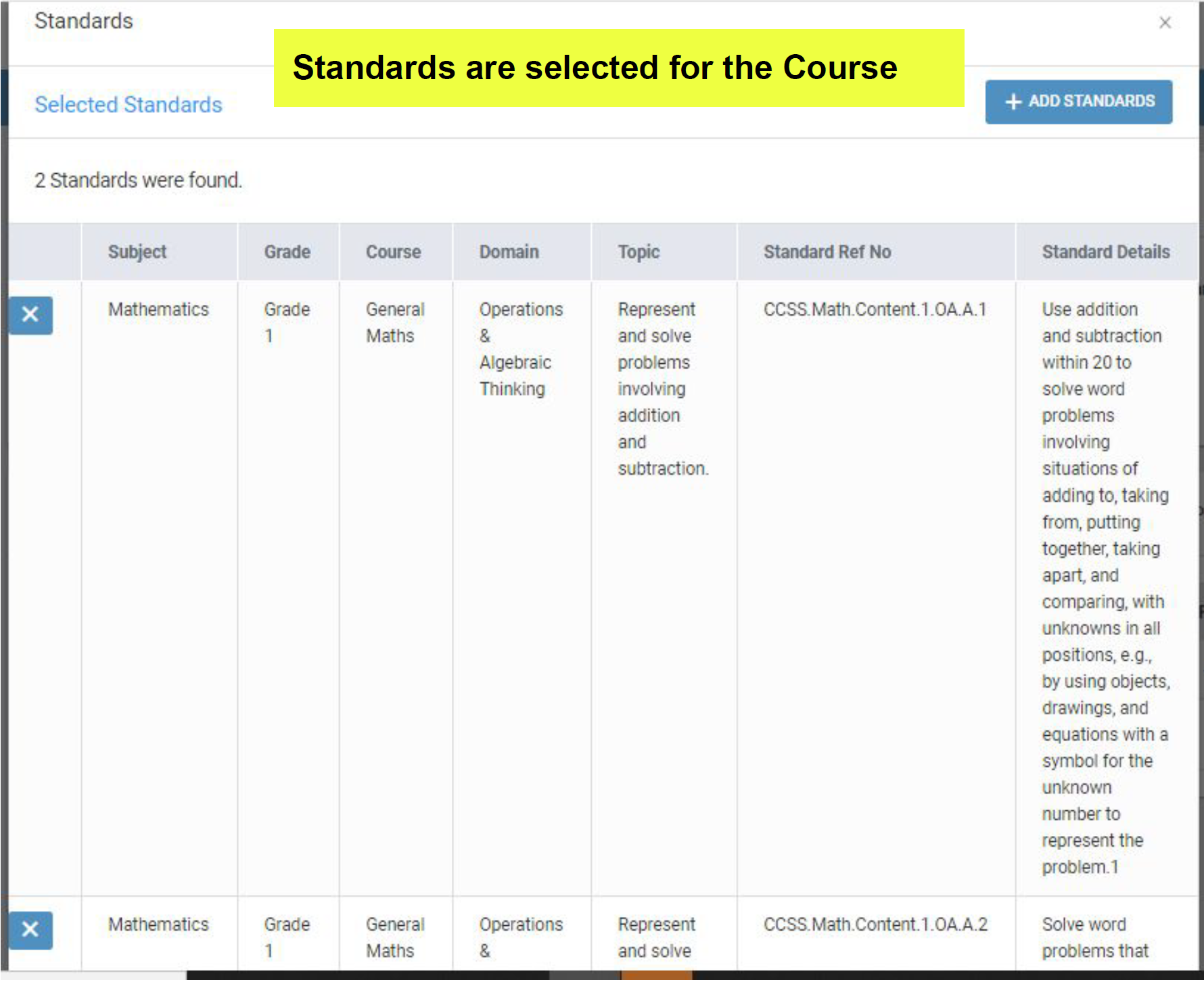

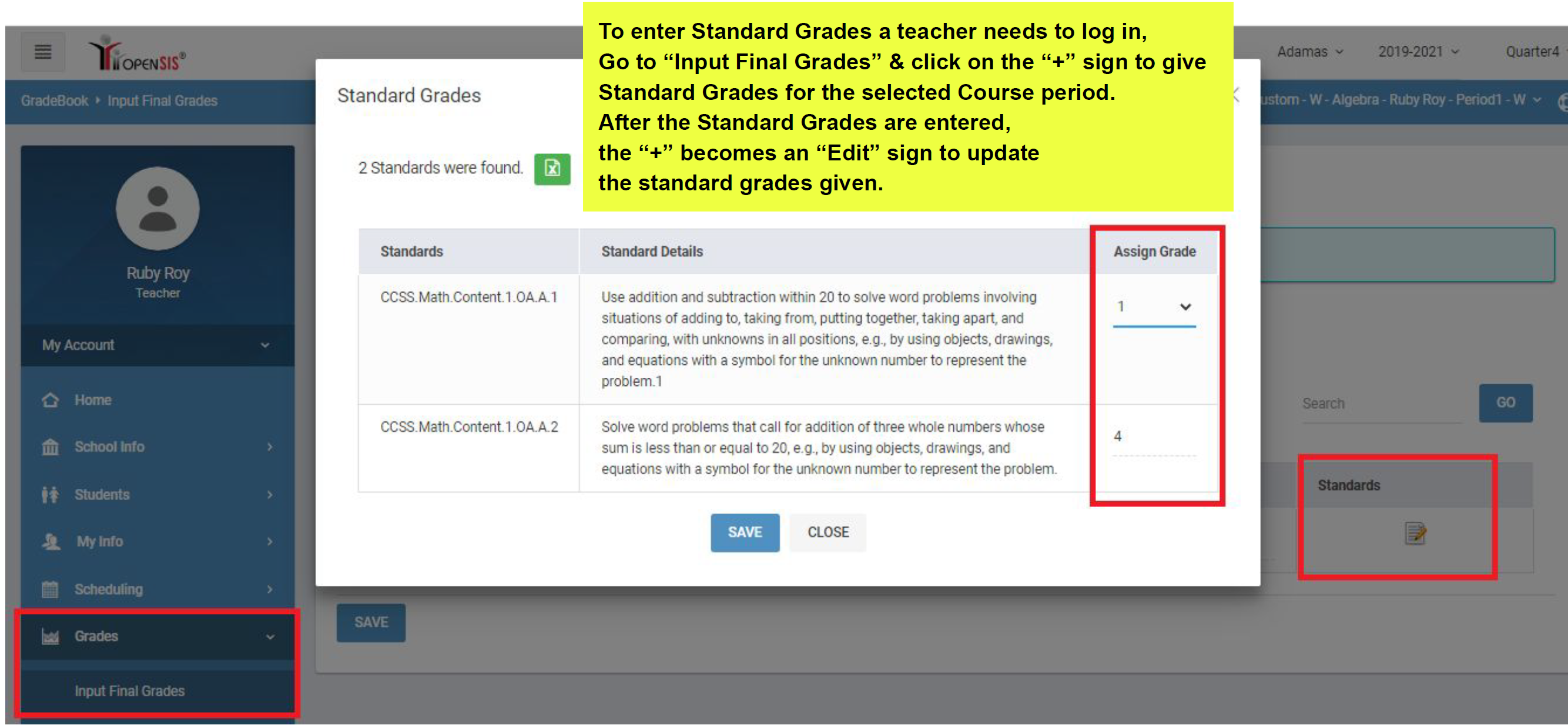


Effort Based Grading
Effort grades are assigned on a scale of one to five, one being the highest. An effort grade of 3, therefore, may be considered an “average” grade. Effort grades are used to rate a student with basic behavior, dress code, attention in class, maintaining proper decorum in school and all the aspects in general. It’s not course specific. It’s used a complete evaluation of a student’s behavioral, moral, and study related aspects.
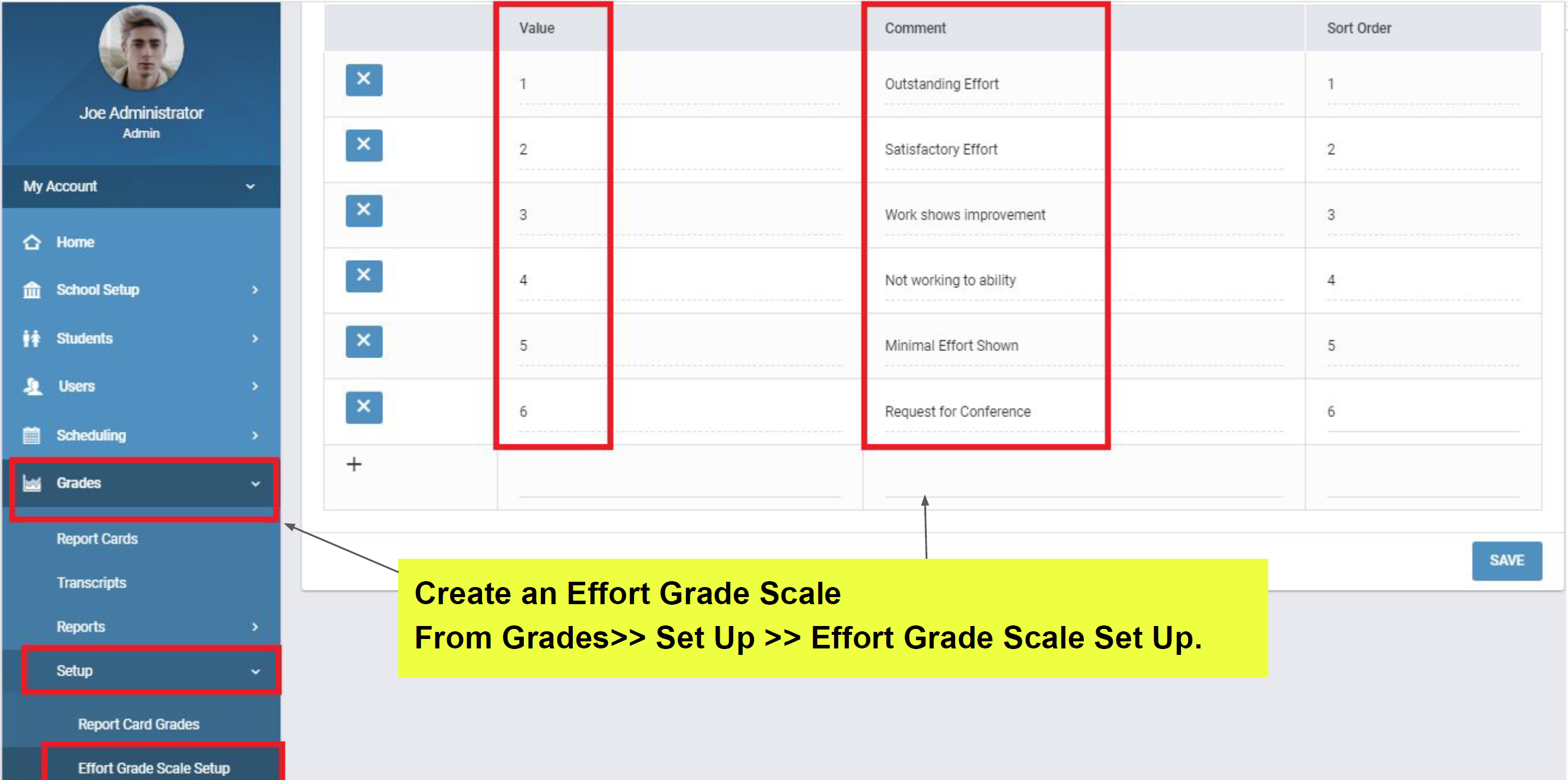

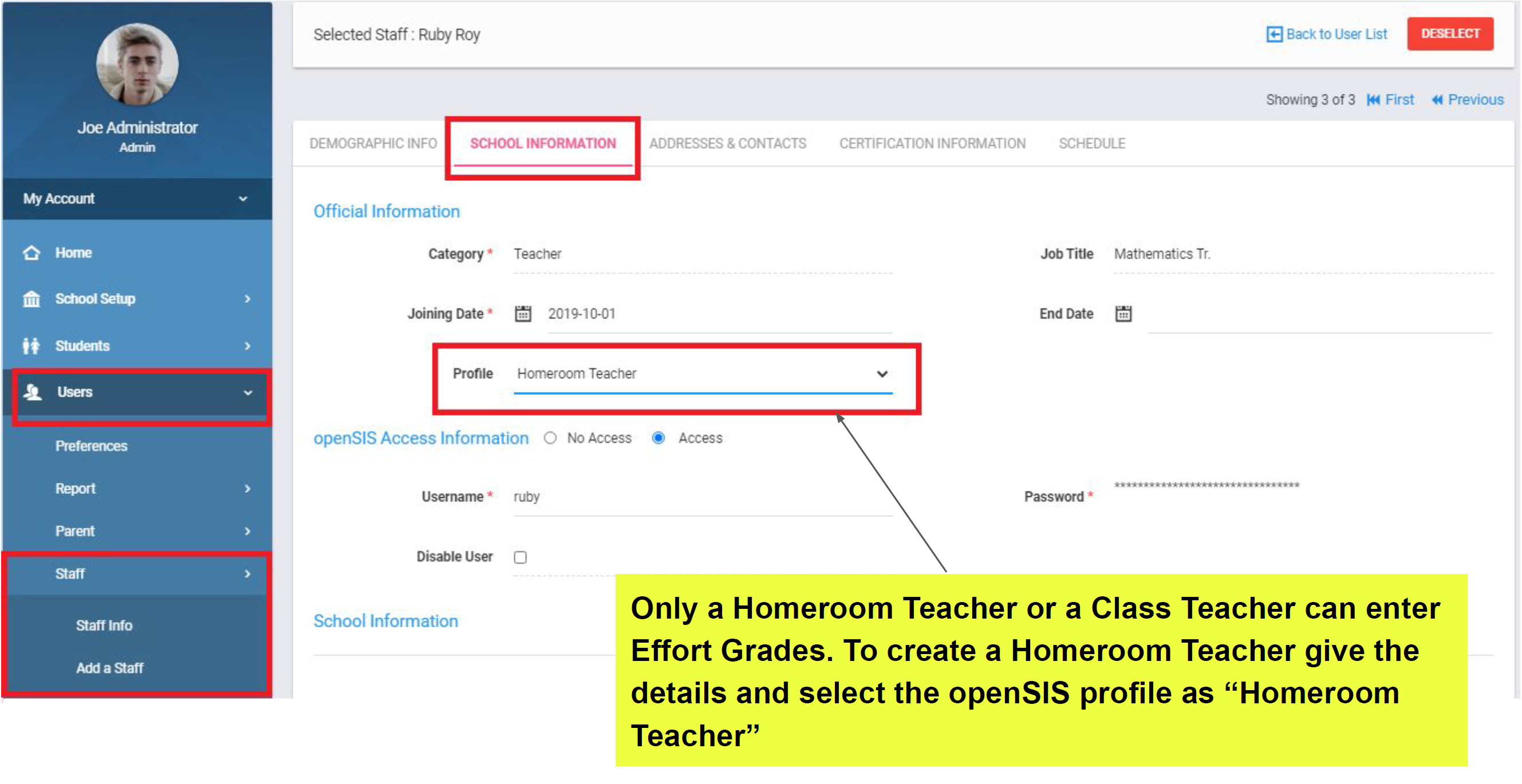

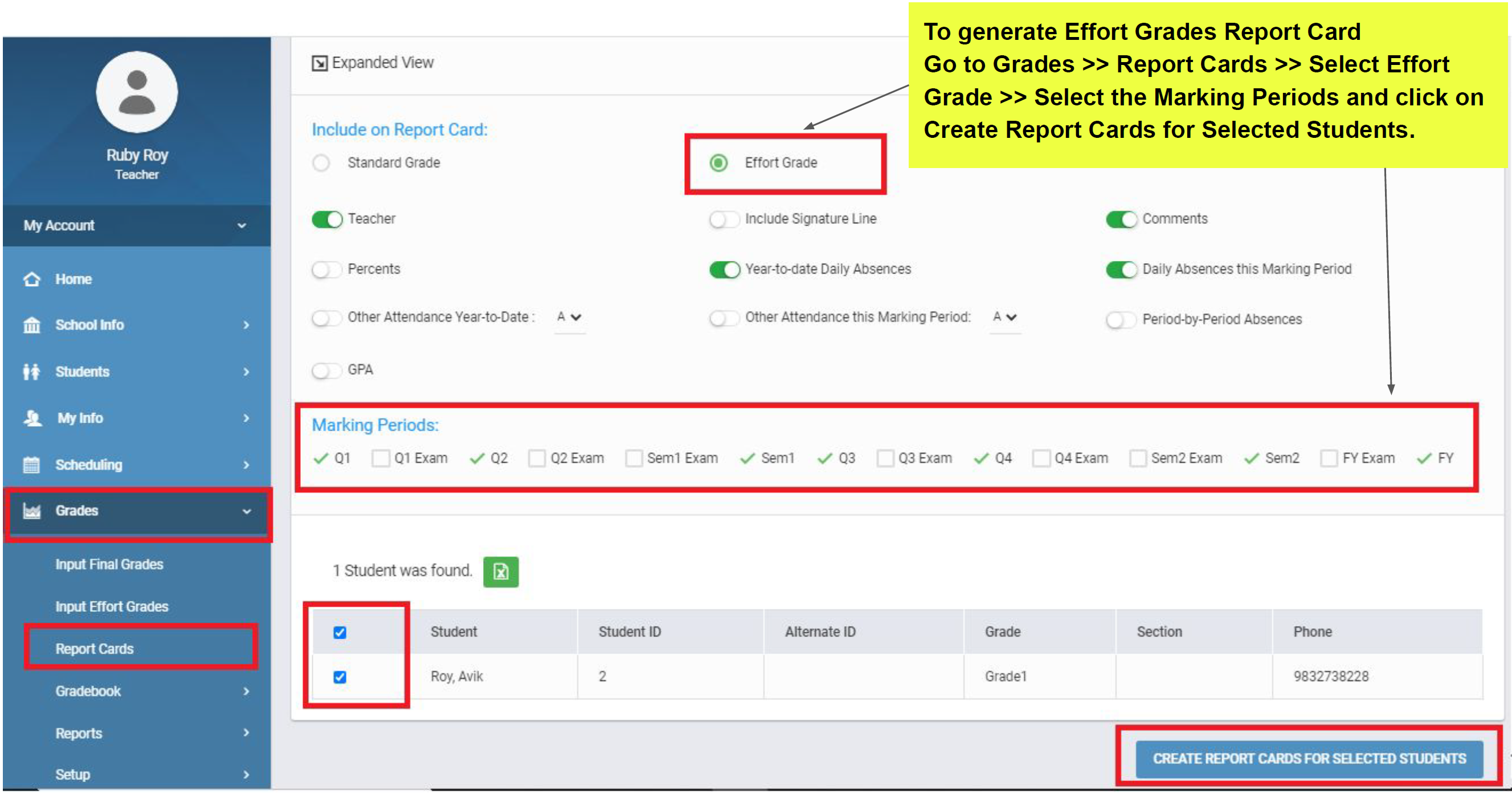

Rollover
Every year you will do through a rollover. This can be done for you. After a rollover you need to setup a new school year.
The following links overview the main things to review and setup.
https://support.os4ed.com/hc/en-us/articles/200976357-Quick-Set-Up
Essentially you need to review
- Any schools details that might have changed (
School setup–>School–>School Information) - Half day and full day minutes for attendance (
School setup–>School–>System Preference) - Review the calendar for this new school year (
School Setup–>Calendars) - Ensure all your marking periods are correct (
School Setup–>Marking Periods) - Ensure all your school periods are correct (
School Setup–>Periods) - Ensure all your grade levels are correct (
School Setup–>Grade Levels) - Ensure all your rooms are correct (
School Setup–>Room) - Ensure all your attendance code are correct (
Attendance–>Setup–>Attendance Code) - Ensure all your Report Card Grades are correct (
Grades–>Setup–>Report Card Grades) - Do your new course periods for this year (
School Setup–>Courses–>Course Manager) - Add any missing teachers (
Users–>Staff) - Add any missing students (
Students) - Schedule students into their course periods
- Mark attendance and final grades as usual
Tools
A number of useful tools are documented here.
Data Import Utility
The data import tool utility can be found in Tools → Data Import Utility. This tool imports data into the system from an Excel sheet and is useful to import lots of data all at once. It is important to use a properly formatted sheet for the import.
The following are certain constraints of using the data import tool:
- All Excel column names should be unique and they should not have space. Replace all spaces with underscore.
- Format all date fields to yyyy-mm-dd and make sure no date field is in simple text (i.e. a date field say contains value like 2018-08-01.) If it’s in simple text it’ll return 2018-08-01 but if it’s in date format it’ll always return a number like 25689. When importing date system converts Excel date to php date but if you send a text value, system will not be able to convert it to the required date format.

- For the student data make sure all the minimum fields are mapped or else you won’t be able to proceed. (First_Name,Last_Name,Gender,Language,Birthdate,Username,Estimated_Grad_Date,Student_Enrollment_Date). Download here a sample template to build your student data file.
- For staff data make sure all the below fields are mapped. (Salutation,First_Name,Last_Name,Profile,Username). Download here a sample template to build your student data file.
- If username and password of staff is not given then system will by default assign “first name + staff id” as username and “first name + staff id” as password. Note that username and password will be in lower case and if name contains any space it’ll be removed with no space.
- If profile of staff to be uploaded is not in the database then system will assign them the profile of teacher.
- If a student’s parent relation is not given system will insert Legal Guardian as the default relation.
When you launch the tool you will see the following.
Click Import Student Data, you will get a screen asking you to navigate to the Excel sheet where the data is. Click on the select file and select the Excel sheet from your computer and click upload.
The system will read the first row of the Excel sheet which has the names of the columns and list them on the left side. On the right side will be the names of the openSIS database columns that are available for mapping.
Now select first name from drop down for the first name option and last name for the last name option. You’ll see a dashed arrow will appear implicating that first name will be mapped to students first name and so on. Below is a screen shot of the same.
When you’re done hit the Map It button at the end of the screen. This will take you to a confirmation step where you can change any mapped value or assign any unassigned value. Below is screen shot of the same.
Now suppose you missed assigning section you will get a chance to do so. Below is an example of the same.
You’re almost done now just hit the confirm button at the bottom of the screen and data will get mapped. You’ll be having a question what if my Excel sheet contains 500 records and after uploading 300 records the server crashes. No worries don’t change anything in the Excel and go ahead uploading the same fields all the same mapped value. System will always ignore any duplicate records and will start from the 301 st record.


